


















On Sunday, I had the privilege of being part of JWLC’s newest initiative, “Everyone Has a Story.” As our community is so vast and so diverse, we wanted to produce a program that would bring community members together to focus on what unites us while acknowledging that we may be different.
As part of the program, three members of the community spoke about their journeys. I wasn’t the only one who was visibly moved by their stories. These women bravely spoke about their backgrounds, their challenges, and their triumphs. It was so compelling to hear about what life was like in Iran fifty years ago or thirty years ago in the Bucharian region of Uzbekistan. What dissimilar lives these women led – one speaking about her family’s connections to the Shah, while another speaking about needing to put on a coat to use the outhouse in the winter, and yet another talking about Super Bowl Sunday in her house growing up – cheeseburgers and all. And yet, as Jewish women, there were so many similarities that connected them –their struggles to connect with Yiddishkeit, their challenges to keep their families intact, their desires to acclimate to the American culture while preserving their own.
As I left the program, and I recounted their stories to my family later that day, I realized that there are two ways to view our differences and our similarities.
You see, there are times you may stand next to someone on line in the supermarket and feel that you are so different from that other person. Perhaps you’re covering her hair and she’s not; maybe she’s wearing stockings and you’re not; maybe her skin is darker than yours; or she’s in the newest fashion and you’re wearing your most comfortable skirt from years ago. On the outside, you’re so different. But if you took that woman and asked her for a few minutes of her time and shmoozed with her, you will soon realize that there are so many ways in which you are the same. There are so many things that unite you. There are so many ways that your lives mirror each other’s.
And then, there are times when, from the outsider’s view, we all look the same. We’re all wearing the same black skirts and sheitels and handbags. We all send our kids to the same yeshivas and camps and go to the same shuls. But when you look a little closer, you realize that we all have our own stories to tell. We each have struggles and challenges and triumphs that are unique to us. We are the same, yet we are so different.
Those similarities that we share, those differences that we possess – they are what make our community the beautiful, brightly colored fabric upon which we build our lives.
Wishing you a wonderful week, Shoshana
Yitzy Halpern, PUBLISHER publisher@fivetownsjewishhome.com
Yosef Feinerman, MANAGING EDITOR ads@fivetownsjewishhome.com
Shoshana Soroka, EDITOR editor@fivetownsjewishhome.com
Nate Davis
Editorial Assistant
Nechama Wein
Copy Editor
Rachel Bergida
Shana Brecher
Lani White
Design & Production

Gabe Solomon
Distribution & Logistics
P.O. BOX 266
Lawrence, NY 11559
Phone | 516-734-0858
Fax | 516-734-0857
Classified Deadline: Monday 5:00PM classifieds@fivetownsjewishhome.com

text 443-929-4003
PAYMENT VIA CREDIT CARD MUST BE SUBMITTED ALONG WITH CLASSIFIED ADS
The Jewish Home is an independent weekly magazine. Opinions expressed by writers are not necessarily the opinions of the publisher or editor. The Jewish Home is not responsible for typographical errors, or for the kashrus of any product or business advertised within. The Jewish Home contains words of Torah. Please treat accordingly.
Friday, May 5 Parshas Emor
Candle Lighting: 7:36 pm
Shabbos Ends: 8:42 pm
Rabbeinu Tam: 9:08 pm

Dear Editor, Rabbi Leo Dee’s call for unity should resonate within the ears of every Jew. When terrorists set out to kill, they do so irrespective of a Jew’s religious observance or political affiliation. When these savage killers ram their vehicles into crowds of innocents, when they bomb civilian targets, their aim is to kill any and all Jewish men, women and children. The tragic events surrounding Rabbi Dee’s family are simply unimaginable and heart-wrenching. We as a people must remain united and be accepting of one another. Our survival demands that we do so.
SP Hersh Lawrence, NYDear Editor, I heard a phenomenal story last week. A baal teshuva who is now a great rav revealed that he couldn’t commit to Judaism until he ridded himself of all his negative traits, which took three years. I sometimes think three months is an impressive time to work on a middah, but three years is extraordinary. This exemplifies the fact that bad behavior and the Torah repel one another. For most, breaking middot is a lifetime of work that never stops. One can be ninety-nine and consumed by anger requiring them to introspect.
Rabbi Biderman, shlita, has a famous Torah thought that applies to this time of the year. He notes that Sefirat HaOmer is the middle mitzvah of the Torah, meaning it stands at the center of importance. During Sefira, we learn Pirkei Avot, and

this is a time of breaking middot. Who we are is just as important as how much we know.

When it comes to knowledge versus middot, the purity of our heart, Rashi in Sanhedrin (106b) uses a unique language to characterize G-d, saying, “Rachmana liba ba’ei – G-d desires the heart.” The heart personifies love, but what kind of love? In sefer Shmuel Aleph (17:32), Dovid HaMelech tells Shaul to “not let his heart fall.” Love where your heart falls is a deep kind of love, the type of love the Rambam discusses (Laws of Teshuva 10:3), a love of infatuation with G-d. This explains the language of Rashi, referring to the G-d who desires our heart as Rachmana, a G-d of mercy who wants a reciprocal relationship of love. And Rachmana connotes a G-d of mercy who treats us with compassionate attributes, an inspiration to push us to be like him, “Ma hu rachum v’chanun, af ata rachum v’chanun - Just as Hashem is merciful and compassionate, so too, you should be merciful and compassionate.” (Shabbos 133b).
Steven GenackIn 1968, when CBS Evening News anchor Walter Cronkite declared that the Vietnam War was unwinnable, President Lyndon B. Johnson knew that he had lost the support of middle America. He subsequently announced that he would not run or accept his party’s nomination for a second term. The New York Times and many media commentators across
Continued on page 10
Would you rather have a terrible boss but a great job or a great boss but a terrible job?
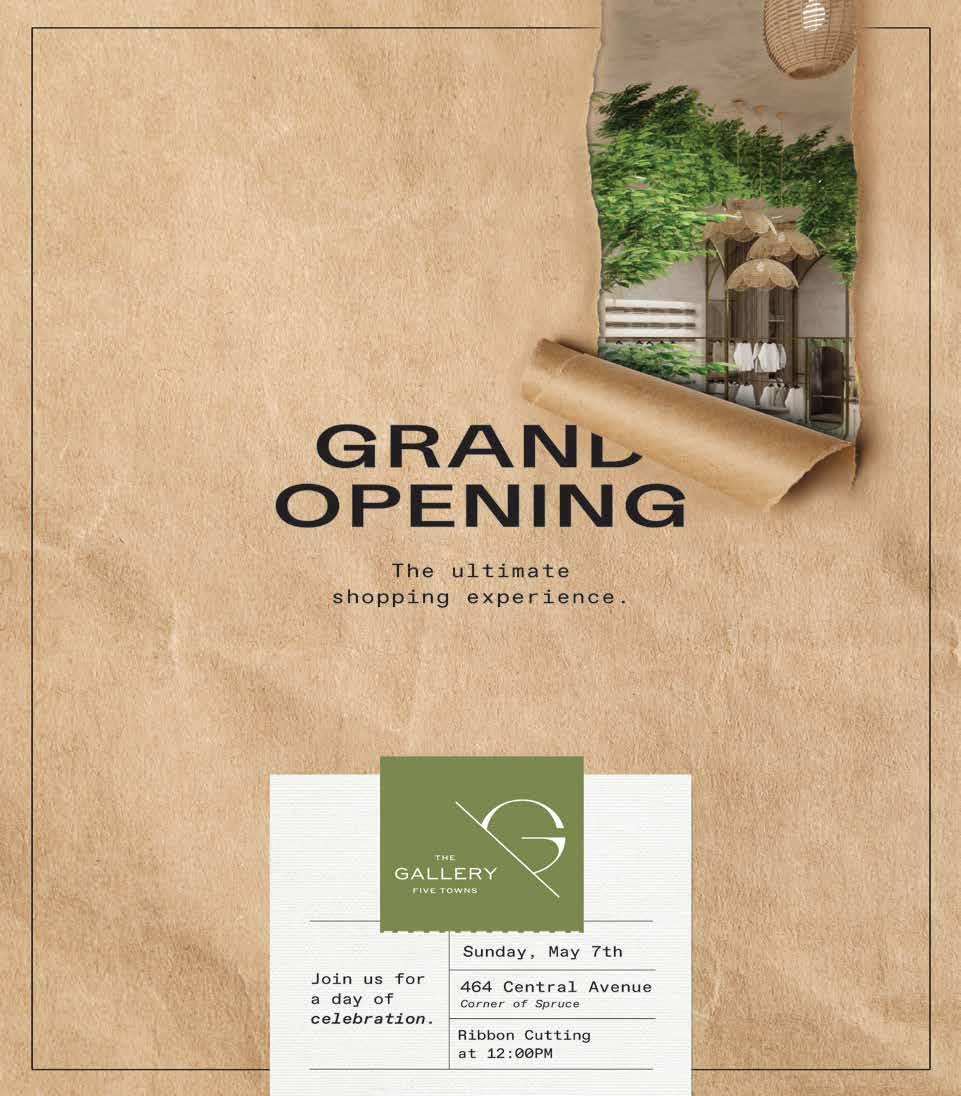
Continued from page 8

the political spectrum have questioned President Joe Biden’s announcement of a re-election bid for a second term. He should heed the words of Kenny Rodgers in the Gambler, “You’ve got to know when to hold’em, know when to fold them, know when to walk away and know when to run.”
Sincerely,
Larry Penner Great Neck, NYDear Editor,

I appreciated your interview on the topic of AI and the future of ChatGPT and the like. And although there is so much speculation, there is a lot of uncertainty and anxiety surrounding this topic. True, the business that does not understand that AI is here and does not utilize it to better its business might as well close its doors. But there are many people won-
dering right now if these robots will be replacing them in their positions. Are their jobs going to become obsolete?
There are many people who had those same anxieties years ago, when computers came about. Think about those accountants who were told that computers are going to be doing their calculations for them. Perhaps they were worried for their jobs. And yet, there are still accountants today, although now they utilize computers to help them function in their positions. The same is true of many other professions.
Part of anxiety is being worried about the future – of which we don’t have control. For now, it’s best to be aware that AI is here. And it’s best to use it to help us. What may come in the future, we may not know. But to worry about it? Well, maybe you can let your AI device do the worrying for you.
Rachel Shemtov
di Royal Navy fleet is shuttling back and forth across the Red Sea, there are more people wanting to flee than there is room on the ships.
Those who remain trapped in the country are facing dire circumstances. There are bodies laying in the streets. They are suffering from shortages of food, water, electricity, and medical equipment.
Thousands have fled Sudan since fighting broke out between rival military forces more than two weeks ago. For some, the journey of 800 miles to the port from the capital of Sudan took days. And still, some have not been able to escape to safety.
Hundreds have been killed and thousands wounded in the fighting. Thousands of foreign nationals have been evacuated from the country, while many Sudanese remain stuck in deteriorating and deadly conditions.

And as fighting has driven more people out of Khartoum, the capital, Port Sudan has become a key evacuation hub.
The UN’s internationally-recruited staff have relocated to the eastern city and thousands are in a holding pattern, hoping for flights out.
Over the weekend, the United States began to evacuate private U.S. citizens from Sudan, with at least two convoys arriving at the port.
Faris Asad, the US Consul General in Jeddah, told CNN that 100 Americans were among the people who had arrived in Saudi Arabia on Monday morning on the USNS Brunswick ship, a fast transport vessel that has a military and civilian crew.
As of Sunday, the Saudis said they had evacuated 5,197 people of 100 nationalities from the country.
“The assets and the capabilities –both military and civilian – in Saudi are involved in taking civilians from Sudan,” Defense Ministry spokesman General Turki Al-Maliki said. “As long as it’s safe, we’ll keep doing our role.”
The journey from Port Sudan to Jeddah can take up to 12 hours depending on sea conditions. Though the Sau -
On Monday, Turkey released new details about the operation to kill Abu Hussein al-Qurashi, the leader of Islamic State, in which the terrorist killed himself by setting off a suicide vest to avoid arrest.
President Recep Tayyip Erdogan announced on Sunday the death of the “suspected leader of Daesh, codename Abu Hussein al-Qurashi.”

Turkey’s Anadolu state news agency gave his full name as Abu al-Hussein al-Husseini al-Qurashi, saying he joined IS in 2013 and quickly rose through the jihadist group’s ranks.
Turkish media also released images of a fenced-off building in the middle of a field where it said Qurashi was hiding in Syria’s Afrin province. The house is shown with part of it shorn off, ostensibly from the blast.
The Islamic State announced the death of its previous leader, Abu Hasan al-Hashimi al-Qurashi, on November 30.
Turkey’s MIT intelligence agency had conducted a four-hour operation during which it located and surrounded al-Hussein al-Husseini on Saturday. MIT agents blasted apart a stone wall that surrounded the house, before entering it through a rear entrance and side windows. But before agents were able to nab the terrorist, he set off a suicide vest, killing himself.
Turkey has deployed troops in northern Syria since 2020 and controls entire zones with the help of Syrian proxies. Despite having been driven out of much of the territory it once controlled, Islamic State still launches attacks in Syria.


death.
Last year, Sugarman reached Camp 3 on Everest before abandoning a climb. He had lived in Seattle and was a doctor.
This year’s spring climbing season on Everest had a tragic start last month with the death of three Nepali climbers. The trio were crossing the treacherous Khumbu icefall as part of a supply mission when a block of glacial ice fell and swept them into a deep crevasse.
More than 600 climbers are aiming to summit other Himalayan mountains this season.
The fourth fatality of this climbing season on Everest was a U.S. mountaineer.
Jonathan Sugarman, 69, was on an acclimatization rotation at around 21,000 feet on the world’s highest peak when he died on Monday.

“He was feeling unwell and passed away at Camp 2. Efforts are underway to bring (back) his body,” Pasang Tshering Sherpa of Beyul Adventure said. “We are trying to send a helicopter, but it is snowing and the weather is not favorable,” he said.
Beyul Adventure is a local partner of U.S.-based expedition organizer International Mountain Guides, which confirmed “with deep sorrow” Sugarman’s
Nepali guides – usually ethnic Sherpas from nearby valleys – are essential to the multimillion-dollar industry, bearing huge risks to prepare climbing routes and carry food and equipment.
Nepal has issued 466 permits to foreign climbers, and since most will need a guide, more than 900 people will try to summit this season, which runs until early June.
This could result in heavy traffic and bottlenecks en route to the summit, especially if there is a shorter climbing window because of unfavorable weather.

On average, around five climbers die every year on the world’s highest peak.
Nepal is home to eight of the world’s 10 highest peaks and welcomes hundreds of adventurers each spring, when temperatures are warm and winds are typically calm.
Chess is considered the ultimate game of cold, logical calculation, but it is also a game of passion and, at the highest level, of nerves. That was clear Sunday when the world championship match in Astana, Kazakhstan, ended with Ding Liren, the new champion, sitting at a board by himself in a darkened theater, his head in his hand, crying tears of joy.
Ding’s victory came in a tense and gripping rapid-play finale against Ian Nepomniachtchi of Russia, and only after three weeks of slower-paced games that had failed to produce a winner. The result made Ding the first man from China, a rising power in chess, to hold the world championship, simultaneously preventing Russia from reclaiming it.

Ding’s match against Nepomniachtchi was decided in a series of four tiebreaker games made necessary after the regulation portion of the match, 14 grueling classical games, ended in a tie. Each player won three games in the regulation portion; the other eight ended in draws.
The tiebreakers, all played Sunday, were faster games in which each player had 25 minutes at the start, with 10 seconds added every move. The first three games were draws, but each one was highly tense and hard-fought.
In Game 4, Nepomniachtchi, playing white, repeated the opening he had tried in the second game of the tiebreakers. On move 13, he tried a new idea, but Ding — capitalizing on its defects — soon seized the upper hand.
Still, the game seemed headed for a draw when Nepomniachtchi, with more time left on his clock, decided to make the game more complicated to see if he could force Ding into a mistake. Instead, it was Nepomniachtchi who cracked, making critical errors that allowed Ding to take control. Nepomniachtchi resigned on move 68.
It was the first and only time that
Ding led in the championship match. He earned $1.1 million for his victory, while Nepomniachtchi won $900,000 as the runner-up.
The match had been overshadowed from the start by the absence of Magnus Carlsen, the Norwegian grandmaster who had held the world title since 2013. Carlsen voluntarily chose to relinquish the crown last July because he had grown weary and bored of preparing for the matches, a process that takes months. (© The New York Times)
Severe fuel shortages have forced Cuban authorities to cancel the widely celebrated International Workers’ Day parade, which had been set for Monday. The event typically draws hundreds of thousands of people dressed in red, waving flags and banners in support of socialism and the Cuban Revolution.
But Havana’s Revolution Square, which features a giant statue of the island’s national hero, José Martí, will look nothing like that this May Day.
In recent weeks, Cuba has struggled with fuel shortages across the island caused by supplier nations not delivering, according to its president. The country’s weakened economy has also made it difficult for the government to import its own diluents to refine the low-quality crude oil it receives or to purchase higher-quality crude that requires less refining.
Cuba usually consumes between 500 and 600 tons of fuel daily, President Miguel Díaz-Canel said this past month. Now, he said, the island has less than 400 tons a day.

“We still don’t have a clear idea of how we are going to get out of this,” DíazCanel said.
Although the main May Day event in the capital has been canceled, Ulises Guilarte, head of the Workers’ Central Union of Cuba, said last week that celebrations would still take place in local communities, schools and workplaces under conditions of “maximum austerity.”

Given the heavy rains and strong winds in Cuba on Sunday, however, even some of these smaller events may end up postponed as well.
For the past month, Cubans have experienced acute fuel shortages that have crippled the island’s already suffering economy.
Traffic has ground to a halt. Milelong lines have sprung up at gas stations, with some drivers even sleeping in their cars. Taxi drivers charge exorbitant fees. Some universities have gone back to online classes. Restaurants and bars have been losing clients. The National Theater of Cuba in Havana even called off a concert by the national symphony orchestra because of the lack of fuel.
Now, Cuba has canceled the May Day parade.
The last time the parade was canceled was in 2021, at the height of the coronavirus pandemic.
Díaz-Canel has denied that the crisis is a result of Cuba’s inefficiencies or state-owned institutions. He has instead attributed it to countries — such as Venezuela — that “have not been able to fulfill their commitments” because they “have also been in a complex energy situation,” he said. (© The New York Times)
ner, a private company whose fighters have minimal training and little leadership.
Kirby lambasted a recent assertion from Wagner leader Yevgeny Prigozhin, who said Sunday that his group had only suffered 94 casualties. Kirby called Prigozhin’s comments “just a ludicrous claim.”

Kirby said the U.S. does not have figures on Ukrainian casualties.

The war in Ukraine has had devastating outcomes for both sides. This week, the Biden administration released figures announcing that Russia has suffered more than 100,000 casualties since December, a sobering statistic that highlights how Russia’s winter offensive backfired on the giant.
White House official John Kirby told reporters that Russia has “exhausted its military stockpiles and its armed forces” and that the U.S. estimates more than 20,000 of its troops have been killed in action in recent months.
The U.S. is defining the term “casualty” as both wounded and killed.
According to Kirby, nearly half of those casualties were fighters from Wag-
He added that the Ukrainians “are the victims here, Russia is the aggressor, and I’m simply not going to put information in the public domain that’s going to, again, make it any harder for the Ukrainians.”
Kirby also said that “most” of Russia’s efforts have “stalled and failed” as the battle for the eastern city of Bakhmut continues. He added that Russia has made “incremental” gains in the town that has “very little strategic value.”
“The bottom line is that Russia’s attempted offensive has backfired. After months of fighting and extraordinary losses, Russia continues to be focused on a single Ukrainian city with limited strategic value,” the official said.

Police in Mexico said this week that they have arrested a top lieutenant of the violent Metros faction of the Gulf drug cartel implicated in 23 attacks on police and nine against military personnel. The suspect was identified as Hugo Salinas Cortinas, whose nickname “La Cabra,” means The Goat. He was arrested last Friday.
Salinas Cortinas was caught with two guns and 600 pills, apparently fentanyl. He allegedly headed up drug and migrant smuggling along a stretch of the Mexican side of the Rio Grande river, also known as the Rio Bravo.
La Cabra allegedly operated in a territory comprising the towns of Camargo and Miguel Aleman, across the border

from the Texas towns of Rio Grande City and Roma.

The Gulf cartel has splintered into warring factions following the arrest and extradition of some of its top leaders over the decade.
cause of bad browsing habits. People who keep open a lot of tabs and browser windows, including ads and pop-up windows, were more likely to stress out
“People easily forget what they were looking for. Our concentration lapses when interesting things appear on screen, and then we start following links and collecting tabs,” Lindqvist explains in a university release
live a meaningful and good life despite computers.”
Study authors presented the research at the 2023 CHI 2023 Conference on Human Factors in Computing Systems.
gram at the charitable organization Oxfam. “It cannot cover basic needs in Hong Kong.”

The new minimum wage now stands at 40 Hong Kong dollars ($5.10) per hour, up from the previous 37.5 Hong Kong dollars ($4.78) per hour.
A new study finds that having too many tabs open on your browser may make people stressed and overwhelmed.

“We began exploring which challenges make users feel overwhelmed when browsing the internet. We also mapped the behaviors that cause the clutter and how users react to the stress,” explained study co-author Janne Lindqvist, an associate professor at Aalto University in Finland.
One of the reasons why people have so much junk on their computers is be -
Multitasking is another issue of computer clutter. When the tabs involve different activities — online gaming, research, or booking a restaurant reservation — people were more hesitant to close tabs and also had trouble completing complex tasks. Lindqvist likens it to a kitchen table that doubles as a dining table, a play table, and a desk for children to do homework. The difference is all those activities are piling up on the table, leaving little room to complete each one efficiently.
One way to get out of this conundrum is to give yourself a maximum amount of tabs that you can keep open on your computer at one time.
“We use computers every day, and it’s definitely not always ideal. Many things would actually be much better handled only on paper,” says Lindqvist. “I look at this from the point of view of how we can

The minimum wage, first established in 2011, is supposed to be reviewed every two years — but it was frozen at the previous rate in 2021 due to the city’s Covid-stricken economy, with authorities at the time arguing that a wage increase would put “additional pressure on enterprises” and risk slashing low-wage jobs.
Hong Kong may be one of the world’s most expensive cities, but it’s becoming almost impossible for minimum wage workers to afford living there. In a city where parking spaces can go for nearly a million dollars each, the government raised the minimum wage this week by a scant 32 cents.
“We think this is unacceptable,” said Wong Shek-hung, director of the Hong Kong, Macau and Taiwan pro -
In 2022, Hong Kong tied with Los Angeles for fourth place on the Worldwide Cost of Living Index, released by the Economist Intelligence Unit (EIU). New York, Singapore, and Tel Aviv sit at the top three spots.
By comparison, New York has a minimum wage of $15 per hour, and Los Angeles has $16.78 per hour; Tel Aviv ranges from $8.27 to $8.45 per hour depending on the total hours worked. Singapore offers different minimum wages depending on sector, applicable only for citizens and permanent residents.
The new wage is still lower than what
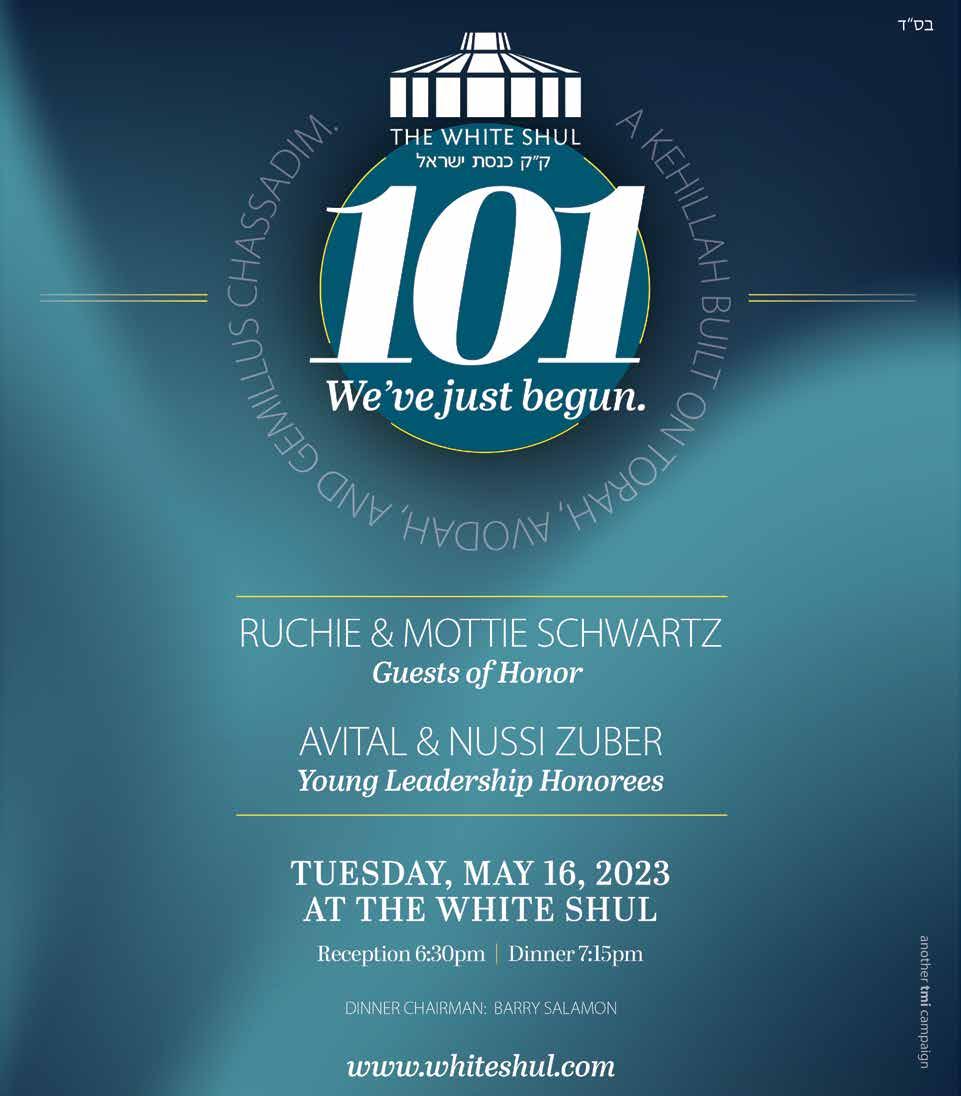
a family of two would receive through the city’s social security program and would demotivate workers. Some have urged the government to raise the minimum wage to at least 45.4 Hong Kong dollars ($5.78) an hour, calling the new increase “almost negligible.”
But Hong Kong’s Secretary for Labour and Welfare Chris Sun rejected this argument in January, claiming that “many people…would rather work than receive social welfare because they think it has more value in their lives.”
“After all, do people like to go to work or not? In fact, going to work is not just for earning money. It is important to one’s spirit and health,” Sun said, according to public broadcaster RTHK. “So the two can’t be compared. One is welfare, the other is work.”
The minimum wage does not apply to foreign domestic workers — a crucial part of the city’s economic and social fabric, who are from countries like the Philippines and Indonesia and are required by law to live in their employers’ households.

Most people making minimum wage work in the sanitation, cleaning, security and retail sectors. Only 2.6% of employees earned less than $40 an
hour in 2021, compared to 6.4% in 2011.
Food costs have increased by more than 7% from December 2019 to December 2022; energy costs rose by more than 11% during that same time.
“This is a very heavy burden for those low-income families,” said Wong.
The senior leader of the Palestinian Islamic Jihad terror group was found unresponsive in Nitzan jail. He was taken to the hospital and underwent resuscitation efforts, but was declared dead at the hospital.

Adnan, 45, was arrested in February in his hometown of Arrabeh, in the northern West Bank near Jenin, for suspected membership in a terror group, support for a terrorist organization, and incitement. He had been indicted and was being held in custody until the end of the legal proceedings against him.
He launched his hunger strike immediately after his arrest on February 5 and had refused to undergo medical checks or receive treatment while incarcerated.
Shortly after he died, rockets were fired from Gaza at Israel.
Adnan had long been accused of being a spokesperson for the terror group and had been arrested several times in recent years and served several prison sentences in connection with his work for Palestinian Islamic Jihad. This was the tenth time he had been incarcerated.
He had also previously gone on hunger strikes several times over his detentions, including over an arrest in 2018. In that case, he was convicted of having been an active member of the
banned Iran-backed terror group after he pleaded guilty in a plea bargain.
In 2012, he went on hunger strike for 66 days in protest against a term of internment without trial, what Israel calls “administrative detention.”
In 2015, he went without food for over 50 days after another arrest.
In response to the rockets being fired from Gaza, Israel carried out tank strikes toward the Strip.
A foreign national was injured from one of the 22 Palestinian rockets launched into Israel.
Israel launched airstrikes against the airport in the northern Syrian city of Aleppo on Monday night, rendering the

airport useless and killing one soldier and leaving seven others wounded, Syrian state media reported.
SANA reported that Syrian air defenses responded to the Israeli incursion, claiming to have downed several missiles. Those assertions could not be verified.
There have been a number of alleged Israeli strikes in Syria in recent weeks, including against targets near the western city of Homs on Saturday, and sites near the border with the Golan Heights on April 24 and April 19.
Israel is alleged to have carried out a number of strikes in Syria last month, including one that killed two members of Iran’s Islamic Revolutionary Guard Corps. After that strike, a suspected Iranian drone launched from Syria was brought down over Israeli airspace.
Several days later, six rockets were launched from southern Syria at the Golan Heights in two separate barrages hours apart, with three landing in Israeli territory, the military said. The IDF responded with artillery strikes in response to the rocket attack.
Aleppo International Airport was hit with two separate airstrikes attributed to Israel in March and forced to shut its runway for several days following the pair of attacks. A similar attack in September forced the airport to close for a number of days.
Last August, Syria accused Israel of being behind two consecutive airstrikes at Aleppo International and a site near the Damascus Airport, as Israel was said to be ramping up its efforts to target airports to counter Tehran’s growing use of commercial flights to bring military supplies into the country.
vite the Israeli leader to meet with Congress.
The Republican lawmaker landed in Israel on Sunday for a two-day visit that included an address to the Knesset on Monday.
“If [an invitation to the White House] doesn’t happen, I’ll invite the prime minister to come meet with the House. He’s a dear friend, as a prime minister of a country that we have our closest ties with,” McCarthy told the newspaper.
On Sunday, on a visit to the Holy Land, Speaker of the U.S. House of Representatives Kevin McCarthy said that if President Joe Biden does not invite Prime Minister Benjamin Netanyahu to visit the White House soon, he would in-

In an interview with the Israel Hayom newspaper, McCarthy addressed Biden’s ongoing refusal to welcome Netanyahu to Washington, amid disagreements over the government’s planned judicial overhaul.
McCarthy joked that Biden had also not been speaking with him for the past few months, and therefore Netanyahu “might be in good company if he treats me the same way.”
While Netanyahu and his Likud par-
ty have long been seen as more allied with Republican than Democratic lawmakers, the prime minister has worked since returning to office to buck the notion that he has strained ties with the party currently controlling the White House.
McCarthy landed in Israel on Sunday — at the head of a group of 20 bipartisan members of Congress — before heading to the Western Wall in Jerusalem. The Republican, who is only the second U.S.



House speaker to address the Knesset plenum – aside from Newt Gingrich –was greeted at Ben Gurion Airport by his Israeli counterpart Amir Ohana of the Likud party.
Republican Florida Gov. Ron DeSantis, a strong, possible contender for the 2024 elections, visited Israel last week and met with Netanyahu.

ner and only be raised by Orthodox Jewish parents should end.

The case was first filed in 2003 by the Israel Movement for Reform and Progressive Judaism, which argued that children should not be made to undergo an Orthodox conversion and be placed only with an Orthodox family.
At the time, the state — represented by the adoption branch of the Welfare Ministry — said that it was operating with the best interests of the child in mind, as children who are not considered Jewish by the state “may encounter difficulty in marrying as a Jew in the State of Israel upon reaching adulthood,” the state repeatedly told the court.
There is no civil marriage in Israel, and citizens can only marry through their respective religious affiliations. For Jews, marriage is controlled by the Chief Rabbinate, which only recognizes as Jewish those who are born to a Jewish mother or those who converted in an Orthodox manner.

For two decades, the High Court delayed issuing a ruling as it waited for other linked cases to be decided — including a landmark 2021 ruling that recognized, for the purposes of citizenship, Reform and Conservative conversions carried out in Israel.
Last week, the state informed the court that it would agree to remove the blanket mandate and instead evaluate each such case individually. Therefore, the court said it would close the case and give the state’s new position the force of a High Court ruling.
Nicole Maor, the lawyer who led the Israel Movement for Reform and Progressive Judaism’s fight since 2003, welcomed the decision to end the “discriminatory and inappropriate policy.”
Maor added that it was “very unfortunate that it took a 20-year legal battle in order to change such a discriminatory policy.”
since 2004. The British then passed that info on to Israel.
The report said that in 2008, a senior British intelligence officer told Israeli security officials during a meeting in Tel Aviv that the UK was working with an Iranian spy who had significant information about Tehran’s nuclear activities.
Citing “three Western intelligence and national security officials,” the newspaper reported that the UK passed on information from Akbari to Israel about Iran’s nuclear activities at the Fordo site and their ties to the country’s efforts to produce nuclear weapons — information not previously known to Western intelligence officials.
Iran has long denied pursuing a nuclear weapon and says its program is for civilian research purposes.
In 2019, Iran was aided by “Russian intelligence officials” in pinpointing Akbari as the source of the leak about activities at Fordo.
After a 20-year legal battle, the High Court of Justice ruled on Sunday that the practice mandating that non-Jewish children being adopted in Israel must convert to Judaism in an Orthodox man-
The court, however, said it did not agree with the state’s assessment, writing that “the best interests of the child should be examined on a case-by-case basis,” taking into consideration both the child up for adoption and the potential adoptive parents.
Akbari also reportedly turned over the names of around 100 senior Iranian officials to British authorities, including that of Iran’s top nuclear scientist Mohsen Fakhrizadeh, who was killed in November 2020 in an attack that Tehran blames on Israel.
In January, Iran hanged Ali Reza Akbari, an Iranian-British national who had once served as deputy minister of defense, after accusing him of espionage.
Now, according to a report by the New York Times, it was revealed that Akbari was, in fact, a spy and had been leaking Iranian nuclear secrets to Britain
Akbari, who ran a private think tank, had not been seen in public since 2019, when he was apparently arrested. He was executed this year after being sentenced to death for “corruption on earth and harming the country’s internal and external security by passing on intelligence,” the website of Iran’s judiciary reported.
Akbari had held high positions in the country’s defense establishment. His posts included deputy minister of defense for foreign affairs and a position in the secretariat of the Supreme National Security Council. Akbari had also been


an adviser to the commander of the navy, as well as heading a division at the defense ministry’s research center.
West or Midwest. Those states tended to perform well in the economy and fiscal stability categories.
“Across the West, tax revenue in most states has come in stronger than expected these past few years,” notes Theal, who is also a lead author for Pew’s Fiscal 50 project. Western states such as Idaho also have seen rapid population growth, which matters for tax revenue collection, adds Joanna Biernacka-Lievestro, a manager with Pew’s state fiscal health project and another Fiscal 50 lead author.
Washington came in second this year, followed by Idaho, Nebraska, and Minnesota. New Hampshire, Iowa, Wisconsin, Vermont, and Florida rounded out the top ten.
government, would create the most stringent practices related to truck emissions in the country, keeping California at the forefront of states in trying to reduce greenhouse gas emissions.
Some large companies have already begun to use heavy-duty vehicles that emit little to no carbon dioxide, but the plan would require a complete transition in new truck purchases by 2036.
“This rule provides manufacturers, truck owners and fueling providers the assurance that there will be a market and the demand for zero-emissions vehicles, while providing a flexible path to making the transition toward clean air,” board chair Liane Randolph said in a statement.
The Israel Defense Forces is increasingly utilizing advanced facial recognition technology to track the movements of Palestinians in the West Bank and East Jerusalem, according to an Amnesty International report released this week.
The Israel Defense Forces noted that it carries out “necessary security and intelligence operations.”
The Amnesty report — based on research in the West Bank city of Hebron and East Jerusalem — said the military has utilized a camera system called Red Wolf since 2022, deploying it at checkpoints as part of a program that “relies on databases consisting exclusively of Palestinian individuals’ data.”
In 2021, the Washington Post reported the IDF was building a digital surveillance database of Palestinian residents of Hebron by having soldiers take cellphone photos of them using smartphone technology called Blue Wolf, which captures photos of residents’ faces and matches them to a mass bank of information.
But Amnesty says that the system is “violating Palestinians’ basic rights.”
The organization described the extensive use of the technology by Israeli security forces against Palestinians as “automated apartheid.”
In a statement to The New York Times, the IDF said it carries out “necessary security and intelligence operations, while making significant efforts to minimize harm to the Palestinian population’s routine activity.”
In addition to Blue Wolf, the IDF installed face-scanning cameras at Hebron checkpoints to help soldiers identify Palestinians before they present their ID cards.
Hebron is considered a West Bank powder keg where around 800 Jewish

You may love New York, but the Big Apple is not the best state in the United States, according to U.S. News & World Report’s Best States rankings. This year, Utah nabbed the top spot, usurping Washington, which had held the crown for two years in a row.

Since its inception in 2017, the Best States project has used thousands of data points to capture how all 50 states serve their residents. The rankings team analyzes statistics tied to more than 70 metrics across eight categories, such as health care, education and natural environment
The Beehive State earned top marks in both economy and fiscal stability. It finished in the top 15 in six of the eight categories measured by U.S. News, with a top 20 performance in another.
“Since early 2020, Utah’s tax revenue recovery has consistently outpaced the national trend,” says Justin Theal, a state fiscal health project officer with nonpartisan, data-focused nonprofit The Pew Charitable Trusts. “In fact, tax revenue in Utah has outperformed nearly every state when you compare its overall collections in recent years to the state’s preCOVID growth trend.”
Other states near the top of the rankings include Nebraska – which landed in the top 5 – and Iowa and Vermont, both of which cracked the top 10. And while it is no longer considered the best state, Washington moved down just one spot overall, still boasting consistent success across most of the Best States categories.
In general, the 10 best states in the nation span every region of the country, but more than half are located in the
On the other side of the spectrum, many of those states that underperformed were located in the South.
Louisiana came in last on the list. Alaska came in right above it, followed by Mississippi, New Mexico, and West Virginia. Arkansas, Alabama, Oklahoma, South Carolina, and Michigan followed suit.
But the American Trucking Associations, a trade organization for the trucking industry, criticized the ban, saying it has worked to significantly reduce emissions but needs more flexibility. Chris Spear, president and CEO of the group, said California was setting “unrealistic targets and unachievable timelines” that will increase costs.

The state hopes the ban will save money related to health costs caused by pollution, including asthma attacks and respiratory illness.
When California, the nation’s largest car and truck market, sets new rules on tailpipe pollution, it has an impact across the rest of the country — and the world. The state has for decades been at the vanguard of the nation’s clean-air regulations. California is unique among the states in that the 1970 Clean Air Act allows it to set tighter air pollution rules than those used by the federal government — and historically, when it does so, the federal government often follows. (© The New York Times)
California state regulators on Friday approved a ban on the sale of new big rigs and buses that run on diesel by 2036, going beyond the federal government in issuing requirements to reduce emissions and setting the stage for other states to follow suit.
The rule is the latest in a series of increasingly ambitious moves by California and the federal government to curb planet-warming pollution from vehicles, the nation’s largest source of greenhouse gases.
The California Air Resources Board approved the regulation, which by 2045 would fully eliminate the sale of new trucks that emit carbon dioxide across the state. The rule builds in intermediate goals in the coming years for government organizations and private companies to decrease their use of diesel trucks.
The ban, if approved by the federal
According to U.S. Surgeon General Dr. Vivek Murthy, the United States is facing an “epidemic of loneliness and isolation.”
“In recent years, about one-in-two adults in America reported experiencing loneliness,” Murthy said in the ad -




visory released on Tuesday regarding the mental health issue. “And that was before the COVID-19 pandemic cut off so many of us from friends, loved ones, and support systems.”
Research has shown that loneliness and isolation are linked to sleep problems, inflammation and immune changes in younger adults. In older people, they’re tied to symptoms such as pain, insomnia, depression, anxiety, and shorter life span. In people of all
ages, they may be associated with higher risks of heart disease, stroke, diabetes, addiction, suicidality and self-harm, and dementia.
Murthy says that a social connection can help combat these issues and make communities more resilient.
“Loneliness I think of as a great masquerader. It can look like different things,” Murthy told CNN. “Some people, they become withdrawn. Others become irritable and angry…. I think
the time you get concerned is when you start experiencing a feeling of loneliness for prolonged periods of time. If you feel lonely, you pick up the phone and call a friend, and then it goes away, or you get in the car and go see a family member, that’s OK. That’s loneliness acting like hunger or thirst, a signal our body sends us when we need something for survival. It’s when it persists that it becomes harmful.”
Murthy announced a program to

combat loneliness, which entails a framework rooted in six pillars.
The first, strengthening social infrastructure in communities, involves boosting programs like volunteer organizations or religious groups, policies like public transit or education, and physical elements like libraries and green spaces.
The second pillar calls for more “pro-connection public policies.” Governments and institutions are urged to adopt an approach that recognizes that policies can benefit or hinder connection and that “every sector of society is relevant to social connection.” Policymakers should focus on reducing disparities in connection.
The third pillar relies on the crucial role of public health and health care delivery systems to address social connection.
For the fourth pillar, reforming digital environments, Murthy singles out the “tangible impact” of technology on Americans’ daily lives and connections. “Technology can also distract us and occupy our mental bandwidth, make us feel worse about ourselves and our relationships, and diminish our ability to connect with others. Some technology fans the flames of marginalization and discrimination, bullying, and other forms of severe social negativity.”
The fifth pillar, deepening knowledge, urges stakeholders such as officials, policymakers, health care providers and researchers to collaborate on a research agenda to address gaps in the data.
The final pillar urges a culture of connection in which Americans “cultivate values of kindness, respect, service, and commitment to one another.” Everyone can use their voice to emphasize these values and model healthy connections, Murthy says, and the nation’s institutions should invest in demonstrating them.
The Biden administration will end most federal COVID-19 vaccine requirements next week, rolling back a vast assertion of government power that helped bring an end to the worst public health threat in 100 years but roiled American politics in the process.
The White House announced the shift in policy on Monday, three years after

the start of a pandemic that eventually prompted the United States and nations around the world to require hundreds of millions of people to be vaccinated against the fast-moving and rapidly changing coronavirus.
vaccine mandates became a centerpiece for a vitriolic battle between Republicans and Democrats across the country.
Starting May 11, the government will no longer do so. Officials said that since January 2021 — about the time that the vaccines started becoming available — COVID deaths in the United States had declined by 95%, and hospitalizations were down almost 91%.
That mirrors the trend around the world, where deaths from the virus are at their lowest levels since the beginning of the pandemic, according to the White House.
possibly life-threatening,” the warning stated. Winds across the region have been gusting between 35 and 45 mph.
The warning went on to say that people with respiratory problems should plan to stay inside until the storm passes. It noted to “be ready for a sudden drop in visibility to near zero.”
But May 11, those requirements will end for federal workers, international travelers, contractors, Head Start employees and health care workers at many hospitals, according to a statement issued by the White House.
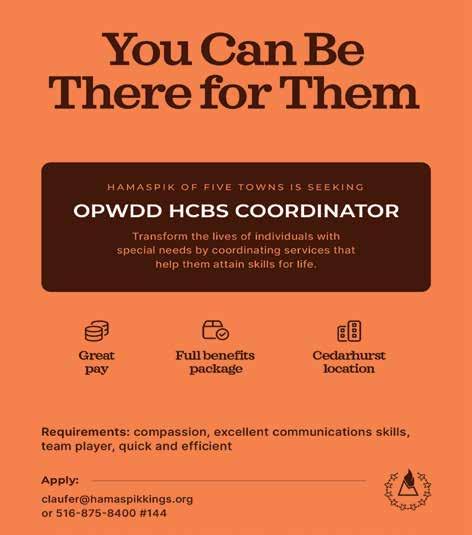
“While vaccination remains one of the most important tools in advancing the health and safety of employees and promoting the efficiency of workplaces,” the statement said, “we are now in a different phase of our response when these measures are no longer necessary.”
The short, four-paragraph statement closes one of the most contentious chapters in recent American history, in which
Medical experts, many of whom were fierce advocates of government vaccine mandates throughout the pandemic, largely agree that the need for such requirements has diminished as the virus — once a vicious threat — has faded.

The vaccine requirements will be eliminated on the same day that the Biden administration ends the COVID public health emergency, which was declared by the Trump administration on Jan. 31, 2020, shortly after the initial discovery of the respiratory disease in China. (© The New York Times)
At least six people were killed on Monday when a dust storm blew through central Illinois and caused more than 70 vehicles to crash along Interstate 55.
Thirty-seven people were hospitalized with injuries ranging from life-threatening to minor, Illinois State Police said. Those injured ranged in age from 2 to 80 years old, Illinois State Police Maj. Ryan Starrick said.
Seventy-two vehicles were involved in the crashes, which happened along a 2-mile stretch of I-55, police said. Two semi trucks also caught fire.
“The cause of the crash is due to excessive winds blowing dirt from farm fields across the highway leading to zero visibility,” Illinois State Police noted.
Winds of 45 mph picked up dust along the highway, making it impossible to see as a thick, yellow haze blanketed the air. First responders had a difficult time responding to the scene due to the thick dust, noting everyone’s “eyes are full of it.”

The National Weather Service in Lincoln, Illinois, issued a “blowing dust warning” at 1:25 p.m.
“Severely limited visibilities are expected. Travel will be dangerous and

Geoffrey Hinton, who has been called the “Godfather of AI,” announced this week that he left Google last week so he can freely speak out about the “dangers” of the technology he helped to develop.

Hinton was behind the pioneering work on neural networks that shaped artificial intelligence systems powering many of today’s products. He worked part-time at Google for a decade on the tech giant’s AI development efforts.
“I console myself with the normal excuse: If I hadn’t done it, somebody else would have,” Hinton told the New York Times , which was first to report his decision.
In a tweet on Monday, Hinton said he left Google so he could speak freely about the risks of AI, rather than because of a desire to criticize Google specifically.

“I left so that I could talk about the dangers of AI without considering how this impacts Google,” Hinton said in a tweet. “Google has acted very responsibly.”
Jeff Dean, chief scientist at Google, shared that Hinton “has made foundational breakthroughs in AI” and expressed appreciation for Hinton’s “decade of contributions at Google.”
The wave of attention around ChatGPT late last year helped renew
an arms race among tech companies to develop and deploy similar AI tools in their products. OpenAI, Microsoft and Google are at the forefront of this trend, but IBM, Amazon, Baidu and Tencent are working on similar technologies.
In March, some prominent figures in tech signed a letter calling for artificial intelligence labs to stop the training of the most powerful AI systems for at least six months, citing “profound
risks to society and humanity.” The letter, published by the Future of Life Institute, a nonprofit backed by Elon Musk, came just two weeks after OpenAI announced GPT-4, an even more powerful version of the technology that powers ChatGPT. In early tests and a company demo, GPT-4 was used to draft lawsuits, pass standardized exams, and build a working website from a hand-drawn sketch.
In the interview with the Times ,
Hinton echoed concerns about AI’s potential to eliminate jobs and create a world where many will “not be able to know what is true anymore.” He also pointed to the stunning pace of advancement, far beyond what he and others had anticipated.
“The idea that this stuff could actually get smarter than people – a few people believed that,” Hinton said. “But most people thought it was way off. And I thought it was way off. I thought it was 30 to 50 years or even longer away. Obviously, I no longer think that.”
Hinton has been concerned about AI’s potential for years. In a 2021 commencement address at the Indian Institute of Technology Bombay in Mumbai, he said, “I believe that the rapid progress of AI is going to transform society in ways we do not fully understand and not all of the effects are going to be good.”
He noted how AI will boost healthcare while also creating opportunities for lethal autonomous weapons. “I find this prospect much more immediate and much more terrifying than the prospect of robots taking over, which I think is a very long way off.”
Hinton isn’t the first Google employee to raise a red flag on AI. In July, the company fired an engineer who claimed an unreleased AI system had become sentient, saying he violated employment and data security policies. Many in the AI community pushed back strongly on the engineer’s assertion.

New York may soon become the first state in the nation to ban natural gas in new construction under a budget deal announced by Gov. Kathy Hochul.
The proposal, revealed Thursday night, has been a priority for environmental groups, who see it as a critical step in reducing New York’s dependence on fossil fuels and helping it meet its emission reduction goals. But it was opposed by the oil and gas industry and


treated skeptically by some consumers.
Environmental groups warned that the details of the plan were still unclear and said they worried it may contain a provision that would allow local governments to effectively veto the measure. But Katy Zielinski, a spokesperson for the governor’s office, said Friday that no such measure was included in the deal.
“The new law will not have any loopholes that will undermine the intent of this measure,” Zielinski said. “There will not be any option for municipalities to opt out.”
It is part of the sprawling $229 billion state budget deal announced by the governor. State lawmakers are expected to vote on the deal next week.
The New York ban would be a significant expansion of a nationwide movement aimed at addressing climate change in part by reducing the use of gas as well as oil.
Hochul said Thursday that the deal was a “conceptual agreement” whose broad strokes needed to be “finetuned” before a final vote was held.
Zielinski said the measure would also allow exemptions for facilities that may need to use fossil fuels for emergency backup power, including hospitals and laboratories.
The idea of banning gas hookups in new construction has been derided as government overreach by Republicans.
Its inclusion in the budget deal was criticized by Hochul’s opponents, including Lee Zeldin, a former member of Congress whom she narrowly defeated last November.
“Kathy Hochul and her cohorts are fast tracking the downward spiral of a once greatest state,” he said on Twitter.
According to the U.S. Energy Department, 61% of American households used natural gas for either space heating, water heating or cooking in 2020, the most recent year for which data is available.
(© The New York Times)
on strike on Tuesday morning for the first time since 2007.
“Though we negotiated intent on making a fair deal…the studios’ responses to our proposals have been wholly insufficient, given the existential crisis writers are facing,” a statement from the union leadership said.
“They have closed the door on their labor force and opened the door to writing as an entirely freelance profession. No such deal could ever be contemplated by this membership.”
The strike was set to begin at 3am on Tuesday; picket lines began on Tuesday afternoon.
The studios, which disclosed that the talks ended late Monday just hours before the strike deadline without an agreement, responded by saying it was willing to improve on its offer but was not willing to meet some of the union’s demands.

the nation’s 14th largest bank at the end of 2022 and had assets of $229.1 billion as of April 13. But it all came to an end last week, when the bank reported that it had lost more than half of its deposits during the first quarter of this year.
Now, JPMorgan Chase is buying most assets of First Republic after the nation’s second-largest bank failure ever, in a deal announced early Monday that protects the deposits of First Republic’s customers.
JPMorgan Chase said it had acquired “the substantial majority of assets” and assumed the deposits, insured and uninsured, of First Republic from the Federal Deposit Insurance Corporation, the independent government agency that insures deposits for bank customers.
More than 11,000 members of the Writers Guild of America (WGA) went
“The primary sticking points are ‘mandatory staffing,’ and ‘duration of employment’ — Guild proposals that would require a company to staff a show with a certain number of writers for a specified period of time, whether needed or not,” said the statement from management’s negotiating committee.

“Member companies remain united in their desire to reach a deal that is mutually beneficial to writers and the health and longevity of the industry, and to avoid hardship to the thousands of employees who depend upon the industry for their livelihoods.”
The last strike that began in November 2007 lasted into February of the next year. This strike is predicted to be long as well.
Although many shows on cable and certain networks have already filmed their final episodes for the season, the strike can impact late night shows, soap operas, and shows like “Saturday Night Live,” which depend on more timely material.
“Our government invited us and others to step up, and we did,” said JPMorgan Chase CEO Jamie Dimon. He said the deal is also a good one for his bank’s shareholders, adding to its expected earnings going forward.
The FDIC took control of the embattled First Republic and then immediately announced the sale. The failure will cost the FDIC about $13 billion. That money will be paid by the nation’s banks, which pay premiums to support the agency. It is less than the $20 billion cost of the failure in March at Silicon Valley Bank, which was a bit smaller than First Republic.

The move represents the latest effort by federal regulators to prop up consumer confidence in the U.S. banking system, which has suffered three major bank failures in the last seven weeks. Silicon Valley Bank and Signature Bank both were taken over by the FDIC last month following runs on those banks by their customers.
Over the past decade, roughly 70 banks have failed, according to FDIC data, though most of those have been smaller regional lenders. But there were no failures in either 2021 or 2022. The three failures since March 10 matches the total number of bank failures in the previous 36 months from March 2020 through February 2023.
Gold Medal flour has been identified as the source of salmonella in an outbreak that infected at least 13 people in

states, the U.S. Centers for Disease Control and Prevention said Monday.
General Mills announced last week that it’s recalling 2-, 5- and 10-pound bags of bleached and unbleached all-purpose Gold Medal flour that have a “better if used by date” of March 27 or 28, 2024.

Seven of those infected said they ate raw dough or batter.
$188,000.
Barlocco Island, a 25-acre uninhabited island about 6 miles from the nearest town, Gatehouse of Fleet, is being listed online by the Galbraith Group.
There’s not much going on on the peaceful piece of land. The island contains a flood pond to support the local wildlife during the winter months but no buildings or services.
It is part of the Borgue Coast Site of Special Scientific Interest, which means its natural areas are protected by the British government. As such, the new buyer cannot connect to any energy grid, although they can install solar panels or other off-grid technologies.
when you put someone in the box how psychologically they change.”
Since Sunday, Gueorguiev has been living in a box with three glass walls in front of the National Palace of Culture in Sofia. The athlete has a bed and a treadmill in his new home, but no access to books, a computer or phone. He is only allowed to speak with members of the public for 30 minutes each day.

“This is not a physical experiment; it is psychological experiment,” he noted.
Let’s hope he won’t shatter.
Salmonella usually causes diarrhea, fever, and stomach cramps within six hours to six days of consuming the bacteria. Most people recover without treatment within a week, but those who are younger, who are older or who have weakened immune systems may develop severe illness.
General Mills spokesperson Mollie Wulff said in a statement last week, “We are continuing to educate consumers that flour is not a ‘ready to eat’ ingredient. Anything made with flour must be cooked or baked before eating.”
Most flour is raw and hasn’t been treated to kill germs that cause food poisoning, according to the CDC. Salmonella bacteria dies when it is cooked or baked, but people can get sick when eating or tasting foods that include raw flour. Raw dough used for crafts and play dough also pose a risk.
According to listing agent David Corrie, the island “has been renowned for centuries as a place of unique landscape and natural light, a feature which attracted many artists to the area in the 19th and 20th centuries.”
During low tide, the island can be reached by foot. In high tide, you need a boat to get there.
“There’s still a very romantic sentiment attached to owning your very own Scottish private island, where you can escape the hustle and bustle of everyday life and enjoy some peace and tranquility in the most beautiful scenery around,” Aaron Edgar of Galbraith said on the listing agency’s website.
“The pebble beach is a delight and the perfect base to explore the island, partake in some cold water swimming, or to anchor a boat and enjoy a waterside picnic,” he said.
The price of peace.
A 400-year-old gold coin dating to the time of King Charles I that was found in a pile of loose change is expected to fetch thousands of pounds when it is auctioned off next month.

The coin, a gold Unite piece, has a currency worth of 20 shillings, but it is expected to sell for roughly $1,800 to $3,000.
The coin’s owner had found the precious item in the back of a drawer in her late aunt’s house. It was found amidst other currency that had been left over from travels abroad.

In an effort to help raise money for young people fighting addictions, Bulgarian ultra-marathon runner Krasse Gueorguiev will live in a glass box for 15 days in a park in Sofia.
Last month, volunteers cut a giant circle in a frozen lake and set it in motion, nabbing a world record in a category that few people know exists: The biggest ice carousel.

With a diameter of 1,776 feet — or 541 meters — the giant piece of ice in Madawaska, Maine, estimated at 146,000 tons, moved slowly like a Lazy Susan to hoots, hollers, and high fives.
It was a long, arduous process. Northern Maine Ice Busters had to cut through ice nearly 30 inches thick on a path painstakingly measured by survey crews to create a perfect circle measuring nearly six football fields across.
Creating an ice carousel has become somewhat of a rivalry in places like Finland, Minnesota and Maine. There’s even a World Ice Carousel Association.
“It’s a friendly competition,” said John Mazo, media liaison for the Northern Maine Ice Busters.
Last month, it took a herculean effort to get the giant disk moving in Maine with 10 outboard boat engines, farm equipment driving oversized propellers, and a couple of wheeled vehicles, too.
But it turned out real n-ice.
Originally, the owner thought the coin was fake.
“The vendor found the coin at the back of a dressing table drawer when she was sorting through her late aunt’s effects,” said Robin Fletcher, an antiques appraiser for the auction house. “Both the vendor and her husband assumed it must be fake, so [they] took little notice of it and tossed it into a box of mixed 20th century coins,” he said.
The gold coin is stamped with an image of King Charles I, who served as King of England, Scotland, and Ireland from March 27, 1625, until he was executed in 1649.
Upon looking at the coin, Fletcher realized he had literally and figuratively “struck gold.”
The auction of the coin featuring Charles I is timely, as the coronation of King Charles III is on May 6, Fletcher noted.
“I’d advise anyone with old coins sitting around at home to go through them carefully and call in the experts to double-check their value.”
We’ll be sure to look through that loose change.
If you’re looking for solitude, this land may be for you. An isolated private island off the coast of Scotland is for sale with an asking price of about
Gueorguiev, a motivational speaker and charity ambassador, has run some 30 ultra-marathons worldwide, from the Arctic to Cambodia, as well as a 217-kilometer race in California’s Death Valley.
“I want to challenge myself,” Gueorguiev told Reuters. “I want to show
King Charles was the first royal heir to earn a university degree.






Yom Ha’Atzmaut is always a highlight at HALB, and this year was no different! Lev Chana took their annual “trip” to Israel, completely transforming the school. Children made their very own passports, went on the plane, and landed at Ben Gurion airport where they went through passport control. They then visited a variety of cities and activities such as Yerushalayim, Eilat, a kibbutz and an army base. They finished off the school day with a fun chagiga with Gary Wallin and delicious blue and white
cookies!
In addition to the Israel focused learning and activities in HALB during the day, Lev Chana and HALB students, faculty and parents all joined together after school for an incredible Joey Newcomb concert celebrating Israel’s 75th birthday. The excitement was palpable as over 1,400 people enjoyed a delicious BBQ and sang and danced together to celebrate Israel. It was certainly a night to remember!

The talmidos of the Ganger Early Childhood Center at TAG collaborated on a beautiful bulletin board for their continued Kavod theme,

now focusing on kavod l’chol adam. Every talmidah decorated a handprint, and those prints are now all “holding hands” – showing the true achdus at TAG!


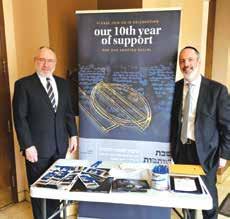
Agudas Yisroel of West Lawrence, led by Rav Moshe Brown, held its 10th annual Shabbos shutfus with Adopt-A-Kollel this past Shabbos Parshas Acharei Mos-Kedoshim. A kiddush was held in honor of the partnership on Shabbos.
The shul also held a sign-up event Sunday morning after Shacharis where members joined for another year of partnership with Kollel Amalei Torah led by Rosh Kollel, Rav Yehoshua Atik.
The members of the shul have a close relationship with the Rosh Kollel and children of the members of the shul, learning in Eretz Yisroel have become frequent Shabbos guests at the home of the Rosh Kollel.
Mrs. Chavatzelet Graber’s CAHAL Kindergarten class at HANC enjoyed celebrating Israel’s 75th birthday last week on Yom Ha’Atzmaut. They wore special birthday hats and put notes into the “Kotel.”
CAHAL, the only program in the community with separate boys and girls classes for children with learning challenges in our local yeshivas and Bais Yaakovs, is accepting applications for the 2023-24 school year. To apply, visit www. cahal.org or call 516-295-3666.


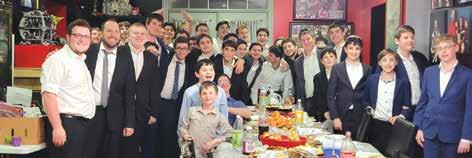
Congratulations to Bayla Axelrod, a junior in SKA’s Art Academy, who has been named as one of “Long Island’s Best Young Artists” by the Hecksher Museum.

Bayla’s pencil drawing will be displayed at the Hecksher Museum beginning April 29.
She is seen here with Mrs. Suzy Libin, SKA Art Academy Director.
This past Shabbos, MTA talmidim gathered in Brooklyn for a Shabbos of inspiration and connection with their chaverim. With Brooklyn lo -
cals hosting friends from different communities, the Shabbaton highlighted the diversity of the MTA student body.
The talmidim of Yeshivas Ateres Eitz Chaim enjoyed College Prep Day at Citi Field followed by a thrilling Mets game. At the College Prep Day, the importance of internships and building a resume from experience was reinforced as B”H, this is offered daily at Yeshiva Ateres Chaim. Students then enjoyed speaking with representatives from many SUNY Colleges. It was exciting for students to see that their daily schedule allows them to graduate with the credentials needed for any of these colleges.
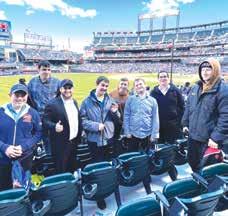
Only

This past Friday was week five of FM Home Loans 5 Towns Flag Football. This week’s games were super competitive with neck-and-neck ties, game winning touchdowns, and great receiving.
In the Pre-1A division, the boys had an excellent recap of everything they learned. They practiced drills for running, catching, and throwing.
In the 1st grade division, the Giants tied with the Patriots. And the Broncos defeated the Jets with Max Schwartz’s consistent defense.
In the 2nd grade division, the Commanders defeated the Broncos. The Giants defeated the Texans. The Jets defeated the Vikings with Shua Dubin’s short catches. And the Patriots tied with the Eagles.
In the 3rd and 4th grade division, the Panthers defeated the Patriots. The Jets defeated the Dolphins. The Falcons defeated the Broncos with Avi Korns-
berg’s amazing receiving skills. The Vikings defeated the Eagles with MVP Ezra Mishaan’s 3 touchdowns and 100-yard pick six. The Steelers defeated the Seahawks. The Packers defeated the Raiders. The Saints defeated the Giants.
In the 5th and 6th grade division, the Dolphins defeated the Raiders. The Saints defeated the Steelers. The Panthers defeated the Packers with Yehuda Yudin’s touchdown. The Falcons defeated the Giants. The Broncos tied with the Jets. And the Seahawks defeated the Patriots with Natanel Mann’s interception.
In the 7th and 8th grade division, the Vikings defeated the Patriots. The Giants defeated the Jets with Tzviki Zerns game winning touchdown. And the Broncos defeated the Eagles with Yisrael Polakoff’s amazing overall performance. Looking forward to a great end of the season. FM Home Loans sweatshirt giveaway coming up!



The annual dinner of Yeshiva Darchei Torah’s Beis Medrash
Heichal Dovid and Kollel Tirtza Devorah will be held this Sunday, May 7, at Ateres Chynka in Brooklyn, New York. The event will pay tribute to three distinguished families:
Mr. and Mrs. Chaim and Rivky Tepler
Guests of Honor
Chaim and Rivky Tepler are the parents of Asher, a ninth grade talmid at Mesivta Chaim Shlomo, and Yoel, an alumnus of the Mesivta and Beis Medrash Heichal Dovid. It was during preparations for Yoel’s wedding to Ayala Stern this past March that Mr. and Mrs. Tepler graciously agreed to be our guests of honor. In addition to their Darchei boys, the Teplers’ sons Yehudah and Avrumi are learning at Mercaz HaTorah in Eretz Yisrael while their young twins, Ari and Emmy, are first graders at Yeshiva Ohr Shraga Veretzky and Masores Bais Yaa-
kov, respectively.
Chaim and Rivky, longtime Flatbush residents, are mispallelim at Nachlas Yehoshua of Monastristch, which is under the leadership of Rav Nachum Rabinowitz. They are known to be generous supporters of Torah and chesed organizations, as are Chaim’s parents, Moshe and Helen Tepler, and Rivky’s parents,
Shmiel and Deborah Sontag.
The Teplers speak highly of Darchei, referencing the special kesher that Yoel and Asher have with the yeshiva. “Rabbi Bender and Yoel’s rabbeim treat our boys like their own sons,” they share. “They have been there to guide Yoel’s growth from ninth grade through marriage and beyond.” Asher is thriving in his first year as a Darchei talmid and is benefiting from the same care his elder brother received.
Chaim works in his family’s real estate firm together with his father, uncle, and cousins, where he undertakes the complex management of numerous asset types. Rivky is the co-founder of a real estate development company, where she oversees the acquisition and construction of projects in New York and Florida. While they are managing structures and creating them, their true passion for building is at home, where they fastidiously raise their children in a true Torah lifestyle.
Avodas HaKodesh Award
The Yeshiva is proud to honor Mr. and Mrs. Yitzchok Fuchs with the Avodas HaKodesh Award. The year 5783 marks their eleventh year of association with Beis Medrash Heichal Dovid and Kollel Tirtza Devorah.
Mr. Fuchs first developed a relationship with the Rosh HaYeshiva, Rav Yaakov Bender, in the aftermath of a 2008 terrorist attack in Eretz Yisrael, when he undertook a campaign to write a Sefer Torah l’ilui nishmas the victims. He asked bachurim from over 30 yeshivos to contribute a few dollars from their spending money to commission the writ-
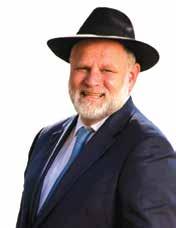
ing of the Sefer Torah, and Rabbi Bender offered to help coordinate the campaign. Over $35,000 was raised.
In 2012, the Fuchs’s son Shmuli enrolled in the Beis Medrash. “He loved it immediately,” his father says. Shmuli married and spent three years in Eretz Yisrael before returning to Far Rockaway to join the Kollel, where he learned for two years. Mr. Fuchs had a regular chavrusa session with Shmuli in the yeshiva every Thursday night for many years, and continued with a different chavrusa during the time his son was learning in Eretz Yisrael.
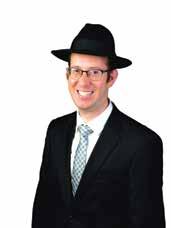
Mr. Fuchs is the owner of Conserve Holdings, a real estate company, but is even better known for the camp he runs for yeshiva boys every summer in Eretz Yisrael. It’s officially called The Experience, but, as Mr. Fuchs says, “Most of the boys refer to it as ‘Fuchs’s.’” His wife Devorie adds, “My husband loves Eretz Yisrael, and realized many boys were going to learn there without having much idea of what it was really about. He created the camp to acquaint them with the land.” In the fourteen years the camp has been in existence, over 1,000 boys have benefited from the experience.

The Fuchs house in Flatbush is an open one, and Devorie manages their busy home with grace and efficiency. “She made me who I am,” her husband states.
The Fuchs family davens in the shul of Rav Shimon Alster while retaining a close connection to Yeshiva Torah Vodaath. Mr. Fuchs’s father was a talmid of Rav Pam zt”l, and he himself was a talmid and kollel yungerman there; he still goes to Torah Vodaath to learn ev-
ery morning. Mr. Fuchs is active in Agudath Israel and has served on its boards. He and his wife are the parents of seven children B”H, four of them married, and several grandchildren, one of whom is already a Darchei Torah talmid—and whose younger brother looks forward to following him next year.
Rabbi and Mrs. Moshe Chaim and Dina Horowitz
Kesser Torah Award
When Darchei Torah opened its Kollel Tirtza Devorah in 2005, Rabbi Moshe Chaim Horowitz was one of the six bochurim in its very first cohort. “I had finished Mesivta Chaim Shlomo and Beis Medrash Heichal Dovid at Darchei, and when I returned from learning in Eretz Yisrael I entered the new kibbutz, which soon developed into a full-fledged kollel,” he says. When he married about a year later, he and his wife Dina, originally from Monsey, settled in Far Rockaway.
Today, Rabbi Horowitz claims the distinction of being the last of his cohort to still be learning in Kollel Tirtza Devorah. He spends the morning seder bichavrusa
with Rosh Kollel Rav Dovid Bender and returns again in the evening. During the afternoons Rabbi Horowitz, who passed the CPA exam in 2005, works at Darchei as assistant comptroller.
Dina completed her degree as a registered nurse in 2007 and has been working since as a visiting nurse for NYU-Langone of Long Island. The Horowitzes have five children, including two sons who are Darchei talmidim.
Rabbi Horowitz is an integral part of the Kollel Alumni Minyan, which was started this past year in Far Rockaway and is comprised of current and former members of the Kollel. On Friday nights, different rebbeim from Darchei take turns coming to inspire the new kehillah with divrei Torah.
Despite his busy schedule, Rabbi Horowitz finds time to take care of the finances for Kollel Tirtza Devorah’s participation in the Adopt-a-Kollel program. “The usual way this program works is that shuls in the U.S. adopt kollelim in Eretz Yisrael and raise money for them,” Mrs. Horowitz explains. “Kollel Tirtza
Lag B’Omer and New Jersey appear to be two separate entities.
But several years ago, hundreds of people discovered the connection. That number keeps climbing at an astounding rate, with thousands of visitors uncovering its secret each year.
Every year, rows of cars and buses depart from communities scattered throughout the New York and New Jersey area on Lag B’Omer. Their passengers span the spectrum of Jewish society, but they share a common destination: Floral Park Cemetery in Monmouth Junction, New Jersey.
The cemetery in New Jersey becomes a virtual microcosm of Klal Yisroel, from the evening of Lag B’Omer until deep into the following night. The ohel of the revered Bobover Rav, Harav Naftali Tzvi Halberstam, zt”l, echoes with tears and tefillos pouring forth from thousands of shattered hearts. Simultaneously, joyous strains of Bar Yochai burst forth outside of the ohel, as circles of visitors dance in unison. An assortment of food and drinks, as well as many other necessities, are provided throughout the day.
It is an uplifting scene. It brings Lag B’Omer to American shores.
And the questions are inevitable.
Why here? Why now? What is this powerful connection?
Concealed Greatness
Anyone who was privileged to know the Bobover Rav zt”l remembers him as one who concealed more than he revealed. His humility was so strong and pervasive as to camouflage him amongst the crowd. Shunning the spotlight, he kept the depth of his inner world shuttered and obscured.
Only in his last years, when he served as the Rav of the Bobover community, was the mask forcibly stripped away. His greatness could no longer be concealed. It was a shocking revelation, as time after time his concise and often puzzling words came to fruition in the most astounding ways. The stories depict a leader’s devotion to his followers; a devotion that overruled his desire to remain unnoticed.
There were just a few short years during which the world benefited from the Rav’s penetrating gaze and otherworldly existence. Less than five years after he assumed the mantle of leadership, Klal Yisroel lost one of its purest treasures.
His matzeivah is an eternal testimony to the humility that characterized his
Devorah is the only case of a kollel that supports another kollel.” Kollel Ohr HaTorah in Ramat Beit Shemesh is the fortunate recipient of the our Kollel’s fundraising efforts.
Rabbi Horowitz’s gift for numbers has led to numerous offers of jobs outside the Yeshiva, but he and his wife prefer to remain within the Darchei orbit and continue in a kollel lifestyle. “Our shared goal is to lead a life centered around Torah and our family,” Mrs. Horowitz says. “Now that our children are a bit older, they appreciate our choices and take great pride in what we do.”
About the Beis Medrash and Kollel
Since its inception in 1999, Beis Medrash Heichal Dovid has enabled an entire generation of bachurim to grow in Torah, yirah, and middos from morning to night under the tutelage of their roshei yeshiva, maggidei shiur and mashgiach. In 2005, at the request of several alumni returning to the States from yeshivos in Eretz Yisrael, a ‘kibbutz’ of senior bachurim was formed as well. These talmidim soon
married and formed the pioneer cadre of Kollel Tirtza Devorah, which today has 31 full-time avreichim and 46 mechanchim in its afternoon Kollel—in addition to a kibbutz—all under the aegis of the rosh kollel.
Together, the Beis Medrash and Kollel form the crown jewel of Yeshiva Darchei Torah, training over 200 budding talmidei chachomim–who are living examples of Torah lishmah for their younger counterparts on campus—as the next generation of Jewish leaders. Indeed, hundreds of alumni are now teaching and disseminating Torah throughout North America and beyond as rabbeim, poskim, and learned baalei batim, building their own homes and communities on the firm foundations they formed at the Yeshiva of their youth.
For more information, or to contribute, please call 718.868.2300 ext. 301; email kollel@darchei.org; or visit www. darchei.org/Kollel
existence. Simple, unadorned and devoid of praise, precisely as the Rav requested. And yet, this simple matzeivah has become a bastion of hope and promise to so many individuals in pain. The light that was forcibly hidden away for nearly seven decades now seeps out to illuminate the lives of thousands.
And it is specifically on Lag B’Omer that this illumination is magnified many times over.
It started with a trickle which quickly turned into a virtual flood. Lag B’Omer became synonymous with Harav Naftali Tzvi zt”l. Many people traveled to the tziyun on that day. It wasn’t long before the concealed connection was exposed for the entire world to see.
Stories abound. Every year brings new tidings; each Lag B’Omer is studded with miraculous accounts of salvation. Yidden come to the tziyun and pour out their hearts to the One Who always listens. And then, when they walk out of the ohel, they are calm. They know that their tefillos have been heard and are hopeful that they have been accepted, in the zechus of the tzaddik Rav Naftuli Tzvi zt”l and in the zechus of Rabi Shimon bar Yochai.
The stories stream forth from glad-
dened hearts. In the years since the mysterious connection was revealed, Yidden from all over have traveled great distances to visit the Bobover ohel on Lag B’Omer.
With the approach of Lag B’Omer, thousands in Eretz Yisroel are planning their trip to Meron. At the same time, Yidden from New York and New Jersey and its environs are taking advantage of the secret that has become known to all. They are planning their journey to Floral Park Cemetery in New Jersey, for the Rav’s words echo through time.
“Rabi Shimon ben Yochai will be by me on Lag B’Omer.”
May Hashem accept all our tefillos and transform mounds of pain into mountains of joy.
To send a kvittel to be read at the ohel: Email: kvittel@lagB’Omernj.org / Fax: 732-647-1326
Lag B’Omer Info Line: 718.664.9797
To sponsor Segulas Chai Rotel, send an email to: chairotel@lagB’Omernj.org
GPS info: Floral Park Cemetery: 104 Deans Rhode Hall Rd. Monmouth Junction, NJ 08852 open 24 hrs. year round.



Chol Hamoed Pesach is not always the optimum time for a Siyum, especially in light of the different minhagim regarding eating amongst the various communities and even families, but that didn’t stop the outpouring of ahavas haTorah from springing forth at numerous siyumim on chelek aleph in the Mishnah Berurah that took place across Europe.
Whereas in Eretz Yisrael most of the large siyumim attended by Gedolei Yisrael – including such luminaries as HaGaon HaRav Avigdor Nebenzahl, shlita, HaGaon HaRav Reuven Elbaz, shlita, the Boyaner Rebbe, shlita, HaGaon HaRav Shimon Galei, shlita and the Lelover Rebbe, shlita – were held before Yom Tov, most of those held in Europe and South Africa took place on Chol Hamoed Pesach.
The events, held in England, Belgium, Germany, France, and even far off South Africa, were full off simcha, inspiration and a deep sense of accomplishment, permeated by a feeling that the participants were involved in something much greater than themselves.
There were also multiple siyumim held in over 100 locations in North America, to celebrate the completion of Chelek Aleph. Some of them were held in the shuls where the shiurim were given either on Chol Hamoed and others were held after yom tov.
The first event, on Sunday Chol
Hamoed, was held in Manchester. It was a city-wide event that illustrated the unique achdus of Dirshu and its Daf HaYomi B’Halacha program whose participants represent the entire cross-section of Charedi Jewry. Yidden in all kinds of hats, shtreimelach, spodiks, older people, younger people, bochurim and even children all participated in this beautiful siyum where the only thing served was seltzer, water, wine and grape juice!
Among the most inspiring moments at one of the siyumim was when the chairman related a remarkable incident. He said, “There is a special bochur in the crowd to whom I especially want to pay tribute. That bochur, who learns and takes tests on Daf HaYomi B’Halacha, recently celebrated his bar mitzvah. It just so happened that the monthly Daf HaYomi B’Halacha test fell out on the night of his own bar mitzvah. That wonderful, dedicated bochur insisted on first going to take the Dirshu test. Only after completing the test did he come to his own bar mitzvah!”
The large head table was graced by many of Manchester’s rabbanim as well as the more than ten Daf HaYomi B’Halacha maggidei shiur who deliver shiurim in battei medrash that dot the entire city.
The special guest speaker at the event was Rav Yitzchok Zvi Stroh, Rav of Beis Medrash Toras Chaim of Gateshead and a Daf HaYomi B’Halacha maggid shiur.
Joyous Siyumim in Antwerp
In Antwerp, home to one of the most unique Daf HaYomi B’Halacha shiurim
held daily in the “Bourse,” the famed Belgian diamond center where so many community members work, three separate siyumim were held. The first siyum, in Beis Medrash Ohel Yaakov where Rav Yitzchok Yoel Fisher delivers a well-attended shiur, was graced by the Mara D’Asra, HaGaon HaRav Aharon Schiff, shlita. Rav Schiff is an enthusiastic supporter of Dirshu and at a previous Daf Hayomi B’Halacha siyum in Antwerp. He highlighted “the importance for Torah that permeates everything that Dirshu does. Harbotzas haTorah and support of Torah on such a scale can only be rooted in infinite love of Torah.” Rav Schiff also pointed out the importance of the mussar component of the Daf HaYomi B’Halacha. There is a misconception that mussar learning is only for exceptional ovdei Hashem. Dirshu has successfully encouraged everyone to engage in the introspection of avodas hamussar.
Additional siyumim were held in Beis Medrash Yismach Yisrael, where Rav Yeshaya Greenwald, delivers a shiur as well as at Beis Medrash Tal Torah, at the shiur given by Rav Avrohom Kampf.
The Chashivus of Completing Even One Chelek
One of the most inspirational siyumim that was suffused with simchas haTorah and chashivus haTorah was the siyum in Gateshead, held at the Sunderland Yeshiva Hall.
The Chairman, Rav Moshe Boruch Katenka, who is the menahel of Dirshu
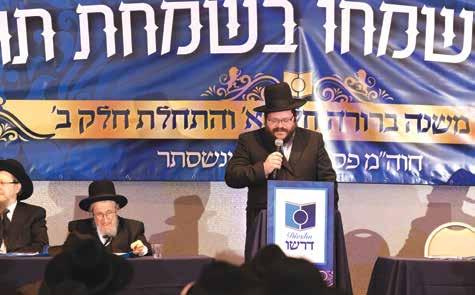
in Gateshead as well as a Daf HaYomi B’Halacha maggid shiur, said, “I heard that some people were wondering whether the siyum of one chelek of Mishnah Berurah halachically constitutes a davar shaleim upon which one can make a siyum. I would like to share with you a fascinating historical fact that most people do not know.
“After the Chofetz Chaim completed writing the first chelek of Mishnah Berurah, he was afraid that perhaps he would not be granted enough years to complete the entire order of Orach Chaim. He therefore decided that it was most important to first complete hilchos Shabbos. Why? Because the halachos of Shabbos are extremely stringent and complex. He skipped writing chelek beis and began to write chelek gimmel and chelek daled devoted exclusively to hilchos Shabbos. Only after completing those two chalakim, did he return to chelek beis. From here we see that that the Chofetz Chaim himself viewed chelek aleph as a complete sefer as a davar shaleim, otherwise he would not have stopped in the middle and go on to something else.”
Rav Katenka brought further proof to this by sharing a personal reminiscence of the time he visited his grandfather, Rav Yerachmiel Tzafnas, a talmid of the Chofetz Chaim, and noticed something completely uncharacteristic of his grandfather – there was cake and whiskey on his table. His grandfather then told him
that the cake and whiskey were in celebration of the fact that on that day he had completed the first chelek of Mishnah Berurah.
“My grandfather, who was a talmid of the Chofetz Chaim, would never have marked the completion of one chelek in this way, unless he had seen it by the Chofetz Chaim.
“From here we see the importance and chashivus of completing even one chelek of the Mishnah Berurah,” Rav Katenka concluded.
“If
…”
Rav Avrohom Aran, a Dayan in Gateshead and Rav of Beis Medrash Avreichim, related a powerful story that made a tremendous impact on the audience. He said that he had been zoche to participate in a Dirshu Shabbos in Vilna together with numerous rabbanim and graced by many Gedolei Yisrael. “On motzoei Shabbos,” Rav Aran said, “there was an asifa of rabbanim and they were asked to try to make and deliver shiurim on Daf HaYomi B’Halacha in their respective communities. When they came to me, I told them that it was an excellent idea, but sadly, I
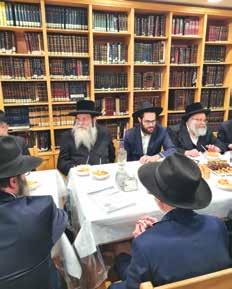
simply did not have an extra minute in my day to deliver another shiur
“After the asifa, an elderly senior rav with a long white beard who needed a cane to support himself came over to me. I later found out that he was the prominent Rav and Dayan, Rav Yitzchok Luxenberg, Rav of the Neos Simcha neighborhood of Modiin Illit, who delivers a daily Daf HaYomi B’Halacha shiur. He told me, ‘I am already an elderly Jew. I don’t know how much time I have left. I would like you to think about what I am telling you. A person does not know in which zechus he is alive. I don’t know why I am still here in this world. What zechus do I have? There is one thing I can tell you, if you have the opportunity to be a maggid shiur and you don’t grab it, who knows what will be?’
“The determined look in his eyes made it impossible for me to disregard his words. I availed myself of the opportunity, and Baruch Hashem, I have now completed chelek aleph and not only have the members of the shiur gained tremendously, but I have as well!”
Rav Aran concluded by encouraging whoever has the opportunity to deliver a
shiur or even to start learning chelek beis on their own, to “just grab that opportunity. You won’t regret it!”
Revenge Against Hitler, ym”sh
Another highlight among the siyumim was the magnificent event held in honor of the beginning of chelek beis on Shabbos Rosh Chodesh Iyar in Berlin, Germany. On Shabbos afternoon, after

Mincha, Rav Daniel Glauberman gave a Daf HaYomi B’Halacha shiur followed by words of hisorerus by HaGaon HaRav Chaim Ozer Gurwicz, shlita, R”M at the Gateshead Yeshiva, a son of the famed Rav Leib Gurwicz, and a brother of the current Rosh Yeshiva of Gateshead, HaGaon HaRav Avrohom Gurwicz, shlita
As Dirshu has recently started chelek beis of Mishnah Berurah, those who have not yet joined are urged to come aboard.
Rabbi Shlomo Rozenstein, Dirshu’s Director of Public Relations, explained, “Many people have a misconception. They think that only if someone is ready to be tested on what they learned can they join Daf HaYomi B’Halacha. This is not true. Certainly, Dirshu urges all to learn in a way that he can know it so well as to take a test, but Daf HaYomi B’Halacha is open to all of Klal Yisrael! After all, no Yid in Klal Yisrael can make a move without knowing halacha.”
For information on how to join Daf HaYomi B’Halacha, please call Dirshu at 1-888-5Dirshu or email info@kolleldirshu.org.
On Sunday, MTA welcomed the incoming class of 2027 for their first day in yeshiva together.
During their morning in MTA, the incoming talmidim had the opportunity
to meet each other, formally, as future classmates. It was an exciting morning, and the yeshiva can’t wait to greet this incredible group for their first official day of yeshiva in the fall.
Torah L’Kulanu (TLK) commemorated Yom HaZikaron on April 25 by holding a special assembly in which students lit a yahrzeit candle in memory of fallen soldiers who perished while protecting and defending the Land of Israel. We held a moment of silence and watched a film about the IDF’s unit for soldiers with special needs, as well
an emotional film about a family whose daughter perished in a terrorist attack.
On the following day, April 26, we lifted ourselves into the joyous day of Yom Ha’Atzmaut, Israel’s Independence Day. TLK students made Israeli flags and participated in a trivia game, answering questions about the Land of Israel throughout Tanach and our history.

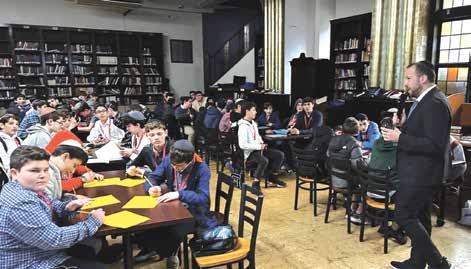
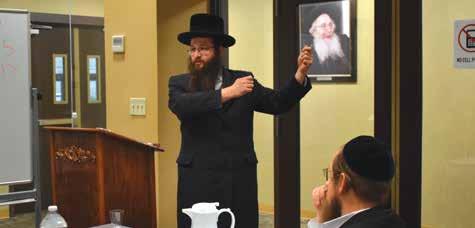
Monday, April 24 was a special day at Shevach High School. The student body was privileged to hear from renowned speaker and rav,Rabbi Ephraim Shapiro. After a meaningful introduction by Shevach Menaheles Mrs. Shulamith Insel, Rabbi Shapiro, in his inimitable way, addressed what so many of us are thinking about during these days of Sefirah: our relationship with one another.
With poignant anecdotes and divrei Chazal, Rabbi Shapiro spoke directly to the girls’ hearts, while outlining how one can acquire the important middah of “lev tov.” He pointed out that there are girls who sit in “the dark” so often. They are not recognized by their friends and not embraced by their peers. We should not underestimate the power of a smile or of a few kind words spoken to others.
Rabbi Shapiro focused on the theme of making a difference. He encouraged the girls by saying, “Don’t underpay. When you can do or say something, grab the opportunity to do so.” Underpaying is not getting involved when you could and should. In a positive manner, he
gave the students the charge of becoming leaders in life. Drawing upon memorable personal experiences, he showed how the dynamics in many situations can be quickly changed when people show that they care.
Rabbi Shapiro specifically mentioned the time he was scheduled to speak to a group of young boys, and only one boy showed up. Instead of being upset, he spoke to that young man personally and ultimately transformed his life, without even immediately realizing it. One never knows the effect one’s words can have on another person.

The lessons learned from the days of R’Akiva resonated very clearly with the students. All took away the message that it is our responsibility to bring others into our inner circle. If we are sensitive to that fact, we can be members of a group that constantly widens its circle and builds warmth among others.
The school is indebted to its menaheles, Mrs. Insel, for making the magical morning possible. It is sure to have left a lasting impression on all who were there.

On Sunday, April 30, scores of women from across the community gathered in the Gural JCC’s Harrison-Kerr Family Campus in Lawrence for a morning of inspiration and connection. The program, “Everyone Has a Story,” was initiated by the Jewish Women’s Leadership Council (JWLC) in an effort to highlight the rich and diverse heritages in the community and to celebrate all that unites us.

The keynote speaker, Rivka Malka Perlman, spoke powerfully about how we are all heroines in our own story. Each person was put onto this earth to write their own story – and as each person is unique, no two people are able to write the same story. She spoke about rising above the role of a victim to reaching the level of redemption, where we can “own” our own narrative.
Three women from the community
shared their compelling stories with the audience. Their stories were depictions of the heroism that each person has within them. Hailing from different segments of the community, their accounts were moving to each audience member, as they were able to connect with the struggles and triumphs showcased in their stories. Indeed, although our community is composed of diverse individuals, we are united in so many ways, and those differences only help to create the brilliant mosaic that we call home.
Sharon Haymov spoke about growing up in Iran under the Shah. She talked about her life before the Iranian Revolution and the terror that she felt fleeing. She shared about moving to Lawrence, NY, as a young girl and acclimating to the American culture. Sharon also spoke about the blending of cultures, as her sons-in-law are Ashkenaz men who appreciate both the Persian, Sephardic, and Ashkenaz heritages in their home.
Marina Babayeva, who now lives in Woodmere, grew up in the Bucharia region without running water or sanitation services. Each day, her family would need to bring two buckets of water up the

hill to their home – water that would be used for cooking, drinking, and cleaning. Bathing was done once a week; clothes were bought once a year. Marina spoke movingly about her move to the United States and her journey towards Yiddishkeit, culminating in her brave decision this year to fully cover her hair – which she embraced in a trip to Israel.
The third speaker, Rachel Fraida Cohen, originally hailed from Florida but now lives in the Five Towns. Rachel shared her journey of searching for Yiddishkeit, with stops in Israel and Chile. Her constant, persistent pursuit of the truth led her to where she is today. With a talent for art, Rachel expresses her inspirations through painting, depicting rich, beautiful themes in vibrant, swirling colors.
At the end of the program, the audience, energized and inspired by the journeys that were shared, understood that, truly, “everyone has a story.”
This program, produced by the JWLC, was sponsored by UJA Federation and Gural JCC.



After last year’s successful Sefira Night of Inspiration, the Women’s League of TAG has once again provided an uplifting evening of inspiration for TAG mothers, TAG talmidos, as well as opening the event for the entire community.
This year, on Tuesday night, April 26, we had the privilege of hearing from noted speaker Rabbi Eli Mansour, who captivated his large audience who were moved by his words on the topic of “Na’asaah VaNishma, Are We Really Listening?” It was especially gratifying to see a large number of TAG’s own Machon Sarah High School talmidos attending
the shiur. The High School participates in their own Na’asaah Va’Nishma Sefira series, dedicated in memory of TAG’s Dean, Rabbi Moshe Weitman, z”l, which meets weekly during this auspicious time of year. They were grateful that the Wom-



After spending the first half of the semester learning how to code the microbit and use it to control things, the eighth graders at HALB worked on a project in which they had to use the microbit to make something useful for them or society. Some of their

projects included an exercise step counter that plays music if you stop walking to remind you to continue, a cardboard piano that really plays, a temperature alarm for an elderly home, a nightlight for a child that also plays music, a rock paper scissors game that will tell you who won,

en’s League invited them to come hear Rabbi Mansour.
The moving force behind this event, Mrs. Nataly Magendzo, and her invaluable team are to be commended on a job well done. TAG is very grateful to Mrs.
Edna Ershowsky, Mrs. Sylvia Fuksbrumer, Mrs. Martha Hershkovich, Mrs. Soshie Hirth, Mrs. Rivkah Katznelson, Mrs. Nataly Magendso, Mrs. Allyson Perkal, Mrs. Julie Saal, and Mrs. Amanda Waltuch.
and more!
Students had fun and felt very proud of what they were able to design and create using their knowledge of coding and the microbit.
Green was the dominant color in the halls of the Stella K. Abraham High School for GIrls on Tuesday, April 25, in recognition and solidarity with Israel and Yom HaZikaron. The observance of Israel’s Memorial Day at SKA was an inspiring way to acknowledge the contributions of the thousands of Israeli soldiers who gave their lives defending the State of Israel and mourn with the families of those who lost loved ones to terror.
After standing in silence at the sound of the siren, the SKA students assembled in the auditorium to hear from former IDF soldiers Hilal Bisan,and Ohad Roisblatt who shared their stories. This moving program was made possible through the Elami-Elatzmi organization, which promotes strong Zionist and Jewish identity in Israel and around the world.
In the afternoon, the SKA girls joined
together for a special student-led kumsitz, conferring a deeply spiritual aura to the day. Then, in a “from darkness to light” moment, the pain of remembrance turned into joyous celebration, as the girls decorated the school building and hallways for the next day’s salute to Yom HaAzmaut.
Blue and white were the colors of choice on Wednesday, April 26, in honor of Israel’s Independence Day. After a meaningful davening, SKA’s morning classes honored “Israel Across the Curriculum,” as faculty members in each discipline addressed Medinat Yisroel and Zionism in different ways. With topics ranging from “Israel By the Numbers,” an analysis of Natan Alterman’s poem, “The Silver Platter,” discussing Ezer Weitzman’s statement that Israel would not be given on a silver platter, and exploration of Israeli innovations in technology among others, SKA students were
immersed in Israeli history and culture. The sessions were filled with creativity as the girls used various candies to illustrate Biblical themes and cities in Israel, made origami models of DNA connected to Israeli breakthroughs in cancer research, and “signed” Hatikvah as they sang!

The chagigah held after the schoolwide lunch of Israeli cuisine was full of spirited dancing and simcha. A highlight of the day was a tribute to and hearing


YSZ HS for Girls is proud to announce that three of their faculty members were accepted to and will be attending the prestigious Teacher Tech Institute @ the Massachusetts Institute of Technology (MIT), the premier school for technology and innovation in the world. The Legacy Heritage Foundation will be funding the high schools’ faculty for a weeklong fellowship this summer, including Ms. Greenberg, Mrs. Wasser, and Mrs. Yachnes.
“I’m so excited to be part of this program! I’m hoping to gain real insight into promoting hands-on learning, and a rich, student centered curriculum,” related Ms.Greenberg, the high school’s STEM teacher.
Together they will collaborate to make a schoolwide project that will be implemented this coming school year. Their goal is to bring innovative and cutting-edge practices to the high school. Their acceptance letter read, “Thank you
for your vision and partnership. We look forward to working together to develop a wonderful project that combines the magic of the arts with the depth of Jewish content for the benefit of the students in your school.”
“There are few schools that are so supportive of and place an emphasis on their staff’s professional development. A better teacher makes a better class, and a better class can shape lives,” shared Mrs. Yachnes.
The staff members are excited and
from SKA Global Studies teacher, Mrs. Sheila Leibtag, who is making aliyah this summer. Mrs. Leibtag has taught countless SKA students and shared her love of Eretz Yisroel and am Yisroel throughout her years in the school.

The ruach all day on Yom Ha’Atzmaut was incredible; the students of SKA really expressed their love and yearning for the State of Israel!
ready for the challenge. YSZ HS fosters a community of lifelong learning. The innovative spirit of MIT aligns with the student-centered, creative culture at YSZ HS. MIT’s “Mind and Hand” philosophy where students are challenged to understand and implement ideas into action is closely related to this year’s theme at YSZ of “B’chol Halev.” Faculty members are excited to work closely with MIT professors and are looking forward to implementing their creative innovations back at school.


True gadlus never wavers. A legacy of greatness lives on forever! This is Yeshiva Torah Vodaath. This is the legendary Rosh Hayeshiva, Moreinu Horav Pam, zt”l. Two decades after the Rosh Hayeshiva’s passing, the legacy and vibrancy of Torah that Rav Pam ignited and inspired thrives with a gadlus that is simultaneously humbling and exemplary.
On Rosh Chodesh Sivan, Yeshiva Torah Vodaath will be celebrating a Grand Siyum Sefer Torah Celebration. The completion of a Sefer Torah written l’zecher nishmas Moreinu Horav Pam, zt”l.
This is an event that doesn’t belong to Torah Vodaath alone. This is an event that belongs to the entire Torah community. During the illustrious leadership of Rav Pam, the Rosh Yeshiva had a dual role as a Gadol Hador. He was mafkir himself to the entire Torah world. The Rosh Yeshiva zt”l set a new standard for Torah and middos that became part of the fabric and essence for Klal Yisroel and specifically for the thousands of community members of Brooklyn that found themselves in his presence. Torah Vodaath Musmachim and alumni have established shuls and
mosdos which are the hubs of Torah u’tefilla throughout our community and beyond.
Today, Torah Vodaath is proving itself as a stellar continuity of the past into the future. With great Siyata D’shmaya, the Yeshiva is experiencing its largest enrollment since its inception, with over 1,000 talmidim, ka”h. The all-encompassing gadlus of Torah Vodaath plays out in all its divisions, where the talmidim love to learn and love their Yeshiva. Every talmid is enveloped with a vibrancy and developed with a shleimus in all aspects of chinuch. This aspirational greatness for Torah has been the tradition in Torah Vodaath since its founding more than a century ago – and it will always be. Torah is our life and in Torah Voddath life is Torah!
The Sefer Torah is being dedicated by good friends of the Yeshiva, a close talmid of Moreinu Horav Pam, Mr. & Mrs. Mordechai Husarsky, in memory of the Rosh Hayeshiva and their father/father-in-law, R’ Shia Blau, z”l. The Atzei Chaim have been dedicated by Dr. Faye Zakheim and her children l’zecher nishmas their beloved husband/father, the great askan and baal chesed, R’ Shlomo Zakheim, z”l.
Special Torah Tributes are being made l’illuy nishmas Horav Yitzchok Kaplinsky


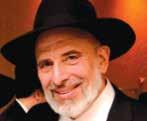
and Horav Yitzchok Meir Schorr zichronom l’vracha, esteemed Marbitzei Torah of the Yeshiva for decades.
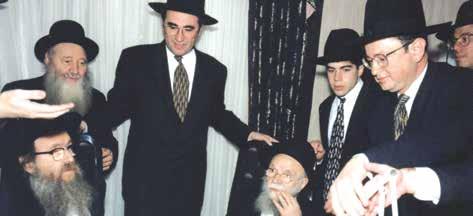

Mr. Avrohom Biderman, talmid muvhak of Rav Pam, will receive The Rav Pam Lifetime Legacy Award at the The Siyum Celebration / 104th Annual Dinner. Rav Moshe Bergman, Mora D’asra Khal Bnei Avrohom Yaakov, will serve as Chairman. The Dinner will also recognize how the Yeshiva and Rosh Hayeshiva’s impact flourishes 25 and 50 years later with awards being presented to Rav Moshe Lewanoni, Kollel Nachlas Dovid Kesser Torah Award, and Mr. Shuli Halpert, Avodas Hakodosh
Award, representing the Class of 1973. Rabbi Moshe Blumenfrucht, Mechina Ohr Yona Marbitz Torah Awardee, and Mr. & Mrs. Yaakov Halpert, Parents of the Year, are accepting awards on behalf of the class of 1998.
For Torah Dedications, Ads and reservations please reach out to the Yeshiva’s Dinner office – 718-941-8000 / Dinner@ torahvodaath.org / www.torahvodaath.org
Join in celebrating Gadlus together on Rosh Chodesh Sivan, Sunday, May 21, at the Palace – k’ish echad b’lev echad. We will welcome Matan Torah with Gadlus!
On the night of Monday, April 24, 260 HAFTR Middle School students and their families gathered at Beth Shalom for a meaningful Yom Hazikaron Tekes. The event was opened by Mr. Joshua Gold, HAFTR principal, and featured messages about Yom Hazikaron delivered by 6th, 7th, and 8th grade students.
Students learned about the Yom Kippur War, and the audience watched videos featuring Hebrew songs relating to the messages of Yom Hazikaron. The Te -
kes was a somber yet educational experience for the students.
Students learned a lot from the Tekes, including about the fallen soldiers who have given their lives to protect the land of Israel and its people. They also gained an understanding of the sacrifice and loss that comes with protecting Israel.
Parents in attendance were moved by the ceremony and impressed with the depth of understanding their children had gained. It was clear that the Tekes had left a lasting impression on the stu-
dents and their families.
It is essential for young people to understand the importance of remembering those who have fallen in battle. The Yom Hazikaron Tekes at Beth Sho -
lom provided an opportunity for HAFTR Middle School students to gain a deeper appreciation for the sacrifice and bravery of Israel’s fallen soldiers.

Zvi Ryzman will receive an honorary degree and serve as commencement speaker for Touro University’s Lander Colleges. The graduation will be held on June 4 at Lincoln Center in Manhattan.
Ryzman joined the board of Touro University 20 years ago and has served as Chairman of Touro since 2020, supporting the vision of Touro Founder Dr. Bernard Lander and the university’s growth and expansion under current President, Dr. Alan Kadish. He is passionate about promoting the value of higher education, both as a means of earning a livelihood and becoming citizens of the world.
Ryzman is also president and CEO of American International Industries, one of the largest manufacturers and importers of cosmetics and beauty products in the world. His company sells wholesale to beauty suppliers and retailers in the U.S. and around the world.
Winner of the Jerusalem Prize for Torah Literature, Ryzman is the author of numerous Hebrew seforim and English language Jewish titles, including a series called Exploring Modern Halachic Dilemmas and one entitled The Wisdom in the Hebrew Months, both published by Artscroll. One of his seminal works is an in-depth exploration of the halachos pertaining to fertility treatments and organ transplantation. This and a myriad of other topics are at the core of Ratz KaTzvi, a 21-volume series on Jewish law and thought.
“A role model for integrating a life of Torah study and stellar achievements in the business world, Zvi Ryzman is a true Renaissance man,” said Dr. Alan Kadish, Touro President.

A highly successful businessman and noted philanthropist, Ryzman spends much of his time studying and teaching Torah to audiences all over the world.

Ryzman spent his early years in Europe and moved to Israel as a school age child, growing up in Tel Aviv. He studied in the famed Chevron Yeshiva and also
served in the Israel Defense Forces. Ryzman earned a degree in political science and economics at Tel Aviv University, as well as rabbinic ordination from Rabbi Yechezkel Sarna of the Chevron Yeshiva.
He says he owes his success to his father, Rav Yehoshua Heshel Ryzman, who exemplified the values Ryzman has adopted throughout his life and career. Ryzman’s father learned in various Yeshivos in Poland, ultimately becoming a long-standing talmid in the Chabad Lubavitch Yeshiva in Otzvozk. He was subsequently appointed Rosh Yeshiva at the Yeshiva’s branch in Warsaw.
After suffering the brutality of the Nazis in labor and concentration camps, he ultimately arrived in Israel, pursued a secular education at Tel Aviv University, and entered the business world, buying a flour mill that the family still owns and operates today.
“My father never stopped teaching Torah while pursuing knowledge and earning a living. That was his legacy to me,” says Ryzman. “I learned from him that if you want to stay grounded in Torah, you need to give a shiur and teach others so you yourself can learn in depth. I never call myself a rabbi, I am an ish asakim, a businessman who learns and teaches Torah every day. The Torah teaches everything, including the right way to conduct business. My Torah study has sharpened my mind and contributed to my ability to think strategically in business.”
Ryzman urges today’s young people to remember their past and their roots.
“Take your values and your parents’ teachings with you as you enter the professional world, and you’ll succeed in the present and into the future.”

The Yeshiva of Central Queens celebrated Yom H’Atzmaut and commemorated Yom Hazikaron with a bevy of meaningful programming, speakers, and activities throughout the week.
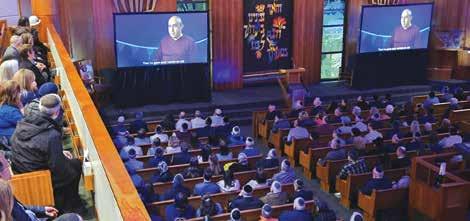
The first taste of the jam-packed schedule began on Friday, April 21, when the Junior High School had the incredible opportunity to hear from Sivan Rahav-Meir, a renowned Israeli journalist and lecturer. She gave an inspiring talk, sharing her personal story, the beauty of Shabbat, and finding one’s purpose in life.
She told the students that they all have something that they are good at and they must use the special gifts Hashem gave them to help their communities and the world at large. She described how one needs to focus on the positive aspects they possess, noting that the mitzvah of “V’ahavta l’rayacha kamocha” requires one to love themselves, too.
She then explained how she grew up
in a secular home in Israel and only met religious people for the first time when she was 15. She was invited to spend Shabbat at their home in Be’er Sheva and was blown away by the experience. Ms. Rahav-Meir explained that those two words “bo’ee l’Shabbat,” “come for Shabbat,” changed her life. The experience led her to becoming more religious and shaped the person she is today.
On Tuesday, YCQ marked Yom HaZikaron with special ceremonies in honor of the fallen soldiers and victims of terror. Grades 3-8 watched powerful video stories, took part in tefillot, and heard reflections from Rabbi Landsman. Students also participated in various activities throughout the day to honor the memory of those who gave their lives for Israel, including writing letters to families of those whose lives were lost.
The next day, Yom Ha’Atzmaut, was a day like no other. After davening, the entire school ventured outside to the yard to partake in YCQ’s annual school-wide



musical Hallel. Nearly 1,000 students and staff members sang and danced to thank Hashem for the gift of Medinat Yisrael. Led by JHS Rebbe and Jewish Music Star Rabbi Ophie Nat, the sea of blue and white was a remarkable display of achdut and hoda’ah.
Throughout the day, students also participated in smaller chagigot filled with more music and dancing. In addition to all the musical festivities, special lessons, games, and activities connected to Eretz Yisrael took place all around YCQ.
After months of preparation and research, Grade 8 girls hosted a Zionist Heroes Exhibition, where they displayed projects in Hebrew that focused on different heroes of the Zionist movement including David Ben-Gurion, Golda Meir, and Rav Kook, to name a few.
Students throughout the school had the opportunity to visit the Exhibition in the Multi-Purpose Room. Morah Mashie Kopelowitz and Morah Lital deserve tremendous credit for organizing the event.
Students in the Junior High School also had the opportunity to decorate posters and props for the upcoming Celebrate to Israel Day Parade and partake
in an exciting Israel-themed Family Feud game show hosted by Mr. Jacob Grossman.
In the Elementary school, some activities included Morah Fried’s students researching different cities in Israel and learning all about the amazing attractions and historical significance of areas throughout the land. Morah Reut’s classes designed their own Israeli flags. Students had a great time putting their own twist on the traditional flag and presenting it to other classes.
The Early Childhood Program had an amazing hands-on day of their own. Nursery students boarded an El-Al flight to Israel. They visited Yam Hamelach, where they floated on saltwater, the Kotel, where they davened, Tzfat, where they made artistic creations, and the Israel museum, where they got to show and tell personal items from Israel. Kindergarten had its own trip to Israel, too. They bought items at the shuk with their shekalim, davened at the Kotel, used candles to paint, and planted new plants. And, of course, students enjoyed delicious blue and white cookies! Thank you to everyone who made the day so special. L’shanah habah B’Yerushalayim!
 By Nathaniel Faber
By Nathaniel Faber
Last Tuesday evening, Bnei Akiva of the US & Canada celebrated Israel’s 75 birthday throughout the United States, Canada and Israel. From Cleveland to New York, from Chicago to Houston, from Detroit to Toronto, our entire movement came together in each respective community to celebrate Israel and her independence. Bnei Akiva’s BAbayit (young professionals) in the Upper West Side put on their annual Tekes Maavar, the transitional ceremony from Yom HaZikaron to Yom HaAtzmaut, in conjunction with the West Side Institutional Synagogue. The ceremony included moving performances from Chazanim all across the Upper West Side, inspirational words from WSIS’s Rabbi Daniel Sherman, a keynote delivery about the fallen and wounded soldiers I served with — Sgt. Yosef Cohen, Sgt. Yovel Mor Yosef, and Sgt. Netanel Felber — and a moving address from Bnei Akiva’s Executive Director, Rav Shaul Feldman, who spoke about his father who is a survivor of the Shoah and his visit to the Dee family’s shiva. The Yom HaZikaron memorial program was incredibly moving and powerful and was a beautiful tribute to the fallen soldiers and victims of terror who have stood to protect our homeland. We then transitioned into a celebratory Tefillah Chagigit led by the talented Joseph Quintas, which finished with a concert led by Eitan Katz — a perfect way to celebrate Israel in her 75th year.
The concert by Eitan Katz launched a series of concerts Bnei Akiva is putting on to celebrate Israel’s 75th throughout the year. This coming year, we have Joey Newcomb, who will be conducting a summer tour visiting our Moshava Ba’Ir day camps throughout the U.S. & Canada, including a concert for the newest day camp Moshava Ba’ir Long Island on the HANC Uniondale campus with campers joining from all throughout Queens & Long Island (Merrick, Great Neck, Ros-
lyn, Five Towns, Oceanside, West Hempstead, Plainview, Mineola). The highlight of Bnei Akiva’s concert series will take place at Madison Square Garden with Ishay Ribo’s Elul Concert on September 3, 2023.

We chose to do a concert series to celebrate Israel’s 75th year for the simple reason that we believe that song is one of the best way to connect with our past, celebrate our present, and look to our future. It is song that brings us closer to Hashem. It is song that unites us as a nation. Throughout Tanach, celebration and triumph, and sorrow and rebuke are expressed through poetry, through song. When Bnei Yisrael crosses the Yam Suf, it is through song they express their gratitude; when Devorah and Barak defeat Sisra in battle, their triumph is recorded in song; when Yirmiyahu oversees the decay of Jerusalem, he expresses his rebuke and his pain through song; and when Yeshayahu prophesizes of the pain Jerusalem is in, but the ultimate return to her grandeur and splendor, he does it through song. When we want to connect most to HaKadosh Baruch Hu, we do it through song: whether a medieval piytan writing our liturgy for Yom Kippur or closing off a Shabbaton with a classic Bnei Akiva slow shira.
As we look back at the 75 years of Israel’s independence, we acknowledge those that paid the ultimate price for us to stand here today. We acknowledge the miracles that have taken place for us for our little homeland to continue to exist and flourish. We acknowledge our ancestral connection to the land and the promise Hashem made to Avraham 4,000 years ago. We acknowledge the bright future we have ahead of us; and there is no better way to give thanks, to mourn, to connect, to grow than through song. As the anonymous medieval poet writes in the famous zemer, Tzur Mishelo, “[When] He rebuilds the Temple/ [when] the City of Zion is restored/ there, we will sing a new song/ and in joy ascend.”

Last Tuesday evening, Mesivta Ateres Yaakov held its annual Arista Honors Installation and Awards Night, at which tribute was paid to the myriad accomplishments of the MAY Talmidim. MAY’s Arista program is particularly special, as it commemorates Rabbi Elchonon Zomber, z”l, a MAY alumnus and veteran teacher. The Zomber family graciously endowed the MAY Arista Society in his honor.
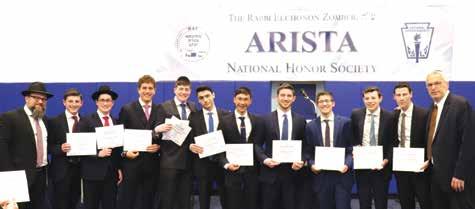
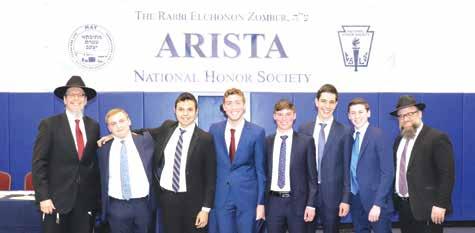
Consistent with MAY’s emphasis on developing all of each Talmid, excellence in many areas was recognized: Limud HaTorah, Tefillah, Middos, Academics, Athletics, Extracurricular Activities and Community Service. Awards were presented to over 100 students for excellence and progress in these areas.
The Rosh HaYeshiva, Rabbi Mordechai Yaffe, introduced the program, focusing on the small acts of greatness per-

formed by MAY talmidim that can often go unnoticed. He noted how the Mesivta not only engenders these acts, but also tries to publicly recognize them. Rabbi Yaffe was joined by Menahel, Rabbi Yossi Bennett, and General Studies Principal, Rabbi Sam Rudansky, in presenting the awards of the evening.
Rabbi Rudansky commented, “The evening serves as an opportunity to recognize those students who excel in different areas of the high school experience. That may be academics for some, community service, extracurricular activities and even athletics for others. It’s an evening of tremendous nachas for parents and grandparents.”
The evening closed with the induction of close to 80 Arista honors students and lots of pictures and nachas being shared. Mazal tov!
Did you know?
The oil to be used at King Charles’ coronation comes from olives from Mount of Olives in Jerusalem.
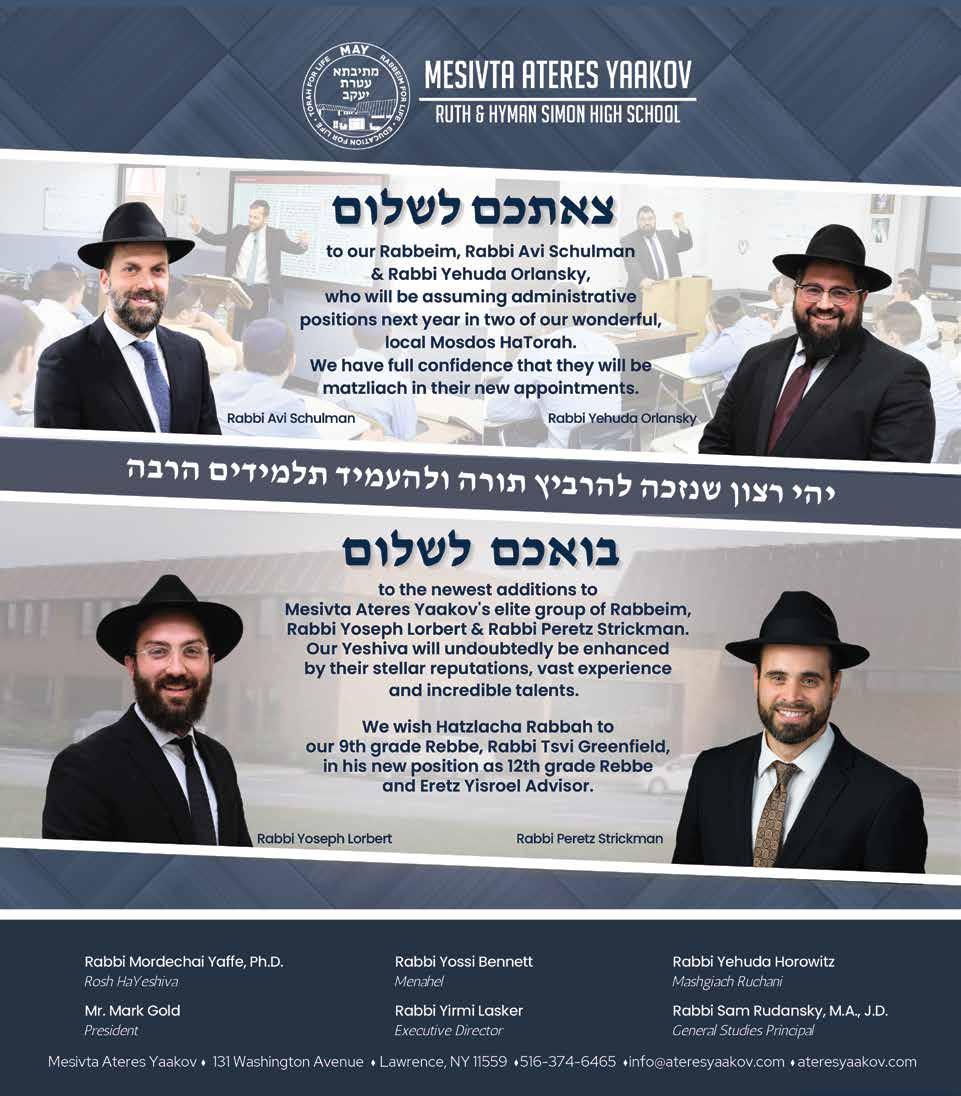


Perhaps the most central skill to a Jew and budding talmid chacham is his ability to read and have a comprehensive knowledge of Lashon Kodesh. To this end, all three third grade classes at Yeshiva of South Shore competed in a Milim Bee that they had spent many months learning and reviewing for. The bee consisted of 188 shorashim. The boys who made it into the bee had to answer Hebrew to English translations
within a five second span, and, as the bee progressed, the timer was reduced to four seconds and translating from English to Hebrew. All the other talmidim were incredibly supportive of the competitors and displayed wonderful sportsmanship and middos. It was a fantastic opportunity for the boys to display their milim skills and demonstrate what their rabbeim had taught them.
Mazal tov to Aaron Rabin, Menachem

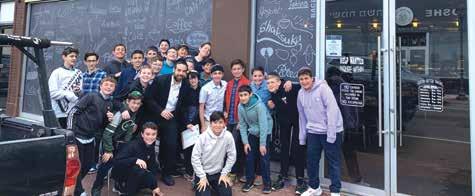
they will all continue to grow in their knowledge and understanding of Torah!
The day started like any other at the YOSS Mechina. After breakfast, the 7th graders went into shiur, when suddenly Rabbi Yitzy Haber, TiC Commissioner, ran into the room and announced, “All Tech-in-Check members come with me right now!” The bewildered group rushed into the hall and joined the rest of the 7th grade Tech-inCheck members, and before they knew it, they were on their way to the bagel store in recognition of their incredible achieve -
ment in keeping their tech in check! These boys have shown amazing resolve in joining and keeping to a technology program that is literally changing their life and effecting their entire family. That is something worth celebrating ... even during yeshiva hours! Rabbi Zev Davidowitz, Menahel of the Mechina Division, explained that Rav Shalom Kamenetzky, shlita, instructed them to shower the boys who join TiC with prizes and rewards because “the pull of technol-

ogy is so strong that we need to counter it with everything that we have.”
There are currently more than 250 boys who have signed up for this amazing initiative, and Rabbi Haber keeps them guessing when it comes to celebrating their success. In fact, just last week, he rounded up 35 6th graders and took them
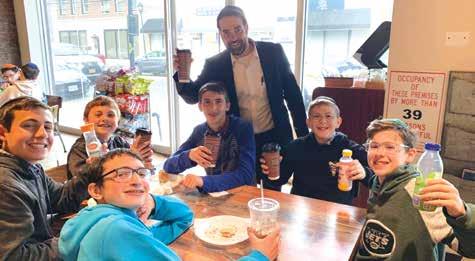
bowling, and this week, he ordered an ice cream truck to stop by YOSS and gave out ice cream to all TiC members. These boys are successfully battling the challenge of the generation and are enjoying the fruits of their labors... and bowling, bagels and ice cream, too!
Last week, Rabbi Leibe Wolf, 10th grade Rebbe at Mesivta Ateres Yaakov, took his shiur on an outing visiting rabbanim in Brooklyn. The bochurim had audiences with Rav Avrohom Schorr, Rav Moshe Tuvia Lieff, and
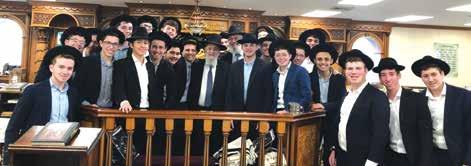
Rav Shimshon Sherer, heard divrei Torah from each one and received brachos as well. Talmidim returned to Yeshiva energized and inspired to continue in their shteiging!

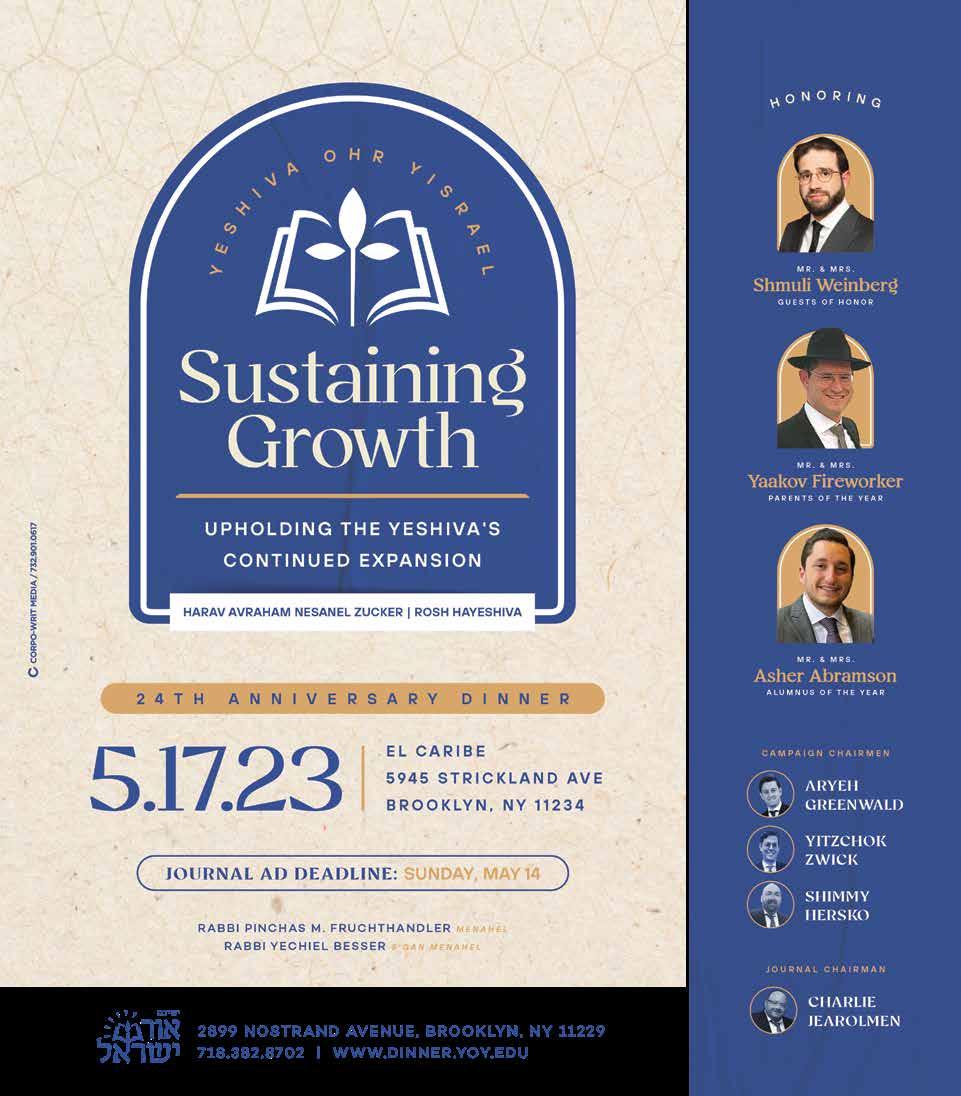
Five Holocaust survivors will share their testimony, two for the first time, in a documentary created by students from the North Shore Hebrew Academy, at a screening open to the public on May 30.
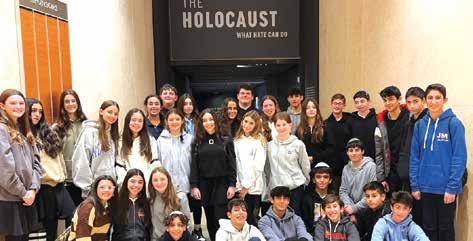
The project, Names, Not Numbers, invites students to learn how to create documentary films, including researching, recording and editing, as they share the stories of Holocaust survivors with the community. More than 50 schools and universities around the world participate in this program. NSHA has hosted the program for the past eight years; this year, 34 NSHA students were involved.
Students are required to apply for the year-long program, since it demands a significant amount of independent work. During the program, students work with a number of professionals, including museum curators, journalists and videographers.
Dr. Paul Radensky, the Senior Director for Education at the Museum of Jewish Heritage, meets with the students after they take a tour of the museum. The tour provides background information about the Holocaust, including specific information or situations that might be relevant to the stories the survivors will
share and also demonstrates the importance of preserving first-person testimony for the public.
After the interviews, a professor from Yeshiva University visits the class for an “emunah” or “faith” session, during which the students process the experience and share their sometimes emotional responses.
“It’s so difficult to teach kids about the Holocaust, because the subject is challenging, and it’s nearly impossible to grasp it by reading about it second-hand,” explained Mrs Lisa Guggenheimer, who has led the Names, Not Numbers project at NSHA since its introduction in 2015. “But when they sit across from a Holocaust survivor, ask questions, and hear the stories firsthand, it opens their hearts in a very meaningful way.”
Ms. Guggenheimer noted that, for the most part, the survivors were children during the war, which can be jarring as the students imagine themselves in that situation. “Suddenly, the students realize, ‘They were my age when this happened to them,’” she said. Survivors shared incredibly difficult moments from their life, including watching their parents perish in front of them, getting deported to concentration camps, being sent away on Kindertransport or being hidden and
never seeing their families again.
“It’s so much easier to emphasize and understand the history and the enormity of the tragedy, when speaking directly to the person who experienced it,” Ms. Guggenheimer explained.
“The project also highlights the importance of primary source documentation, especially during a time when social media has blurred so much of what’s real and what’s not.” Ms. Guggenheimer added. The students explore the idea of Holocaust deniers and how primary source documentation can refute false information and shed light on what really happened.
The final product is a documentary
 By Lilly Rotman
By Lilly Rotman
The excitement was palpable as students from grades 9-12 gathered in the HAFTR High School auditorium, ready for a day of activities and celebration in honor of the 75th birthday of their own Jewish state, Israel. As students arrived at school on Tuesday, April 26, they began the day with a beautiful davening, which then led to a full day of festivities and a school-wide grade competition. Each grade represented a different Israeli city: Jerusalem, Teverya, Tzfat, and Chevron. The day promised a series of competitive sports, games, music, festivities, and a delicious lunch.
The events kicked off with a schoolwide Chidon Eretz Yisrael–a Kahoot game all about Israel. Enthusiasm was high as each student competed for their team, and then traveled to North Wood-
mere Park and participated in various sports. The colors of blue and white shined bright, along with an array of colorful t-shirts assigned to each grade. The highlight of the celebration was the friendly competition and fierce battle of strategy between the grades. Students played a series of games including softball, tennis, spike ball, racing, and more. The beautiful weather only added an extra layer of joy to the event. The sun shone bright with a cool breeze, making it a perfect day for outdoor activities.
After the many activities, students fueled up and enjoyed a delicious Israeli-style lunch of falafel, schnitzel, pita, Israeli salad and more, followed by an exciting raffle offering great prizes. As the sports began to wind down, art students in each grade displayed a beautifully painted banner representing their team’s Israeli city, demonstrating their creativ-
ity and effort. The program didn’t end there; before returning back to school, students and teachers gathered around the baseball field for a faculty-student softball game. Laughter and smiles captured the spirit of the game and spectators cheered in support.
Overall, the day was a huge success as students gathered together to celebrate
that weaves together the testimony of all five survivors as well as the students’ emotional journey throughout the program. The documentary will premiere after a celebratory dinner for the participants and their families along with the survivors on May 30. It will also be archived at Yad Vashem, the National Library of Israel in Jerusalem, and the Mendel Gottesman Library at Yeshiva University.
The project has grown from 16 students the first year to 34 students participating this year. The entire experience can also be one of healing for the survivors.
their love for their Jewish state. The Yom Ha’Atzmaut festivities and games brought everyone together in a friendly, competitive atmosphere and highlighted great sportsmanship. This was the first HAFTR Maccabiah grade war, and looking at its success, it certainly will not be the last.
Organizing educational, meaningful, and entertaining programming for Yom Ha’Atzmaut in Jewish day schools always poses a unique challenge. To tackle this challenge, DRS Yeshiva invited four “surprise guests” from Eretz Yisroel on this year’s Yom Ha’Atzmaut. Each “guest” shared their unique background and perspective on the establishment of Medinat Yisroel, the State of Israel.
The “surprise” came when the students were addressed by the four individuals, each entertainingly portrayed by Rabbi Natan Farber, a beloved and cre -

ative Rebbe at the school. Rabbi Farber became Rabbi Yehuda Eisenbach from Meah Shearim, Rachamim Mizrachi from Tel Aviv, Dr. Artie Bernstein from Woodmere, and Ilan Ben-Ami from BetEl. Each “guest” was interviewed by the Menahel, Rabbi Yisroel Kaminetsky, who pressed the students after each interview to hear their thoughts on the opinions of perspectives of the characters. The event was able to provide a valuable insight into the diverse opinions and thinking of all different types of Jews in a fun and creative way.
Yom Ha’Atzmaut is an incredibly special and meaningful day. It is never too early to start fostering a love of Israel in children. HAFTR’s Early Childhood put on an incredible Yom Ha’Atzmaut program on Wednesday, April 26 so that children as young as two and three could experience the specialness of the day.
The children, parents, and morot all wore blue and white. Even the school was decorated from top to bottom with blue and white balloons and Israeli flags. First, the yeladim marched in a mini-parade as they proudly waved their hand-made Israeli flags. Then everyone

rejoined as a group to sing all the wonderful songs that Morah Leah taught students about Eretz Yisrael. Parents, grandparents, and even great-grandparents joined in the singing and dancing. Afterward, students went on a tiyul to join their big sisters and brothers for a school-wide celebration.
During the day, the Early Childhood Department had special Maccabiah games with Morah Naomi. An Israeli-style lunch was provided to all of the children by the PTA. In the afternoon, the Pre-K children took their passports and boarding tickets and went on an imaginary trip all the way to Eretz Yisra-
el. One of the highlights of their trip was visiting each other’s classes (museums) to observe the Israeli artifacts each child brought from his/her home. Finally,
The celebration and reflection of spring continued at Central on Yom Hazikaron and Yom Ha’Atzmaut. Tuesday’s focus was one of education and remembrance. Central students heard from a former Israeli soldier, Shahaf Segal, about his service experience. The students responded to the warmth and humor in Mr. Segal’s delivery, as well as his core message. The day was made even more significant when Central’s very own Maayan Berman, a member of the class of 2019, shared her experience in the Israel Defense Forces with students. The day also featured singing from the Central choir, as well as a malawach sale, courtesy of Central’s Cooking Club, launched in order to raise funds for the Friends of the Israel Defense Forces.
The festivities didn’t stop there. On Tuesday evening, Central marked its very first Yom Ha’Atzmaut community event with a dinner and a concert featuring Moshe Tischler. Students worked hard to put their special touch on the building decor. It was a roaring success, and the first annual event of many to come.
It was followed by Yom Ha’Atzmaut on Wednesday, a day of activities and fun that students anticipate every spring. Events included Israel-specific sessions, such as “The Cities of Tanach,” “What is Religious Zionism?”, “The Story Behind the Blue and White Cookies,” “My Summer Visiting Palestinian Villages,” and “STEM with ROOTS.” Of course, no Yom Ha’Atzmaut Day at Central would be complete without “Basic Army Training,” a high-octane activity round involving
sprints, chin-ups, and plenty of festive blue and white gear. Another time-honored activity: a round of Israel Jeopardy, in which students competed to answer questions covering Israeli history, politics, and culture. For seniors, whose last official day of class was Thursday, April 27, it was a last opportunity to bond with their classmates. After a triumphant
Did you know?
each class made a special blue and white birthday cake just for this wonderful occasion.
round of Jeopardy, senior Emily Froehlich said, “Big shoutout to Mr. Isaacs, who is really cool and who taught us most of this!”
In all, these two days provided Central with the chance to remember and celebrate its commitment to the homeland, which is additionally significant as Central celebrates its 75-year anniversary.
The anointing of a new monarch in England with chrism oil is considered sacred and is closed to the public.

As is the custom at HANC Elementary School in West Hempstead, the fourth through sixth grade students and teachers gathered on the morning of Yom HaZikaron to remember and honor the fallen soldiers who paid the ultimate price in defense of our beloved State of Israel. The program began with remarks from Rabbi Ouriel Hazan, Director of HANC West Hempstead campuses. The crowd then stood and sang Hatikvah together. Rabbi Hazan then shared a video from the Friends of the Israeli Defense Forces, which explained what life is like for a “Chayal Boded,” a
lone soldier who came to Israel without their family to serve in the Israeli army. Featured in the video was David Golombeck, a sergeant in an infantry brigade and the brother of Mrs. Lisa Lowy, our Admissions Director, and the uncle of three HANC students. In a heartfelt speech, David explained how he transformed from a typical American teen to a soldier in the army. The crowd was deeply moved by his words and gave the children a strong sense that we all must do our part to help and protect Israel, in any way that we can.
Mrs. Barbara Deutsch then spoke
about the Dee family, which tragically lost their wife/mother and two daughters in a terrorist attack. The crowd then viewed videos of Rabbi Dee bravely declaring that they do not regret moving from England to Israel and encouraged everyone to live a religious life and do one additional mitzvah each day.
The program concluded with the lighting of memorial candles.

The following day, the celebration of Israel’s 75th year of independence began with great fanfare. With Israeli music emanating from the lobby, the children streamed through the doors, creating a sea of blue and white outfits. During the course of the day, the children explored the map of Israel, traversing a huge floor map while searching for sites of interest from North to South. They visited Machaneh Yehuda, the “Shuk,” where they found many booths and enjoyed tasting treats like pickles, olives, grapes, rugelach, ice cream, popcorn and Israeli fruit juices. With Israeli music playing, and a virtual tour of the Shuk displayed on a jumbo-sized screen, the children truly felt as if they were actually in Machaneh Yehuda. Even the Nursery Bet children had a chance to visit the Elementary School and tour the Shuk, the map, eat an Israeli treat, and have some fun time on the playground, wearing their adorable handmade Yom Ha’Atzmaut crowns. The family reunions amongst the siblings and
cousins who were delighted to see each other were priceless.
The next stop was a visit to the Pita Bakery. Under the leadership of Morah Vered Sharoni, Chairperson of the Hebrew Department, the Ivrit staff helped the children flatten balls of homemade dough into pitot, and watched as the pitot baked. Once the pitot were finished, the children poured olive oil and zaatar on top of their hot pitot and truly enjoyed tasting this very Israeli treat that they proudly made themselves.
At the conclusion of this action-packed day, the entire school, along with the students and staff from the Middle School, joined their parents and grandparents in the backyard for the culminating event. Following a meaningful Yom HaAtzmaut ceremony, the singing of Hatikvah, a salute to the Guttman family who will be making Aliyah this summer, and a performance by the baton twirling Color Guard, the HANC family was treated to a riveting performance by music superstar Eitan Katz
Hakarat hatov goes to the administration, Mrs. Daniella Hirt, Student Activities Coordinator, Mrs. Lisa Lowy, and all of the teachers who helped and guided the children throughout the day to create this most meaningful Israeli experience.





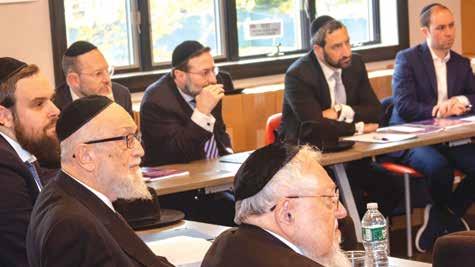
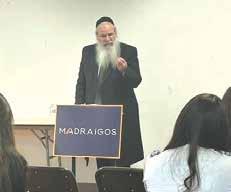
On Sunday, April 23, Madraigos held their Second Annual Q & A Session For Mental Health Professionals with Rav Sholom Kamenetsky, shlita, Rosh HaYeshiva, Talmudical Yeshiva of Philadelphia.

After a brief welcome by Rabbi Dov Silver, Founder and Executive V.P., Madraigos, Rav Sholom addressed questions sent in beforehand by attendees regarding pressing mental health issues. Topics included yichud within the therapy room, the obligation of kibbud av v’em in abuse situations, the use of AI and Chat GPT, and other timely issues. With every question he answered, Rav Sholom underscored that every situation is case-specific and therefore precise hadracha is needed in each scenario.
Rav Sholom’s breadth of knowledge and keen understanding of people made the event informative for the attendees who left feeling educated, inspired, and invigorated to continue helping their cli-
ents within a Torah framework.
One therapist remarked, “I’ve been waiting for this event since last year. I’m in awe at how much Rav Sholom knows both in the world of Torah and the world of psychology.” Another therapist in the community noted, “The session was informative and gave direction to therapists on therapy in the framework of Torah hashkafos.”
Therapists also enjoyed a delicious breakfast and the valuable opportunity
to network with each other, share ideas, and strengthen professional relationships.
The depth and clarity of the Rosh Yeshiva was refreshing and inspiring. Mindi Werblowsky LCSW, Clinical Director, Madraigos, commented, “We want to thank all of those who attended the program and submitted their questions to the Rosh Yeshiva. We are thrilled to hear the tremendous positive feedback from all of those who attended.”

On April 23, community rabbanim from Far Rockaway and The Five Towns gathered to hear from Harav Sholom Kamenetsky, shlit”a, Rosh Yeshiva of Talmudical Academy of Philadelphia, and Dr. Eli Shapiro, founder of KETER (Kehila Technology Education Resources) on the topic “What Every Shul Rav Needs to Know About Technology.” The program, which took place at The Consortium of Jewish Day Schools in Cedarhurst, brought rabbanim up to date on the many opportunities and challenges that technology presents for individuals and families and the latest research on its impact on social, psychological and behavioral functioning. Dr. Shapiro gave a live demonstration of Open AI’s ChatGPT and explored the specific struggles that rabbanim were seeing their kehillas.
Born out of the excessive technology engagement that COVID, KETER was established to help schools and communities develop a comprehensive technology strategy by serving as an umbrella for community resources and a guide for best practices. KETER’S partner organizations include Project Focus, MUST, kPhone, The Digital Citizenship Project and more. As part of KETER’s communal work the Far Rockaway Five Towns,
“Tech Smart” initiative was developed with an anticipated start this coming Elul with a Project Focus community event on September 10, 2023. KETER will be working to streamline school initiatives with shul support and reinforcement to approach responsible technology use on a communal level that will be a model for cities across the country.
Local schools that have signed up for the initiative include Bais Yaakov of The Five Towns, B’nos Bais Yaakov, HAFTR, HALB, Shulamith, Torah Academy for Girls, Yeshiva Darchei Torah and Yeshiva Ketana of Long Island.
At the event for rabbanim, R’ Sholom Kamenetsky, shlit”a, reinforced that while we recognize that internet based technology is ubiquitous and ever expanding, we need to match its growth in addressing the challenge and not becoming complacent. The Rosh Yeshiva fur-
ther expressed the support of his father R’ Shmuel Kamenetsky, shlit”a, for KETER’s Tech Smart initiative and his understanding that rabbanim have different constituencies and the approach for each kehilla needs to be different.
“KETER’s goal is to provide the resources for community institutions to make thoughtful and strategic decisions around technology,” said founder Dr. Eli Shapiro. Whether through educational programming or practical device management events, every shul can do something. Dr. Akiva Bergman, founder of TAG (Technology Awareness Group) of the Five Towns, shared with the rab -
Madraigos extends a sincere hakaros hatov to Rav Sholom for dedicating his time to benefit the 5 Towns/Far Rockaway community and for guiding the mental health community at large.
As always, Madraigos is here to provide services to all segments and facets of the community in a way that appropriately meets their needs. For suggestions regarding future programs, please contact Mindi Werblowsky at mwerblowsky@madraigos.org.
banim the details of a recent successful event that took place at The White Shul. The event drew hundreds of attendees that benefited from more than 15 vendors providing practical advice and guidance for managing devices.
Dr. Shapiro concluded, “We look forward to following a multiple resources model and bringing more programs and opportunities to the community through partnerships with the shuls and schools starting with our event on September 10.”
For more information, visit ketertech. org.
It is well known that Shulamith School for Girls was created by religious Zionists who were proud to build a girls’ school that supports Israel. To this day, Shulamith gives that value utmost importance and continues to instill a love of Eretz Israel in each of their talmidot.

Yom Ha’Atzmaut celebrations at Shulamith started with a beautiful Hallel b’Yachad, followed by a video presentation featuring former Shulamith families who made Aliyah.
During the course of the day, students from grades 1-5 went to an Israel fair that featured 7 main themes of Israel. The girls learned about Tzahal and wrote letters of Hakarat Hatov to the Chayalim. They learned about the holy sites of the country, the uniqueness of Israel’s agriculture and irrigation system, the archeological digs and how Israel is constantly uncovering more artifacts from our history. They also learned how Israeli Shekalim differ from American currency, and experienced all the spices and some of the yummy food the Shuk has to offer.
Finally, the girls learned about Nefesh B’Nefesh, and what an amazing job they do of helping people’s dreams of moving home to Israel come true.
Grades 6-8 enjoyed other programs throughout the day including Ta’am Shel Israel – A Taste of Israel. The students split up into groups and competed by creating an Israeli salad, a falafel and decorating a cake with an Israeli landmark or theme.

They also played a fun and educational Panopoly game that tested the girl’s knowledge of Israel. The trivia questions included topics ranging from Chief Rab -
What an uplifting and beautiful experience!
This Sunday, TAG’s Alumni Program, in collaboration with Pair 2 Peer Shidduch Initiative, organized a tour of the kevarim of holy tzaddikim buried right here in Queens, NY. The tour was led by Rabbi Eliezer Krohn and Rebbetzin Aviva Feiner. Post-high school girls from TAG and other schools were invited to join in on this day of tefillah. The heavens opened up to hear their prayers, and to rain down holy Iyar water! Kol hakavod to all the special girls who participated, rain or shine!
The tour began at Mount Judah Cemetery, at the kever of the esteemed Rav Pam and his Rebbetzin, zt”l, former Rosh Yeshiva of Torah V’daas. They also visited Rav Henoch Leibowitz and his Rebbetzin, zt”l, former Rosh Yeshiva of Chofetz Chaim. Rav Yaakov Kaminetsky and his Rebbetzin, zt”l, as well as the Chofetz Chaim’s second Rebbetzin, zt”l, were also buried in close vicinity. Rabbi Eliezer Krohn spoke beautifully on these Tzaddikim and Tzidkaniot, their middos, stories, and ways we can strive to emulate them.
The tour continued in a separate cemetery, the burial place of Rav Yaakov Yosef, zt”l, the former Chief Rabbi of New York, who came to America to do Hashem’s will and eventually passed away from humiliation and heartbreak of the slander that was circulated against him and his family by local Jewry. Hundreds of jews visit his Kever every year on his yahrtzeit, Kaf-daled Tammuz, and many have seen yeshuos from these prayers by the grave of a tzaddik with a broken heart.

Thank you again to the TAG Alumni Program and Peer 2 Pair Shidduch Initiative for sponsoring this event. Hashem should answer all of their prayers l’tovah b’karov!
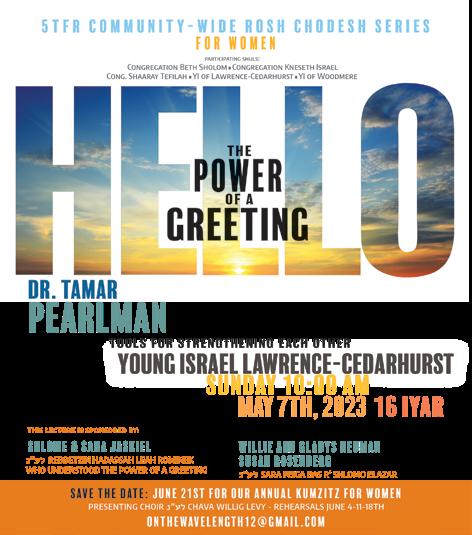
bis of Israel to Israeli foods, geography to Israeli culture. Each student then wrote what Israel means to them on little hearts, which were collected to become part of a larger heart, which will be displayed on the walls of Shulamith forever.
During lunch, each student enjoyed a special treat of Rita’s blue and white ices!
The festivities concluded b’Yachad, with grades 1-8 heading outside to watch the 8th grade Daglanut, followed by dancing. A very special thank you to the Shulamith SWO for the yummy blue and white cookies!
Shulamith would like to thank
all the teachers, sponsors, the 8th grade Yom committee and the business office for helping with the myriad of details ensuring that Yom Ha’Atzmaut at Shulamith was such a success!
Thank you Morah Mindy Futersak for organizing the Israel fair, and thank you Ms. Rachel Steiner and the decorating committee for the beautiful decorations that decked the halls. A special thank you to Mrs. Michelle Farbman for the hours of planning, organizing, and collaborating for this wonderful day. We greatly appreciate her efforts and hard work.
Spring has sprung at Shulamith ECC

Students at Mercaz Academy in Plainview celebrated Israel’s 75th birthday with parades, dancing, and fun on Yom Ha’Atzmaut. The day began with Rabbi Fogel’s recitation of the Prayer for the Welfare of the State of Israel, which led to the whole school parading around the school’s bus loop with flags flying high. Many Mercaz families joined the procession, much to the delight of the students. Excited Mercaz pupils sang along to the music as they waved flags, and younger students wore


the crowns and necklaces they had created in preparation for the day. The parade was a joyous one, with live music provided by Mercaz Academy’s music teacher, Craig Resmovits.
Kitah Vav had spent weeks preparing exhibits on five different areas of Israel: Tzfat, Tel Aviv, Haifa, Be’ersheva, and Yam Hamelach (the Dead Sea). These sixth graders researched their areas and put together informative presentations on each city in preparation for Yom Ha’atzmaut, creating exhibit boards
5,000 Mishnayos
HAFTR Mishna Yomi has recently celebrated two major accomplishments. The Mishna Yomi group learns two Mishnayos a day and just made a siyum on Maseches Pesachim. The siyum was celebrated with two parties, one for the middle schoolers and the other for the members in the group that are in 4th and 5th grade. At the siyums, they heard words of inspiration from principal Mr. Josh Gold. They also learned the last Mishna in Pesachim and the first Mishna in Shekalim together with Mashgiach Ruchani Rabbi Asher Klein. The celebration finished with everyone enjoying some special treats. All
Mishna Yomi participants also received Mishnayos Shekalim to learn going forward and a “Mishna Hawks” mug to commemorate the occasion.
The Mishna Yomi group also celebrated reaching the milestone of having learned 5,000 Mishnayos together as a group since Pesachim began on March 15! Parents, talmidim, rebbeim, faculty members, and grandparents have come together to make this initiative a rousing success. The MishnaHawks are excited to watch this number grow as they march towards finishing many more masechtas in the future!

written completely in Hebrew. Students from other grades walked around the room with worksheets, stopping at each board and collecting information about these five areas.
The event culminated with a game of “What’s In My Bag?” Rabbi Fogel and Rabbi Rubel pulled items out of a bag–including a basketball, a tambourine, and a telephone–and students raced to get a card identifying which geographic area had featured something like it. Many thanks to Morah Carmit Akhavan and

As Jews all over the world joined in celebrating the milestone 75th anniversary of Israel’s statehood, Shulamith High School girls traveled back in time to the early days when Israeli life was centered around the kibbutz. The highlight of our annual Yom Ha’Atzmaut celebration, the “Shuk,” featured a variety of kibbutzim from every geographical region of Israel and showcased each one’s unique contribution to their country, from the spreading of Torah emanating from Kibbutz Shaalvim, to the hot, delicious pitas of Kibbutz Deganya, to the furry farm animals of Kibbutz Chofetz Chaim. Students traveled throughout the land, enjoying byproducts of various kibbutz produce and exports.
Celebrations continued throughout the day, culminating in an unbelievable

SHS Gibush. In the span of less than one school day, each grade produced songs, stomps, and intricately designed benches for the SHS grounds, complete with thematic pesukim and artwork. The incredible display of grade unity and fervor made the competition tight, but the Junior “Kibbutznikim” managed to come out on top.
Coming on the heels of Yom Hazikaron, the transition of mourning to the joy of Yom H’Atzmaut always serves to emphasize the enormity of the sacrifice it took to achieve it. This year, in particular, by reflecting on the beginnings of the country we’ve become so accustomed to, we were reminded of the nissim and pioneers who paved the way for us to experience and enjoy our beloved country.

Tefillas HaShelah is the prayer recited by generations of parents, asking Hashem for righteous, successful and happy children. Written over 400 years ago by Rav Yeshaya Halevi Horowitz, every word of the tefillah offers us insights and lessons for life.

In ArtScroll’s new Tefillas HaShelah, bestselling author Yisroel Besser uses stories and classic commentaries to bring the tefillah to life, conveying our hopes and dreams that our children taste the sweetness of Torah and experience the joy of Jewish living – aspirations that the holy Shelah packed into his timeless prayer
In addition to the formal siddur and nusach ha’tefillah, there are various tefillos that, although not mandatory, people choose to recite. Several were composed by Chazal, others by gedolei Yisrael throughout the ages, and sometimes, people feel most comfortable expressing their deepest desires and hopes in their natural language, communicating with the Creator freely.
Depending on mesorah, personality, and need, people vary, but somehow, there is an almost universal consensus here, in the words of the Tefillas HaShelah. Perhaps this is because more than anything else, every parent wants what is best for his or her children, and the best is encompassed by all that the heilege Shelah packed into his timeless
tefillah. Those who are not yet parents find that each line in this tefillah articulates the longing and hope they feel.
Since the Shelah Hakadosh put words to the dreams and aspirations of parents four centuries earlier, the world has changed, then changed again. Different times call for different needs, and the Shelah Hakadosh enabled parents to express different hopes with the words of this tefillah. There were no doubt years when parents pleaded that their children find a safe refuge from the pogroms and massacres claiming Jewish lives. There were certainly times when parents closed their eyes and wished that the allure of Haskalah, the dogma that had stolen the hearts and minds of so many young people, spare their children, leaving them pure and unsullied.
It is not difficult to imagine the shtetel water carrier finishing his rounds for the day, slipping the pails off his tired shoulders and heading straight to shul to say the tefillah. His daughter was getting older; where would he find a suitable young man in the small town? And which young man would choose to marry the daughter of a poor water carrier?
Perhaps these words of the Shelah — the inherent belief in a system in which each soul that is created shares their soul with another — allowed the water carrier and his wife one evening free of worry and stress.
A century ago, parents who had
survived one war, on the cusp of another that they could not even fathom, worried about their children: Did they have a chance in a world filled with such turmoil and fear?
In America, parents who had emigrated wondered if their children, swallowed up by this new land of opportunity, would even know what Shabbos meant. Surely, they davened for those children as if their lives depended on it — because their lives did depend on it.
(The Chazon Ish foretold of the great wave of teshuvah that would sweep across Eretz Yisrael, explaining that a generation of mothers had wept for their children when they lit Shabbos candles, davening that their children — drawn astray by an ideology, an opportunity, a cause, a dream — come back. The tears of a mother, said the Chazon Ish, are never in vain, and those tears became the river that swept back the grandchildren, neshamos pulled by invisible cords.)
Our own grandparents survived and bravely tried to rebuild. They were Jews who understood that forgetting what they had seen would allow them to remember, who found ways to smile at their children even as every infant and toddler resembled someone who had never made it out, who worked to shut out the echo of desperate cries until nighttime, when the house was quiet — then, they whispered a tefillah that their children be able to grow
Tens of lawmakers, captains of business and community leaders converged on Capitol Hill last week to launch the Golda Meir Commemorative Coin Act which will have the United States treasury mint a coin bearing the image of America’s First Israeli Prime Minister – Golda Meir. The initiative is spearheaded by Los-Angeles based real-estate developer and philanthropist Bobby Rechnitz.
This mammoth task will require a two-thirds majority in both houses. It is being championed by Debbie Wasserman Schultz (D-FL) and Andrew Garbarino (R-NY) in Congress, and Ben Cardin (DMD) and Ted Cruz (R-TX) in the Senate.
The event was a bipartisan show of force in support of Israel and the new bill will offer all Washington lawmakers, es-
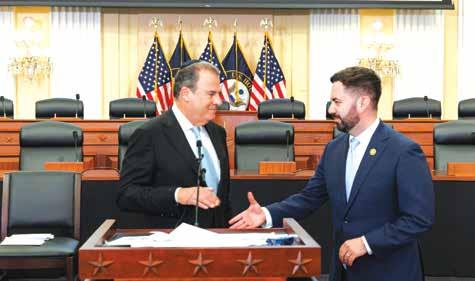
pecially the seven new senators and seventy-four new house representatives, the opportunity to reaffirm their support for Israel.
Among those in attendance were: Steve Cohen (D-TN), Darren Soto (D-FL), Juan Vargas (D-CA), Troy Balderson (R-OH), Buddy Carter (RGA), Brad Schneider (D-IL), Ralph Norman (R-SC), Dan Goldman (D-NY), Jerry Nadler (D-NY), Jasmine Crockett (D-TX), Keith Self (R-TX), Marc Molinaro (R-NY), Eli Crane (R-AZ), Mariannette Miller-Meeks (R-IA), Randy Weber (R-TX), Mike Lawler (R-NY), Debbie Wasserman Shultz, Alma Adams (DNC), Frederica Wilson (D-FL).
Bobby Rechnitz explained how this is an opportunity to position Israel above politics. “Golda Meir was the personifi-
up in tranquility and calm.
And here we are, parents in a generation of plenty. Between the lines of the Tefillas HaShelah, our fears and worries are addressed, our deepest hopes expressed. We are reminded of who we are, where we come from, and why we are here, inspired to sing the song in a way that our children will not just learn it, but live it. May our sons taste the sweetness, our daughters experience the joy.
At the time the Shelah Hakadosh wrote the tefillah, parents hoped their children would live. Today, our hope is precisely the same: that our children live. Really live.

“The English are not happy unless they are miserable.” – George Orwell

“In England, if you commit a crime, the police don’t have a gun and you don’t have a gun. If you commit a crime, the police will say, ‘Stop, or I’ll say stop again.’” – Robin Williams
“The English are not a very spiritual people, so they invented cricket to give them some idea of eternity.”
– George Bernard Shaw“English clubs are very exclusive. I played Royal Foxshire and they made me wear a suit and tie…in the shower.” – Bob Hope
How do you say William Shakespeare in past tense?

Answer: Wouldiwas Shookspeared
“Water is a staple of English cuisine.” – Daniel Darc
“English history consists largely of royal people getting their heads chopped off... Needless to say, this brand of history was a hit with our son.” – Dave Barry
“I now know why the English prefer tea: I just tasted their coffee.” – PierreJean Vaillard

“If you want to eat well in England, eat three breakfasts.” – W. Somerset Maugham
“[England has] everything in common with America nowadays except, of course, language.”
 – Oscar Wilde
– Oscar Wilde
Two Englishmen, two Scotsmen, two Welshmen and two Irishmen were on a plane that made an emergency landing, and they found themselves trapped on a desert island.
The two Scotsmen got together and started a bank; the two Welshmen got together and started a choir; the two Irishmen got together and started a fight; the two Englishmen never spoke to each other – they hadn’t been introduced!

1. At his coronation on May 6, King Charles will observe many customs, including which one of the following?
a. He will use the royal toothbrush that has been handed down to the British monarch since 1732.


b. He will sit in an old wooden chair called the Coronation Chair, which was made in 1300 and will have oil put on his head, chest, and hands.
c. He will pardon all dentists that have been sued for malpractice in England.
d. He will issue a proclamation that everyone in all of his providences should come to a party for 7 days. (This is just a proclamation; the party does not take place.)
2. King Charles was given an Aston Martin for his 21st birthday by his mother. He still has that vehicle. What does it run on?
a. Diesel
b. Surplus English wine and cheese that is turned into bioethanol
c. It was the first electric vehicle ever made
d. Super premium gasoline
3. Before becoming king, what was
then-Prince Charles’s official title?
a. Prince Charles III
b. His Royal Highness Prince Charles of Wales
c. Prince Charles Chancellor of the Exchequer
d. His Royal Highness Prince Charles Philip Arthur George, Prince of Wales, KG, KT, GCB, OM, AK, QSO, PC, ADC, Earl of Chester, Duke of Cornwall, Duke of Rothesay, Earl of Carrick, Baron of Renfrew, Lord of the Isles and Prince and Great Steward of Scotland
4. For years, it has been rumored that now-King Charles has the following cooked for him every afternoon:
a. Cholent (which he fell in love with when it was served to him on a visit to a frum community)
b. Seven boiled eggs (he picks the one that seems just right and discards the rest)
c. Crumpets (topped with butter and salt)
d. Burger King (Royal Double Burger and king-size fries)
5. Having earned the name “Pampered Prince,” which of the following is alleged in an Amazon Prime documentary
about now-King Charles and in a tell-all book that included interview with more than 120 people who worked for the royals?
a. He travels with his own toilet seat.
b. He always brings his own food to dinner parties.
c. His shoelaces are ironed every morning.
d. His butler squeezes one inch of toothpaste onto his toothbrush every morning.
e. All of the above
6. For how many years was King Charles the heir-apparent (inside tip: the royal with the title Prince of Wales is the heir-apparent)?
a. 17 years
b. 24 years
c. 39 years
d. 70 years
Answers:
Wisdom key:
5-6 correct: You must be the Duke of No Suffakes Prince of Daas Earl of Tirutzim!
2-4 correct: You know a bit about the King, but you have a long way to go before we iron your shoelaces.
0-1 correct: Meghan, grow up!
We can all agree that the priestly family of Aharon has always had a special rank and position within the Jewish people. Having been chosen to represent G-d to the Jewish people and the Jewish people to G-d, so to speak, they had a decisive role of influence within Jewish life. Because of this, the Torah held them to a higher standard of pedigree and behavior than the rest of the Jewish people.
The prophet taught us that the priest was to resemble an angel of G-d in his knowledge and observance of Torah
commandments and values. The special laws for the priests regarding marriage, divorce and pedigree that appear in this week’s Torah reading were also intended to influence the rest of the Jewish people even though they, not being from the family of Aharon, were not bound by them.

The values of marriage, probity in personal relationships, pedigree and family were all indirectly strengthened throughout the Jewish nation by the special laws that were given to the priestly family. The priest was always meant to serve as an example, a role model for all of Israel. In

essence, this was his true spiritual role, while his officiating at the Temple services was his day job, so to speak. We can also understand why the individual priest spent relatively little time at the Temple throughout the year but was occupied as the teacher of other Jews, through actual educational methodology and, just as importantly, by personal example.
During both First and Second Temple times, priests were the pivotal force
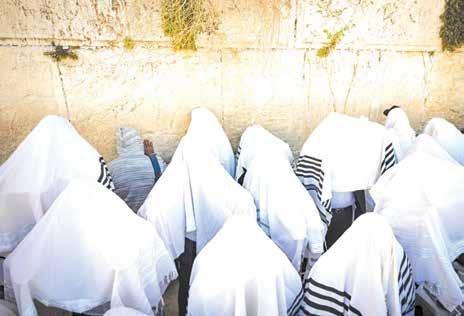
behavior, were also recorded. Many of the laws and duties regarding the priests remained valid and in force even after the destruction of the Second Temple. The Talmud ordained that the priests were to continue to receive special honors and recognition from the Jewish people. The priestly blessings became the focal point of the prayer services, and the honors due the priest were constantly strengthened in the long night of our exile. The priest
in Jewish life, perhaps even more so than the kings and rulers of the nation. The priestly clan saved the Jewish people from national and moral destruction. Yet, at other times, they were the catalyst for the people’s abandonment of Torah and Jewish tradition.
The Talmud lists for us the names of families from Second Temple times who were to be eternally remembered positively because of their Torah true behavior. And the names of those families of priests who were to be remembered negatively, due to their unseemly practices and
was seen as our living personal connection to our past Temple glories and to our future redemption.
In our current world, there are a number of study groups throughout the Jewish world, especially here in Israel, which concentrate upon the study of the laws and procedures of the priestly duties vis-a-vis the Temple services. It is no wonder that the priests of Israel are proudly zealous in preserving their lineage and the special place that they occupy in Jewish life. Shabbat shalom.
The priest was seen as our living personal connection to our past Temple glories and to our future redemption.


Adapted for publication by Binyomin Wolf
As the Jewish people, Hashem’s bride, walk away from Egypt and toward the acceptance of the Torah under the chuppah of Har Sinai with our chosson, Hashem, we may feel unworthy, shy, and hesitant. But the truth is that in Yiddishkeit, neither a chosson nor a kallah walk to the chuppah alone. They must each be accompanied by the best man and maid of honor, respectively. Who is Hashem’s “best man”? Who is our maid of honor?
According to the Zohar HaKadosh, Moshe Rebbeinu is called shushbina d’Malka , Hashem’s “best man.” On some level, Moshe Rebbeinu escorts the Holy One to His encounter with us. But the Jewish people, who felt so defiled by their immersion in the forty-nine levels of impurity of Egypt, still need to be escorted to the foot of Sinai by someone less
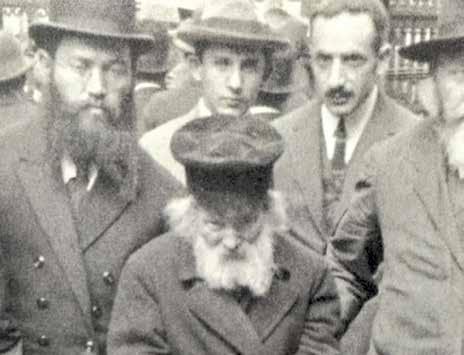
“intimidating” than Moshe, who was on such a lofty level that he subsequently had to cover his face with a veil because of the shining light emanating from his face.
The Zohar therefore says that the one who encouraged and escorted the demure and shy Jewish people to the chuppah was Aharon HaKohein. He was there to encourage the kallah to recognize that she was fit to approach her chosson and receive the kesubah –the Torah, Hashem’s wedding contract with us. That is the deeper meaning of what the Mishna in Avos (1:12) says about Aharon: “lover of peace, pursuer of peace, lover of all people who brings them close to the Torah.” Aharon was the one who escorted us to Sinai to bring us close to the Torah.
That is why one opinion in the Gemara (Yuma 19a) calls the kohanim “agents
of Hashem.” Hashem sends Aharon and his descendants, the kohanim, to bring us close to Him. When a Jew comes to a kohein to bring a sin offering, he pours out his feelings of guilt and the secrets of his heart to the kohein. And that kohein encourages the Jew to recognize that he deserves to be in Hashem’s house, that he is loved and welcome in the chosson’s home.
This is the message of the beginning of our parsha, which says, “Speak to the kohanim, the children of Aharon, and say to them, ‘To a life among his nation, he shall not defile himself’” (Vayikra 21:1). The Tosher Rebbe, zy”a, teaches regarding this pasuk that the kohanim were responsible to ensure that no one among the nation become defiled. He teaches that the word for defiled, yitmah, is related to a homonym, yitmah , which means “mix,” as this word is used
by the Gemara, “so that he should not become mixed, yitmah, among the nations” (Kiddushin 20b). The kohanim escort every Jew back to the chosson and back to holiness.
Today, the tzaddikim and leaders of the generation take on the role of the kohanim in our lives (Megillah 22a). They are sent by Hashem to us to escort us back to Hashem, to take on the responsibility to ensure that no Jew is written off from holiness. No matter how far a Jew has strayed, our tzaddikim and mashpi’im may not give up on anyone. They must work with all the effort they can muster to ensure that no Jew is left behind (see II Shmuel 14;14).
On a simple level, the pasuk in our parshah teaches that a kohein may not come into contact with any dead body. If a Jewish person’s body requires burial,
others must attend to the task. But as for the kohein, “to a life among his nation, he shall not defile himself.” Rashi is bothered by a question on this pasuk. Why must it specify “among his nation”? He explains that this phrase indicates that the prohibition against contact with the dead only applies if the body is “among his nation,” i.e., being attended to by other members of the nation. If, however, a body is left alone with no one to ensure a proper burial, then the prohibition against contact with the dead does not apply. What do we learn from this today?
The tzaddikim and leaders’ responsibility to ensure that every Jew knows he or she is wanted and needed as part of the totality of the Jewish people exists primarily where no one else is there to ensure that someone is not left behind. If someone has family, teachers, rebbeim, friends, or teachers who are actively working with this person – if he or she is still “among his nation” – then the kohein of the generation is less accountable. But when a Jew feels like he is thrown out, abandoned, ownerless, and alone, it is then the obligation of the tzaddikim ensure that he or she is escorted back to Hashem, who is sitting on pins and needles, so to speak, waiting
for His messengers to bring His kallah back to Him.

One of the most famous kohanim was the tzaddik, Rav Shlomo HaKohein from Radomsk, the Tiferes Shlomo, zy”a. He once arrived, with great fanfare, to the city of Cracow. While visitors to a city normally go to the rav of a city, the rav of Cracow, Rav Shimon Sofer, zt”l, the son of the Chasam Sofer, zt”l, came to greet the Tiferes Shlomo upon his arrival. Rav Shimon approached the Radomsker deferentially, at which point Rav Shlomo’la asked, “Why are you the rav of Cracow?” Rav Shimon stood silently, waiting to hear what the Tiferes Shlomo would say. The tzaddik then explained:
What is the purpose of a tzaddik in a city? The answer is in the Gemara (Kiddushin 40a). It asks a question about the pasuk which says, “Say of the tzaddik that he is good” (Yeshayahu 3:10). The Gemara asks, “And is there a tzaddik who is not good?!” Can a “tzaddik” be a thief? What is the pasuk adding? By virtue of the fact that a person is called a tzaddik, by definition, he is good. The Gemara answers that the pasuk comes to exclude a tzaddik who is good toward Heaven but bad toward other people.
But this explanation is also lacking. The person described by the pasuk is, after all, a tzaddik. If this person behaves badly toward other people, he could not, in the first instance, be described as a tzaddik. When the pasuk describes the possibility of a “tzaddik who is not good,” it must mean a tzaddik who lives only for his own service of Hashem, but does not, through his study of Torah and service, work to improve other Jews’ health, spiritual connection, livelihood, and general wellbeing.

Such “not good” tzaddikim are those who, like Nadav and Avihu, “died through approaching before G-d” (Vayikra 16:1). They worked to approach G-d by themselves, without attempting to bring other Jews with them. These “leaders” are described as “dying” through their self-absorbed effort to approach G-d because they are not deserving of their positions within the Jewish people.
Do you know why you were made rav of Cracow? Was it to rule on the kashrus of dairy spoons accidentally used to stir a pot of meat? There are ten rabbis on every block in Cracow who can rule on such matters. You
were chosen by Providence as rav of the city to bring down livelihood, health, blessings, children, encouragement, and strength to every Jew in the city. You were chosen to be a tzaddik about whom people can say “He is good” – not only toward Heaven, but to the Jewish people.
All of us in the small minority of Jews who still have a connection to Hashem and the Torah despite two thousand years of exile and concealment can also have some part in being the kohanim of today, Hashem’s messengers sent to bring our brothers and sisters who feel lost, alone, abandoned, defiled, and full of guilt back under the chuppah – back under the shelter of the Holy One, our chosson who never stops waiting for us. May Hashem cause everyone who feels pushed aside and abandoned back under the wings of the Divine Presence with the arrival of Moshiach and the revelation of the complete redemption, may it be soon in our days.
Imagine a teenager lying on a grassy field, gazing into the night sky. As he stares up at the stars, he thinks to himself, “Look at how enormous the universe is. The sky just expands endlessly... It must go on forever.” After sitting with that thought for a few moments, he becomes uncomfortable. “How can anything go on forever? Everything must stop eventually.” But after a few moments of relaxation, his thoughts intrude again. “But how can the universe stop? What exists on the other side when the universe ends? It must go on forever...” And this inner dialogue continues as he struggles to contemplate the infinite within his finite mind.
This struggle is not a childish one; it is a challenge that confronts any finite being who tries to connect to the infinite.
Younger children, however, do not face this struggle. They are dreamers, living in a world of fantasy where anything is possible. Just ask a group of children what
 By Rabbi Shmuel Reichman
By Rabbi Shmuel Reichman
they want to be when they grow up, and you’ll get some of the most fantastic, unrealistic responses imaginable. “I’m going to be an astronaut fireman, so that I can save people on the moon,” or “I’m going to become a great tzaddik and learn how to speak every language so that I can teach Torah to everyone.” Children live within the infinite, the realm of endless possibility. However, as we grow up, we begin to experience the struggle of reality, where our notions of the infinite start being challenged. We then face the question: How do we, as physical and limited beings, transcend our finite dimensions? How do we relate to the abstract, to the infinite, to the spiritual?
Let us approach this question through the lens of sefiras ha’omer, the counting of the omer.
between Pesach and Shavuos, a period known as sefiras ha’omer (Vayikra 23:15–16; Devarim 16:9). At first glance, this can be understood on a very simple level: As we approach Shavuos, we excitedly count down to Matan Torah as we anticipate our acceptance of the Torah. This can be compared to a countdown toward a wedding, a vacation, or some other exciting event. However, there is a feature of the sefiras ha’omer count that is markedly different: Rather than counting down toward the destination, Shavuos, we count up from the starting point, Pesach. We don’t mark how many days remain until Shavuos; we count how many days have elapsed since Pesach. What is the meaning behind this strange method of counting? And more generally, what is the purpose of counting in the first place? By no other holidays do we count the days between them; we don’t count the days between
Sukkos and Chanukah. Why then do we specifically count the days between Pesach and Shavuos?
In truth, we are not counting down to Matan Torah, but rather are building toward it, ascending one day at a time. We do not wait for Shavuos to arrive; we actively bring it ourselves through the time and effort we invest as we count the omer. If Shavuos — and its accompanying Matan Torah — are a skyscraper, each day of the omer is a brick. Each day we place the next brick in our building, and each day we build ourselves one step higher. The extensive halachic emphasis on counting each and every day of the omer highlights the fact that every single brick is essential and that every single day is fundamental (Tosafos, Menachos 66a). If, while building a staircase, you miss one step, you simply cannot build the next step up. Each step requires a foundation to rest on.

The same is true of counting the omer
Each day builds upon the previous ones, ascending toward our ultimate destination. Matan Torah does not come after forty-nine days – it comes because of them, built by our effort and investment during sefiras ha’omer. This is why we count up. We are not counting down to Matan Torah; we are building up toward it, one day at a time.
This elucidation of sefiras ha’omer sheds light on the Ramban’s enigmatic approach to the counting of the omer. He maintains that women are obligated to count the omer because it is not a mitzvas aseih she’ha’zman grama — a time-bound commandment. How are we to understand this? Sefiras ha’omer, the counting of each specific day between Pesach and Shavuos, seems to be the epitome of a time-bound mitzvah!
However, a deeper understanding of sefiras ha’omer clarifies the Ramban’s opinion. In general, a time-bound mitzvah is an opportunity to tap into a certain power of time that exists at that moment. On Pesach, when we eat matzah, we tap into the power of freedom, a pre-existing reality. This same principle applies to all time-bound mitzvos. For sefiras ha’omer, however, we don’t tap
into a pre-existing time; we create time. When we count the omer, we do not tap into the reality of the omer, we create it. Time does not create the omer ; we do. This is why there is no specific date mentioned for Shavuos in the Torah. Shavuos — and Matan Torah — are not tied to a specific day (the sixth of Sivan); it is the result of the forty-nine days that we
Just like the teenager in the introductory story, we all struggle to connect with the infinite; to see the spiritual within the physical; to find genuine meaning and purpose in an often turbulent and chaotic world. It can feel overwhelming — if not impossible — to build a skyscraper; the task is quite daunting.
thing magical as we build toward Matan Torah, one day at a time.
Rabbi Shmuel Reichman is the author of the bestselling book, “The Journey to Your Ultimate Self,” which serves as an inspiring gateway into deeper Jewish thought. He is an educator and speaker who has lectured internationally on topics of Torah thought, Jewish medical ethics, psychology, and leadership. He is also the founder and CEO of Self-Mastery Academy, the transformative online self-development course based on the principles of high-performance psychology and Torah.
count. The fiftieth day, the day of Shavuos and Matan Torah, emerges from the forty-nine days of counting. We bring it into existence. This is why the holiday of Shavuos literally means “weeks” — the seven weeks that we count create the holiday of Shavuos. (Shavuos also shares the same root as the word sheva (seven), reflecting the seven weeks that creates the chag of Shavuos.)
However, the key is to have the ultimate goal in the back of our minds while we focus on each individual day, trying our best to place each individual brick perfectly while we build toward our ultimate destination. Each day of the omer is a new brick — a new part of our journey toward Matan Torah, toward the infinite, and toward marrying Hashem.
May we be inspired to create some -
After obtaining his BA from Yeshiva University, he received Semicha from Yeshiva University’s RIETS, a master’s degree in education from Azrieli Graduate School, and a master’s degree in Jewish Thought from Bernard Revel Graduate School. He then spent a year studying at Harvard as an Ivy Plus Scholar. He currently lives in Chicago with his wife and son where he is pursuing a PhD at the University of Chicago.
To invite Rabbi Reichman to speak in your community or to enjoy more of his deep and inspiring content, visit his website: ShmuelReichman.com.


We actively bring it ourselves through the time and effort we invest as we count the omer.
Every once in a while, one reads an article that is life-changing. There may be a halacha article that raises important points the reader was not aware of. Sometimes, there is a new pressing halachic question that has as of yet not been addressed. Suffice it to say, this is not such an article.

This article will tackle this important issue: may one daven in Klingon? Klingon is an invented language for the Star-Trek universe. As one may guess, Klingon is spoken by Klingons. This language that registers as truly alien has sounds reminiscent of Arabic, Turkish, Yiddish, Japanese and Native American languages. Its defining characteristic is that it has many harsh guttural sounds. Apparently, Klingon has the distinction of being the world’s most popular fictitious language, according to the Guinness Book of World Records. There is even an institute dedicated to the study of Klingon.
In the Harry Potter universe, Parseltongue is the language of snakes and other serpentine creatures. A person who has the ability to speak Parseltongue is called a Parselmouth. May a Parselmouth recite Shemoneh Esreh in his unique language? Alas, a Harry Potter fan stated that this question was ridiculous, as even Parselmouths do not communicate with one another using this language.
Still, another boy said a more relevant question is may one daven in Elvish, a language invented by J. R. R. Tolkien (for Lord of the Rings). Yet another boy responded that the question was missing information. After all, there are multiple dialects of Elvish spoken by different races. This author is unfamiliar with the various dialects and will therefore concentrate on Klingon.
The Mishna says in Sotah that one may pray in any language. The Gemaa (33a) explains that Hashem wants one to daven from his heart and whatever language will facilitate that is acceptable. This is codified in the Shulchan Aruch as practical halacha (although praying in Hebrew is strongly
encouraged if one understands Hebrew). There is an opinion that one may only pray in a foreign language if it is one of the 70 languages referred to throughout Torah literature. Klingon would then necessarily be excluded. (Unless during an archeological dig, ancient evidence of the Klingon language was somehow found.) However, this opinion does not seem to be followed.
a spoken language? Even assuming, for argument’s sake, that Klingon can be taken seriously as a language, are there enough Klingon speakers worldwide to give it the halachic status of a bona fide language? Perhaps, the elusive answer to that question may not be necessary.
May someone who formerly lived in Kenya daven in Swahili in Bnei Brak? The
language in the davener’s locale. However, perhaps a number may be surmised. There are those who question the Chofetz Chaim’s premise. How can it be that for a foreign language to be used in prayer, there must be people locally who utilize that language? The Mishna lists Viduy Maaser together with prayer as things that may be recited in a foreign language. Viduy Maaser was recited during a visit to the Beis HaMikdash. There a person declared that he gave all the required tithes from his produce. How can the Mishna make a blanket statement that Viduy Maaser may be recited in any language at the Beis HaMikdash? Perhaps the locales in Yerushalayim don’t speak his language. According to the Chofetz Chaim, an Israeli farmer who speaks Swahili would not be allowed to recite Viduy Maaser in Swahili, unless he was sure that there were a significant number of Yerushalmis who spoke Swahilli. Some suggest that in Yerushalayim, foreign languages were not an issue. The Sanhedrin was seated there. They had seventy members who were fluent in the seventy languages. Therefore, a foreigner could always be assured there were a significant amount of people in Yerushalayim that spoke his language.
Moreover, the Chasam Sofer specifically rejected it. One may pray in any foreign language, not just the original 70. Klingon may still be relevant!
However, the question is what exactly defines a language. The Ran (Nedarim 2a) says it is a manner of speaking that is used by convention by a group of people. Swahili is a language spoken in a number of countries. Swahili would certainly qualify as a spoken language. How many people must use a language to give it the status of
Chofetz Chaim says that one may only daven in a foreign language if two conditions are met. The first is that the person praying understands that foreign language. The second is that there are more than a few people in the location of the davener who understand the foreign language. Consequently, if there are only five people in Bnei Brak who speak Swahili, the Kenyan may not daven there in Swahili. The Chofetz Chaim does not cite a magic number for how many people have to speak a
Even though seventy is not a large number, it is still highly unlikely that in any given locale one can find that many Klingon speakers. Therefore, practically, one cannot daven in Klingon. Even if one finds seventy Klingon speakers, it is still not comparable to a foreign language since there is no locale that adopted it as their primary language.
GhonglIj yIHmey mop ‘e’ DaSov. (That is supposed to be Klingon for “I hope you enjoyed this article.”)

Israel is suffering the most unstable period I can recall in the 30 years I have lived here. Until now, the major issues have rarely pitted Jew against Jew to the degree the current political crisis has. The battlelines have been drawn, and for all intents and purposes, we are looking into the abyss. The political situation has become so caustic that a vitriolic discourse has spilt into areas in public life where it should be kept at bay – in our synagogues and schools.
Our teachers’ room turned into a battleground of screaming heads the day before the bill to reform the judiciary was read in the Knesset. I am not embarrassed to say that I am against the reforms, but in thirty-eight years in the classroom, I have taught myself not to discuss politics. It was when the conversation turned sour and borderline abusive in the teachers’ room that I walked out. The yelling could be heard in the entrance lobby where students milled around. The reform is important to the country, and students should and do know about the raging debate, but when the adults in the room “go off the handle,” students are learning the wrong message.
The same is true of the synagogue. It is not a place where the pulpit should be used to espouse extremist views. In our synagogue, there is a rotation of speakers on Friday nights. Thus, we are exposed to a panoply of views. Some speakers are anecdotal, others ramble to the point of confusion, some are concise and enlightening, and there are those who view their allotted seven minutes as an opportunity to keep our hot food waiting at home.
Truth be told, it is difficult getting people to volunteer to speak. There are weeks when the most inappropriate speakers address us. Recently, a gentleman rabbi got up to speak. Over the course of ten minutes, he succeeded in insulting the people protesting against

the reforms; he compared them to Korach. He pointed a finger at the protesting reserve pilots, failing to comprehend that one of their own was sitting with his father only a few rows in front of the Aron Kodesh. He threw in a few jokes which fell flat. He did this all with an air of supreme confidence, boasting erudition, and a total disregard for the feelings of anybody but those who held his views.
The following week, a WhatsApp notice was sent to the congregation reminding us that politics and prayer must remain separate. I had to laugh. Reading the message took me back to the early 1980s when I was still living in Australia. At the time, there was a Jewish comedian who went by the name of Austen Tayshus. He was a larrikin (a boisterous young man) whose repertoire consisted of witty one-liners. He was savvy and biting, and had a signature move where he’d throw his right hand over his head to indicate his joke had gone over people’s heads. For example, he would use Australian names to humor his audience. “Pretty soon Ayers Rocks in, and
things really started jumping.” I think you get the idea.
Over the years I’ve thought of Austen Tayshus; like when rabbis have an agenda they believe needs addressing from the pulpit but don’t have the gumption to address individuals. This usually occurs when a congregant has exceeded the mark by acting outside the norms of what we consider good behavior. Some rabbis have the tendency to address the issue from the pulpit by speaking in broad, general terms.
The results are always the same; a few get the message, but most don’t. Most frustrating is that the very person for whom the message was originally intended either isn’t in shul, or if he is, doesn’t much care at all.
Here’s the message that was sent to the congregants of our shul.
Dear Friends,
We would like to remind the public of a decision of the synagogue from several years ago that was included in the synagogue’s statutes: “The synagogue and the committee will not engage in political matters (national or local) of

any kind inside the synagogue.”
This section also applies to those who speak from the pulpit on Friday night. We ask the public to observe these rules.
Best regards, Synagogue Committee. I laughed again. For one, I’m on the committee, although I had nothing to do with the letter. It was a classic case of Austen Tayshus speaking over people’s heads.
Out of curiosity, I decided to test the waters, to see whether my instinct was right. Why not ask the offender if he’d seen the notice? Why not see if he’d acknowledge any wrongdoing? I’ve known him for ten years. He thinks he’s funny. I have never once known him to be contrite. He believes what he says. When held to account, he is accustomed to denying the facts. Instead, he’ll batten down the hatches.
I asked many congregants if they’d seen the message. The feedback mostly bordered on indifference. After all, who takes WhatsApps too seriously?
And so, I approached the gentleman in question and asked if he’d seen the message. He hadn’t. I showed it to him. While reading it, a look of disdain covered his face like a man about to spit at the feet of his enemy. He went into total defense mode, which morphed into attacking his detractors.
He told me he’d said nothing of the sort. He chased me down later and quoted what he thought he’d said. Ah…what’s the point, I thought to myself. What was gained by the message? Absolutely nothing. As I parted from the Friday night’s speaker, I threw my right hand over my forehead.
Austen Tayshus would have been proud.

As Israel hits the milestone of its 75th birthday, it is too easy to become demoralized.
The disputes over the government’s plans for legal reforms have become unprecedentedly intense. Strong differences of opinion have led to incidents of violence and prophecies of doom.
Israeli President Isaac Herzog has even warned that the Jewish state is on the brink of civil war and noted that previous Jewish commonwealths did not pass eight decades. A recent event at the President’s Residence highlighted that there have been 12 civil wars in Jewish history—a stark reminder of the impact of past infighting inside the Jewish community.
But for us proud religious Zionists, seeing such internal disputes inside the Jewish state need not be a cause of despair. Witnessing these troubled times should actually give us even more hope for the future of the State of Israel as a Jewish and democratic state. It should strengthen our emunah, our faith, rather than weaken it.
We believe that Israel is atchalta de’geula —just the beginning of the redemption that Jews around the world prayed for three times a day since the exile in 70 C.E., not the end. Israel is a work in
progress, not a finished product. Its name means “struggling with G-d,” and that struggle continues.Bottom of Form
Israelis are fighting over how to be a Jewish state and a democratic one. Those concepts that usually worked beautifully together over the past seven-and-a-half decades are currently being re-evaluated, and the finished product when the struggle is over will end up being stronger and even more cohesive.
Zionist visionary Theodor Herzl envisioned the Jews becoming a normal nation with a state of its own. This vision of normalcy as an ideal was included in Israel’s Declaration of Independence.
“This is the natural right of the Jewish people to be masters of their own fate, like all other nations, in their own sovereign state,” says the document signed by representatives of all sectors of the nascent Jewish state.
Like all other states, Israel faces its share of respectful disagreement. This is part and parcel of being the normal country that Herzl envisioned.
This ability that the people of Israel have to argue among themselves is itself a democratic principle that needs to be celebrated, not feared.
The many disputes that surfaced since
Israel was founded—over its borders, its religious status quo, and accepting reparations from Germany for the Holocaust— make it all the more impressive that the Jewish state has lasted so long.
Even declaring a State of Israel involved many internal fights, as has the question about how to mark the day since then. Whether or not we make a blessing in our Hallel prayer, we religious Zionists thank G-d for the modern miracle of Israel, shortcomings and all. In that prayer, we praise G-d for His perfection, but we recall that while He is exalted high in the heavens, He gave the earth to the imperfect children of men.
We are left to deal with those imperfections with our own free will.
George Orwell wrote that “freedom is the right to tell people what they do not want to hear.” Both sides in Israel can express that right that truly makes us free.
In that regard, Yom Ha’Atzmaut is a celebration of freedom. In 1881, nearly seven decades before Yom Ha’Atzmaut, the Sfas Emes predicted that there would one day be a new freedom festival parallel to Passover, just like Chanukah was a late celebration of Sukkot, and that Purim followed up on the acceptance of the Torah on Shavuot.
Following the miracles of Chanukah and Purim, the internal divides continued. The Hasmoneans illegitimately held on to power. Mordechai only had the support of a majority of his people. After Yom Ha’Atzmaut, the disputes continue as well. But they continue with an important reminder: the menorah that is the official emblem of the State of Israel.
When the menorah was first crafted for the Mishkan, it had to be built out of one piece of solid gold. Since then, it has been a reminder of the need for Jewish unity. The menorah stands opposite the Knesset as a reminder to the politicians that no matter how much they fight, we must remain one people.

It is my hope that after the current disputes are resolved, we will see the return of the unity that is so desperately needed for Israel’s next 75 years.
Martin Oliner is co-president of the Religious Zionists of America, chairman of the Center for Righteousness and Integrity, and a committee member of the Jewish Agency. He was appointed by former President Donald Trump as a member of the United States Holocaust Memorial Council. The former mayor of the Village of Lawrence, Oliner lives in the Five Towns.

What makes Israel the hub of innovation that it is? Why does such a small country have the highest percentage of start-ups per capita? While there may be many contributing factors, Inbal Arieli believes it has largely to do with the typical Israeli upbringing, and asserts that what transpires in the schoolyard ultimately translates to the boardroom.
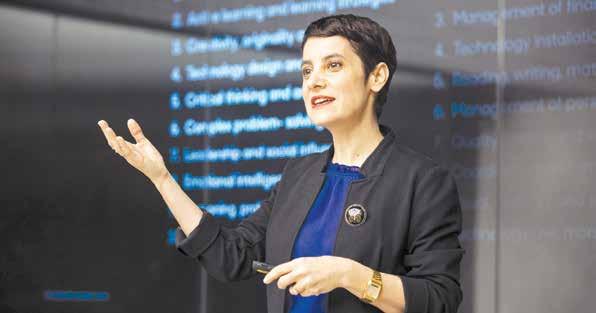
Arieli is an Israeli entrepreneur, investor, speaker and tech influencer. A former officer in the Elite Unit 8200 of the Israeli Defense Forces, Arieli holds an LL.B. Law and an M.B.A. from Tel Aviv University. She is Founder and Co-CEO of global leadership assessment firm Synthesis, while serving on the boards of various ventures. She is also the author of Chutzpah: Why Israel is a Hub of Innovation and Entrepreneurship.
The well-known Hebrew and Yiddish word, “chutzpah” is commonly defined as “extreme self-confidence or audacity” – with both negative and positive connotations. Arieli focuses on the positive
power of chutzpah to present a fresh and fascinating perspective on both entrepreneurship and parenting. She lays out how an Israeli upbringing with its particular challenges can foster resilience, responsibility and leadership, and how an environment where assertiveness and creativity are valued can provide a framework of skills for success in business, the military and life.
Arieli resides in Tel Aviv with her husband and three sons. She spent summer of 2022 in the States with their youngest son as he participated in an elite dance program in New York City, where she observed differences in parenting styles. She believes that we all have the innate potential to thrive, no matter where we are born or raised; Arieli likens the skillset to muscles in the body waiting to be trained and developed.
Arieli spoke with TJH about the unique skills that Israelis possess, how they are nurtured in Israeli society, and how to raise resilient, successful children.
Modern American families, and particularly Jewish American families, typically have a lot of structure built into their daily lives and follow a pretty standard path of rules, education and expectations throughout. It seems as if Israeli children have less structure yet go on to succeed in a military organization with a mandatory draft. What can you tell us about these differences in upbringing?
When you think of a military organization anywhere in the world, you’d get the same answers, which are what you have in mind: uniforms, hierarchy, orders, commands, formality and discipline – all the same things we all think of when it comes to a military organization. The Israeli military in essence, versus what it looks like, actually does not operate in this way. So the first thing we need to do is we need to open our minds to think a little differently about what it really means to serve in the Israeli military.
We all put a lot of faith in the Israeli army!
Absolutely, the Israeli army is great! This is something we need to keep in mind because it influences all the assumptions we’re making for the rest of the conversation. So let’s start by taking two steps backwards.
A typical Israeli childhood would be one which is much more “free” than a typical childhood in the U.S. of 2022 and definitely in New York from what I’ve seen this past summer. In Israel, our son Yarden dances every day and he commutes to school by himself within Tel Aviv; he takes the bus every day – from school to the studio by himself and back home at 8 or 9 PM by himself. He’s just turned 13 and he’s been doing that since age 10. Going back and forth to school is something you do even earlier because most primary schools are neighborhood schools, so kids just walk to school. Maybe in first grade you’ll see parents taking them, but then after that, they just walk 2-3 minutes with their friends to school.
In most secular neighborhoods in Israel, the ones who are monitoring the roads at 7:45 AM and when school is finished at 1:00 pm and making sure that the kids are safe are the sixth grade kids. There’s a rotation and they get designated roles within that – one kid is taking notes of the cars that aren’t stopping, and two kids are on both sides of the crosswalk. That’s a great example of how society sees their involvement in community life. It’s not just giving them the responsibility to manage the traffic in front of the schools, it also actually teaches them a lot about how to be safe when they walk and they cross the roads, and it’s much more.

They really want to do it – it’s fun, it’s a symbol of them being the “grownups” in school. They wait for that and they train in fifth grade; at 10 to 11 they train and learn the traffic rules so that in sixth grade they can do it. They get yellow jackets, they get the stop signs, and for 15 minutes before school and 15 minutes after school, they’re the ones literally monitoring the
traffic of cars – and everyone’s actually listening to them.
So in essence this freedom is what teaches responsibility?
Yes, to take care of themselves and others. The role is very responsible; you are responsible for the younger kids at school and it’s real – there’s no one out there, they do that by themselves. It’s not just the responsibility; it’s teaching them a lot about independence, self-confidence and building their confidence in themselves. It’s putting a lot of trust in their
Throughout Israeli childhood, there are all these elements, so when they turn 18, the military is a natural next chapter. These are not kids who have chosen the military as their career. They’re there because they have to be there – you have to create motivation or incentivize them in a very deep way. It’s not about money, it’s not about their wish, so you have to create the motivation and engagement in different ways. The way of creating motivation and engagement with 18-year-old kids is definitely not by putting them into discipline-structured frameworks – it just won’t work, it won’t last. You want them really engaged, you want them to think, you want them to question and you want them to be able to make decisions.
When there’s an operation and there’s an Iron Dome base which is operated by 18-, 19-, 20-year-old kids, they’re the ones responsible to make sure that everything is happening the right way. It’s not because of strict discipline that they are so well trained. It’s because they understand they’re doing something extremely important. They understand they are literally protecting their families and friends, and they understand that they are part of something super meaningful – they have the power to successfully stop rockets from falling on the rooftops of their homes or not. That is something that definitely excites 18-, 19-, 20-year-old kids.

Similar model to the responsibility of the crossing guard.
hands, which makes them even more responsible and accountable. This is a minor example, and Israelis would not be aware of the nuance because this is so normal for us – we’re used to seeing these kids at 1:30, we’re used to following the signage of 12-year-old kids and adhering to it.
You really have to drive that point home – commonly, parents here are still accompanying our sixth-graders wherever they go and maybe letting them walk the main street in town.
It doesn’t look strange to me, but it is, in your eyes, fascinating. This is how you grow up in Israel and there are many examples like that – it speaks to their freedom, independence, self-reliance, accountability, capabilities and discretion, but it also speaks to their involvement in the community. They don’t choose to only take care of themselves or of their younger siblings or friends – it’s broader, it’s their entire neighborhood, it’s all the kids at school. So, in a sense, this anecdote is very Israeli.
Yes – it’s not presumed responsibility, it’s the responsibility to actually act. Again, it’s a nuance, but it’s very important you don’t just tell him, “Oh, yes, you’re responsible for that as a group” or whatever –it’s literally that they are responsible and what they do or don’t do will have results and impact on the lives of many others. So the military in a sense is actually much more creative, much less hierarchal, and much more based on improvisation and decision making by each and every soldier than what you would think.
Kids at the ages of 18, 19 and early 20s are by definition more creative than people in their 30s, 40s, 50s and 60s. By definition, they are risk-takers, they are more disruptive in the way they think, so that’s one thing. But the setting, which is actual operations within the military, enables them to bring that creativity. This is where it becomes really interesting. The setting again, whatever the role in the military is, is designed in a way that encourages them to speak up, to say what they think – not necessarily because in all cases they have the right answers – but because you want to train them to be extremely engaged in what they do. Not to do because they’re told to do so, but to do because they understand what they’re doing, and
“There’s no one way of succeeding, and there’s no one metric for success.”
there’s a huge difference there. In so many ways the experience of serving in the Israeli military is a natural evolvement of growing up in Israel. All these skills, all these creative energies still have a way to be used and showcased even within the military. As we said at the beginning of our talk – they’re not opposites at all.
They are training for it all along the way.
I actually think that one of the secret sauces of the professionalism of the Israeli military is really understanding that and realizing that these kids are not professional soldiers. The 20-year-old officer who just graduated from officer school is now managing a group of 35 soldiers, who are only a year younger than he or she is. They don’t listen to this super young officer because he has a nice rank on his shoulder, it’s more than that, that’s not enough. It has to do with their personality, with their thinking, what type of leaders they are. It’s very counterintuitive to what you have in mind when you think of a military organization.
Chutzpah is categorized as a business book – how does this philosophy apply to the business realm?
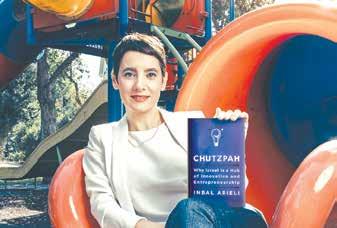
My thesis is that in today’s world and today’s climate, mostly from an economical perspective and obviously technological also – because technology is becoming such a critical element – there are some skills that are critical. Most of those skills are actually “soft skills,” not hard skills, based less on pure knowledge and expertise and based much more on softer elements, on our personalities and our skill sets.
For example, complex problem-solving, or the ability to be cross-disciplinary – to bring ideas from one world to the other and influence versus being a deep expert in one specific topic, or for example, the transition or the switch gradually from management to leadership. Am I saying that management skills are not important? No, we’re not saying that at all. I’m saying that the more progress we make, we see more and more tools that can help us in management, whereas in leadership the human factor is still more critical.
Forty years ago, we didn’t have all the management tools that we have today. A shared calendar, for example, is a great management tool. Slack is a great example, and Monday.com, an Israeli company… there are many. Management and leadership are not the same thing, but great managers are also good leaders. The leadership part is something that we as human beings still have an advantage, and will probably have enough runway in our times to still be in need of the skills, which will not be replaced that rapidly by artificial intelligence or robotics or machine learning.
Can you expound on the category of soft skills?
My thesis is the importance of the soft skills, and as you can read in the book, the World Economic Fo -
rum has a list of skills that are in demand now and most of them are soft skills — like questioning, for example, going back to assumptions and reassessing them instead of just relying on past experience. Skills like taking on initiative, being extremely proactive and not just following and being reactive to circumstances, emotional intelligence – not just for leaders but generally for working in teams. It’s a long list of softer skills.
When you look at Israeli childhood and Israeli society, many of the soft skills are actually somehow well developed here, each for a different reason, but somehow a mass of these skills are developed, practiced
hood, so change only feels so natural.”
Can you speak a little about resilience?
Resilience is definitely a result of dealing with uncertainty. The way I like to think of it is just like in nature. The strongest element in the plant world are those which are flexible and can actually move, and that makes them very strong and they don’t break. The more you face uncertainty and have no other choice but to adapt, you strengthen those muscles of resilience and you become more resilient, assuming that you are part of something that is evolving.
My parents came to Israel in early 1950s from two corners of the world. They had a lot of uncertainty around them – one war after the other, a completely different economic situation than the past two decades here. There was a bigger notion that as a community, as something larger than two individuals, we must make some progress. The outcome of uncertainty together with the drive to evolve, in my view, is resilience.
Do you think resilience can be developed without framework of uncertainty?
Regarding nature versus nurture argument. Let’s take a baby born wherever in the world; the way we human beings behave, wherever we’re born, we’re very resilient at the beginning. Think of the way we’re learning to walk; I’ve never heard of a baby that stood the first time and started walking. It’s a process where we actually demonstrate a lot of resilience because we fall a million times before we walk. No one ever thinks of stopping a toddler from trying or from falling or expects them to walk without falling.
from a very young age and not because of a strategy, it’s not an educational or parenting strategy. In most cases, it’s a cultural or just out-of-necessity behavior.
From living in Israel from a very young age in the past 70 years, no matter when you were born, you found yourself dealing with a lot of uncertainty – political uncertainty, change of circumstances. The only thing has been stable in the past 20 years is economic growth which is stable and positive, but other than that, everything is constantly changing here. I hear from people who visited Israel five years ago, and they say now it looks like almost a different country.
One entrepreneur told me that she thinks what influenced her most in not being afraid of becoming an entrepreneur was the fact that she grew up in Rishon LeTsiyon just outside of Tel Aviv, the fourth largest city in Israel. She said, “Growing up there, I remember in the window of my bedroom I kept seeing all these buildings being built one after the other… The entire landscape completely changed throughout my child-
We know that if you let them rely too much on those walkers, it doesn’t strengthen the legs; it does the opposite, because they need their bones and muscles to actually strengthen with the weight of their bodies. That’s true for any toddler around the world. Now, I think that what’s happening in many societies, in many cultures, in many environments is we gradually interfere with that very natural human behavior and we start limiting. In Israel, we limit less than other places, and there are other places in the world where kids and adults are also less limited in many ways. The combination of fewer limits together with that drive, that curiosity, that interest and motivation in evolving…this can be trained. My thesis is that all of these soft skills are present in people from all over the world, because when you go back to their early childhood, it was there. Kids ask a lot of questions anywhere around the world – that’s how their minds learn and organize information. Toddlers are very proactive. They don’t just sit and wait for things to happen. They will move, they will try to do things, they play together. It’s a very basic human behavior to look for other toddlers around and to connect with them, so I think of these soft skills as present in any person. I think that for many people, though, they’ve been silenced, or they’ve been neglected and
“We can give a gift to our kids – that ability to admit to themselves that they don’t know everything, and it’s fine as long as they try to keep learning to keep evolving and developing.”
other muscles have been trained or strengthened, and now it’s just a matter of awareness and practice. So you can definitely influence that.
When you think of the American trajectory of school, extra-curricular activities and everything that leads to the elite MBAs, in contrast to the journey of the Israeli entrepreneurs, they seem so divergent, yet it seems success can be achieved in both ways.

Success can be measured in different ways, and you could also ask yourself: success in what? The fact we can see so many Israeli entrepreneurs is often because of that creative mindset; the fact that you see so many great American executives that are capable of leading incredible companies to scale is because many of them have been trained in the structured scalable rate frameworks – and the world needs those and those. The fact that you’ve been trained in one trajectory doesn’t mean that you could not bring something to the other and vice versa. There’s no one way of succeeding, and there’s no one metric for success.
Can you share a little about your upbringing and your current family structure and how those influence your outlook?
I’m the youngest of three siblings. My parents immigrated to Israel from two corners of the world, started a family in Israel, and then we traveled a lot in my childhood. I think that very much influenced the ability to have that perspective of seeing things as an Israeli, but I also had experience of living abroad and seeing things and experiencing and seeing things in a different way. I think that really informed my perspective – and definitely the interest and the passion for people, for focusing on the human factor.
I’m also the mother of three Israeli boys, but I’m the last person on earth to give parenting advice as a mother. I think each kid is completely different; we are different as parents to each one of the kids. I don’t think I have the recipe; I’m trying my best. If I had to say one thing, though, it would be that actually there is no formula; there’s no one size fits all.

There’s no one exact formula or way of being a parent or being an entrepreneur or being an investor; this is also connected to the entire thesis of the book. It’s a combination of elements, there’s no recipe. Part of what we need to train ourselves to do is to feel comfortable when we don’t have the answers and there’s no recipe we can follow – what do we do now?
In terms of business, there are definitely some parallels into my career, which started on one trajectory. I served in the 8200 and as an officer in the military, then went to economic school and spent more than a decade as a general counsel at tech companies in Israel. Then I chose to make a turn and not “reinvent” but actually bring those experiences and skills into a
different environment. I kept doing that several times – as an entrepreneur myself, as an executive investor in tech, and now, as an author. It’s all somehow connected to realizing that once you have these core elements and skills you can actually bring them to each and every environment, circumstance, transaction. It’s not always the same, it’s not one formula.
Is there one lesson in particular to share from your accomplishments?
One of the lessons that I’ve learned throughout the way is that things don’t always go as you plan. You can be the best planner, you can make all the assumptions and cover all the options, but then there’s reality. I’ve learned that the quicker you reas -
The balance that I have today is different than the balance that I had three years ago and very different than the balance that I had when I was a young mom.
I think part of flexibility is not trying to define a balance that will be the right balance; it depends on so many circumstances, so many things. When I mentor younger women who are asking me this question, I always tell them to try to surround yourself with as much help as you can, some paid and some not. In Israel, you have your grandparents, your family, your friends, and it’s a very supportive community in general. So try to get as much help as you can – don’t try to do everything by yourself.
And also be kind to yourself. We’re not really Wonder Woman. We cannot do everything right always. The balances change depending on your kids and their needs at that time, depending on other circumstances and not just kids – your parents, your spouse, your health, and so many things.
That’s life. This is what life is about.
In modern-day America, most people try hard to micro-manage and control their environments. If they have a vision and things doesn’t go as planned, adapting can seem traumatic. It seems when you’re used to change, it becomes a skill.
sess
and adapt to the reality – for that you have to listen and be very attentive and open to things that are happening around you and not fall in with your assumptions – but once you’re attentive and you see that things are not happening the way you forecasted them or projected them, to rapidly as possible adapt and then take it to the next step. It’s easier said than done. It’s not something easy to do because you’re always caught in the moment. But whenever you succeed in doing that, the cost of making a mistake is much smaller. We all make mistakes, so that’s my main lesson learned: to listen, to be very attentive to what’s happening that’s different than what you expected, and to adapt accordingly.
Can you touch on the topic of work/family balance?
I’ll continue the thread that I started: it changes.
Yes, and it’s only perceived control. You just try to hold to what gives you a sense of control. You’ve touched on the most important point — which is that we don’t have control over everything. The past three years were the best example for all of us. It’s an important lesson that we don’t have a control of everything and we don’t have the answers to everything. So if we can give a gift to our kids is that ability to admit to themselves that they don’t know everything, and it’s fine as long as they try to keep learning to keep evolving and developing. There’s actually never a situation where we have the answers to everything, but if you’re capable of being humble with this notion, it frees you from the control – because you cannot control everything.
I learned about a beautiful Japanese philosophy. We all have bookshelves, and it tells a lot about us. During Covid, we saw these people doing Zooms with their beautiful libraries behind them. In Japan, there is this philosophy where you always keep one shelf with books you did not read yet and it has to be full. The idea is to remind ourselves that there is always more to learn. I think it’s beautiful. If you take a book and read it, then you immediately put another book that you haven’t read there. It’s a very humbling philosophy of saying that there are always questions I don’t have the answers to.
“The outcome of uncertainty together with the drive to evolve, in my view, is resilience.”
Baruch Hashem, a bunch of my friends and I are newly married. Interestingly, we all keep running into a similar problem: the infamous mother-in-law crisis. And I know, everyone says it takes time and eventually I’ll like her and sometimes even throwing grandkids into the mix takes away from the tension. However, that’s not the focus of my question.
I’m trying to understand why the mother-in-law/daughter-in-law dynamic needs so much attention. My parents don’t constantly call my husband and try super hard to be his friend and win him over. Why is my mother-in-law
ALWAYS trying so hard? Yes, she means well and is trying to be welcoming but can’t we just allow for a natural process to help cultivate the relationship?


Ithink that the answer to your question is fairly clear. Because the mother-in-law/ daughter-in-law relationship is fraught with negativity in literature and is the subject of many comic routines and jokes, many mothers-in-law are trying very hard to develop a good relationship with their daughters-in-law. Daughters-in-law are particularly vulnerable in Jewish families which are close and get together regularly for Shabbosim and yomim tovim. There isn’t much time for the relationship to grow naturally.
Good intentions don’t always come across as such, especially when the younger woman is the newcomer in the family as well as new to the marriage. It’s not an easy position to be in. There is an established family culture, a mothering figure, and a new permanent relationship with her husband to navigate. However, it is up to the mother-in-law, the older, more experienced woman, to give her newlywed daughter-in-law considerable space so that there is organic growth to the relationship.
As a matter-of-fact, our JWOW! website offers a helpful article by my colleague Miriam Hendeles MS, author of Mazel Tov It’s a Bubby, called the Ten Things You’re Doing that Drive Your New Daughter-inLaw Crazy... and How to Fix Them. You have to sign up for the free subscription at www.jewishwomenofwisdom.org, and it will be sent to you automatically. Jewish women of wisdom, the responsibility is on you to try to put your daughter-in-law at ease.
Before I answer your question, I would like to put some things into perspective. I’m sure there are hundreds of singles reading this question pining, davening, with all of their heart and soul to have mother-in-law problems. I do not say this to belittle your problem. I say this as a
reminder to all of us: every phase in life comes with aggravations and difficulties. The things that we daven so hard for are often the things that inevitably cause the most stress. I have heard this many times when it comes to childrearing as well. A childless couple davens and cries out to Hakadosh Baruch Hu to have children. Once children are born, it is so easy to forget in the hullabaloo of life how lucky we are for the chaos. Before even getting to the meat and potatoes of your question, I would like to close your eyes and remember the points in time where you sat in shul davening your kishkes out to find a husband, those long nights and long days where you sat and wondered if your bashert would ever come. With a bit of a positive attitude and sense of gratitude, you can move forward into forging a healthy relationship with your mother-in-law.
One of the most important things you can do is learn about the different personality types. Recognize, while you have a more natural, hands-off approach, her hands-on approach is engrained within her personality. It is not coming from a malicious place (I know you know this, but I had to say it). It will be very hard for her to change the way she has been her entire life, just as it would be hard for you to do the same.
In the short term, the most effective solution will be for you to lovingly communicate openly with her about your needs. Make it about your preferences rather than you disliking her style. Tell her that within your busy schedule it is hard to answer the phone every day but assure her that she will always hear from you on Friday afternoons. Create a time that is possible for you to catch up with her and stick to that. Boundaries, akin to fences, keep everybody the most secure. Pop into her life using her love language here and there with bursts of kindness that show her you appreciate her. Everything will be amazing – just keep working at it!
can’t fully relate to your struggle. However, I can relate to the obligatory expectation of feeling “super close, super quick” when new members are introduced to family. (This can happen through acquiring stepsiblings, sisters- or brothers-inlaws, etc.) When someone becomes “family,” there’s an expectation of loyalty, that I am responsible for enhancing and caring for this family member. That process may often feel unnatural to one (or both) parties depending on the personality and attachment style of the receiver or giver. You’re absolutely right that it doesn’t feel like the evolution of a natural relationship – because it isn’t. You didn’t choose to be friends with your mother-in-law (or fill in the blank) but are now obligated to feel this kinship through your families blending. On the contrary, the relationship may require even MORE energy than any other relationship especially because it isn’t natural, yet includes all these unspoken bonds of family loyalty, etc.
I think the best advice is to appreciate the affection or connection that is being made towards you while staying authentic to your natural attachment style and moving forward at a pace that works for you.
Let’s explore a few ideas.
First, why do mothers-in-law have
Tzipora GrodkoBoundaries, akin to fences, keep everybody the most secure.
such a bad reputation?
My opinion is that it’s an unfair cultural myth, similar to politically incorrect jokes that unfairly feature negative stereotypes about certain ethnic groups, including our own.
But second, in spite of my own opinion, mother-in-law prejudice does seem to be widespread. Note that a Chabad website (TheJewishWoman.org) reports that, “ Mother-in-law jokes are a mainstay of comedy. Most of these jokes play on the stereotype that the average mother-in-law is overbearing, obnoxious… and most significantly…considers her
daughter-in-law to be totally unworthy of her son.”
These mother-in-law jokes are not new. A first century Roman poet, Juvenal, wrote, “One cannot be truly happy while one’s mother-in-law is still alive.”
Additionally, even in our own Talmud, there seems to be an assumption that, in some cases, there might be an inherent antipathy between a mother-in-law and daughter-in-law. For example, in certain proceedings (Yavamos: 117 and Sotah: 31), a mother-in-law’s testimony that could potentially harm her daughter-in-law, may not be considered as a reliable or credible
Dear Daughter-in-Law in Distress, Thank you for writing! Mazel tov on your new marriage! Without the pleasure of knowing you and your motherin-law, I don’t feel I can give you any kind of true insight into your mother-in-law’s personality and behavior. There is a lot of talk of the horrible mother-in-law/daughter-in-law relationship, but the truth is that so many enjoy beautiful, mutually satisfying relationships. The “boring, nothing to see here, folks” relationships just don’t get as much attention.
A child getting married is a huge transitional period for a mother (and for fathers, too.) Even when mother and child enjoy a healthy, boundaried relationship, the transition and the feelings that a mother will experience are enormous. And there is simply no way to understand this, until someone is in it herself. As much as a mother hopes and prays that her child finds a wonderful life partner, when the time comes, she often experiences loss.
The health - iest of women can become sad or anxious, and to an extent, this is a normal, healthy part of the life cycle. When a mom is in touch with her emotions and has a healthy self-awareness and sense of boundaries, she will speak about these feelings with a friend or therapist, work through them and not allow her feelings and what she is going through to seep into and invade boundaries with the young couple. Some people have a harder time doing “the work.” The work being the emotional work of honoring boundaries and/or being able to be “natural” or have an “organic” process of relationship building, as you mentioned.
When a parent is “too much,” this can often lead to shalom bayis issues ONLY when the child of that parent doesn’t keep healthy boundaries around the marital relationship (i.e., constantly running over to the parents’ house, hour-long phone calls
source of evidence.
And, of course, modern comedians love to tell mother-in-law jokes.
Third, nevertheless, despite all these negative stereotypes, our Jewish halacha is unequivocal. A person must honor their in-laws (Shulchan Aruch Yoreh Deah 240: 24).
Now, especially in these weeks before Shavuot, remember how the love between a daughter-in-law (Ruth) and her motherin-law (Naomi) resulted in one of the most important events in Jewish history, namely, the origins of the King David lineage.
Fourth, and finally, my reaction to the writer of this letter is:
You’ve got to be kidding. You’re actually complaining that your mother-in-law is “trying too hard” to welcome you into her family? What’s wrong with you?!
You sound like some of those mean high school girls who were very cliquey and wouldn’t give the time of day to any-
one outside of their exclusive little circle. Open your heart and mind and reciprocate your mother-in-law’s overtures of love and inclusiveness. She, whether you like it or not, will be an important part of your life for many decades to come. Your attitude will determine whether she will turn out to be your dependable friend or your worst nightmare.
with parents every day when the spouse comes home from work, and generally putting the needs of the marriage second to the need of the parents).
From my narrow understanding of the sliver of the relationship you’ve described, it seems as though your mother-in-law is either very excited to have you in the family, or perhaps a bit anxious during this new phase in her life learning how to be a mother-in-law to you. It may be something that simply fades with time as she feels more comfortable around you and no longer feels the need to do whatever it is she is doing that feels so unnatural. Or, it may be a part of her unique personality.
If you begin to feel that boundaries are being crossed, and it is simply too much, it is a good idea to speak with your husband about it.
I’m sure you already know this, but I figured it might be a good idea to put out the following message: when entering a family, it’s always a good idea to keep an open mind, treat everyone with kindness,
and hold space for the transition everyone is experiencing. Ultimately, the only way to keep this natural and organic feeling is for you to remain natural and organic with her.
One little idea I have is the following: the next time you are invited out for the seventh fancy dinner in a month, or for a shopping spree, or whatever “bestie” activities you are being invited to, how about inviting her to come over for a cup of coffee at home? If you get the sense that she is feeling insecure around you or trying to please you and make a good impression upon you, if you haven’t already done so, let her know in a way that feels organic to you that you like her.
Hopefully, your mother-in-law will begin to feel more comfortable and natural with you over time. Be your organic, natural, and kind self over the next six months and reassess the situation then.
All the best and mazal tov again!
Sincerely,
JenniferYour attitude will determine whether she will turn out to be your dependable friend or your worst nightmare.

Q:Dear Etti, I don’t get it. My daughter keeps getting punished for her jokes and remarks in class. I checked. They are not mean, overt chutzpah… they are funny! And she is funny! And we are a funny family! We make each other laugh in my home. I am proud of the fact that we are a home full of simcha. What is the school’s issue? I want to tell them to chillax a bit! I think they are overreacting and making a mountain out of a molehill.
What is your take?
-Chilled Parent
A:Dear Chilled Parent, I understand from your letter (and unpublished information) that you are the father, and I value that you are close with your daughter. According to www.verywellfamily.com, an organization of doctors sharing health concepts, “A daughter’s relationship with their father can play a key role in their psychological development. In fact, when fathers are present in their daughters’ lives, girls grow up with a healthy sense of who they are. They are more confident and self-assured and have a clearer understanding of what they want in life.” She is a fortunate girl!
It is so great that your home is full of simcha. Happiness cannot be overemphasized as one approaches life with its twists and turns. People who see the world in a positive way are people who usually succeed most in life. According to research Does Happiness Promote Career Success by Boehm, Lyubomirsky, and Walsh (2018), there is a definite correlation between happiness and positive outcomes. Happiness is associated with job satisfaction, performance, and autonomy. It is a large factor in popularity, income, and other social factors.
And you are proud to see that your daughter has picked up the skill of a well-timed joke.
I am concerned, however, that your daughter, and by extension, you, are not valuing important skills that need to be mastered in school to succeed in life.
As you know, academics are important skills for life. But did you know they are called hard skills? You can measure how well a student learns those hard skills by administering tests and other assessments. Soft skills are just as important, and according to many companies, they are more important. Yet soft skills are harder to measure.
Soft skills include the ability to communicate well, to show interpersonal skills, teamwork, conflict resolution, empathy, listening skills, flexibility and adaptability, stress management, ability to deal with adversity… you get the point.
When your daughter makes a joke in class and disrupts the learning, she is demonstrating that she is not adapting and listening. She is not showing that she understands when and where levity is appreciated. This is a concern. There is a time and place for making others laugh. There is also a time and place for being solemn (not sad) and serious.
School teaches so much more than hard skills. Over the course of schooling, a child learns to adapt to different teaching styles and different peer needs. They learn communication skills as they make their needs known, and learn code switching, how effective communication means speaking with intent and purpose.

It is appropriate, when among friends, to tell a story that is embellished to make an audience laugh. When going to a doctor, however, one should just keep
to the facts. At a gathering, it is appropriate to make others laugh. At a shiur, one must understand it is time for quiet and attentive listening.
Even while kidding around, one must be careful. While you want to teach your daughter simchas hachaim, and your family loves a good joke, are you sure your daughter knows how to use the art of making other’s laugh appropriately? If she makes jokes at the expense of others (putting someone down, embarrassing anyone, causing a teacher not to be able to teach, turning a well thought-out lesson into a joke because of a one-liner), then she is producing laughs that are rooted in bad middos, which is not simchas hachaim at all but can be hurtful, be rechilus, and cause others to be miserable.
Model simcha appropriately. Point out to your daughter how levity cannot be at another person’s expense; your need to laugh should not make someone else cry. Begin to ask, when she comes home and shares a good one-liner she made, when did she make it? Was it at an appropriate time? Celebrate when she uses her wit at the right times and places, and don’t encourage her when her smart remarks show missing skills (and use those times as a teaching moment, to ask her to think how the other person might have felt).
People may enjoy the class clown and laugh at her antics, but they often don’t choose the class clown as a confidant or close friend; someone they can trust.
So encourage your daughter’s funny bone, but don’t forget to balance it by showing her that a serious side is good to cultivate as well.
Wishing you continued simcha and nachas, -Etti
School teaches so much more than hard skills.Mrs. Etti Siegel holds an MS in Teaching and Learning/Educational Leadership and brings sound teaching advice to her audiences culled from her over 35 years of teaching and administrative experience. She is an Adjunct at the College of Mount Saint Vincent/Sara Shenirer. She is a coach and educational consultant for Catapult Learning, is a sought-after mentor and workshop presenter around the country, and a popular presenter for Sayan (a teacher-mentoring program), Hidden Sparks, and the Consortium of Jewish Day Schools. She is a frequent contributor to Hamechanech Magazine and The Journal for Jewish Day School leaders. She will be answering your education-based questions and writing articles weekly for The Jewish Home. Mrs. Siegel can be reached at ettisiegel@gmail.com.
Among my circle of friends, we have a new rule: only one body part per conversation. Once you’ve mentioned your aching back, that’s it. You’ll have to wait till the next time we meet to discuss the next aching body part!
Initially, we all laughed about this new rule, but the underlying premise is not all that comical. Truth is, most of us do experience a fair share of minor aches and pains as we age.
Several of my dear friends have already had knee or hip replacements. Many are on medication for high blood pressure and/or high cholesterol. I have friends wearing hearing aids, thanks to the high-volume music we’ve been “enjoying” at our simchas over the years. These ailments are all reminders that we’re not
to observe the positive commandment of “You shall be very vigilant regarding your existence, your health.”
My dear friend Gali is a very wise woman. She recently shared a great analogy on our early morning Tehillim/ Shmiras Halashon phone group.
When we’re younger and are packing up to travel a bit, it’s not a big deal. Pack up the clothes, some pharmaceuticals, and you’re set. As we get older, there are more details to tend to. Don’t forget the medications. His and hers. The special creams and lotions, for the face, for the feet, to meet our needs – from head to toe. The glasses. The reading material. Truth is, as we get older, we should be devoting more time and attention to the suitcase we’ll be bringing along with us when we
Ultimately, we’re all in G-d’s hands. We do our utmost to preserve our health. Try to eat properly and maintain a healthy weight. Try to incorporate exercise into our routine. By the way, I’ve just discovered a great Zumba ZOOM class! In the comfort of our homes, at our own pace, we can also work up a sweat with the young ones out there!
Most crucial, we pray to G-d to grant us long, healthy lives. We fill our days with meaningful activities, hoping to
enhance the lives of our family members and friends, using our time well.
Let’s not count the days, let’s make the days count! Be healthy and well. Take care!
L’chaim tovim v’aruchim!
JWOW! is a community for midlife Jewish women which can be accessed at www.jewishwomanofwisdom.org for conversation, articles, Zoom events, and more.


here forever. Till 120 –yes, hopefully in good health, but not forever.
Self-maintenance can be time consuming. Did we go for our annual checkup yet this year? What about the mammogram? Dentist? Eye doctor? Dermatologist? Podiatrist? The list goes on and on.
My dear friend Debby and I swim in the summers, early morn is our favored time of day. It’s not very warm out then; the pool is not all that enticing at 6:30 a.m.! Before we enter the pool, we recite together, “Hineni muchan umezuman l’kayem mitzvas aseh shel ushemeartem mo’od l’nafshoseichem.” Loosely translated, it means: I am prepared and ready
travel at 120 to the Next World. What do we have packed into that suitcase? There are reminders from Above… time to get started on packing this suitcase. Hopefully, we’ll have many healthy years still to fill up our designated suitcase, but there is no guarantee.
My fingers don’t work as well as they used to. This is a sobering development for me. I spend a great deal of time typing on my computer, doing needlework, playing piano…and yes, a bit of housework and cooking also every so often. I really need my fingers! I’m feeling the years. That’s my reminder! G-d is talking to me. OK. That’s my one body part for now!

There are reminders from Above… time to get started on packing this suitcase.
The sun is out and so are the kids. When you see those little legs run out the door you wonder how they stayed inside for months. Adults enjoy the warm weather, but kids have an extra appreciation. The outdoors becomes full of little bodies flying around on bikes and scooters, laughter following behind them.
It’s healthy for all of us to be outdoors. But, as much as we need it, kids require it even more. Toddlers will fight anything to do with a nap but will run with excitement to get into the stroller for a walk. The fresh air quickly puts them to sleep (usually). My little guys run free and come back dirty and happy. Even the teens and tweens are getting out more with walks to fun places and visits to friends.
We adults shouldn’t forget to have some fun with the kids, other adults or even just by ourselves. It’s relaxing to be outside, and we, too, benefit from walking outdoors and enjoying the warmth.
Now that the kids are out more, it seemed like an excellent time for a reminder of a few safety tips to ensure our warmest months are healthy for all.
Bikes, roller blades and scooters are not only fun, they’re healthy exercise and an easy mode of transportation for all ages. For this discussion, I’m referring only to the old-fashioned versions that are similar to what we enjoyed as children, not the newer, motorized models.

Properly fitted and worn helmets are a necessity. If the helmet is loose or not strapped on correctly then it’s not protecting their valuable heads. Check the fit against the model’s or company’s instructions to make sure it’s accurate. Periodically check the helmet on your child’s head. Kids have a tendency to loosen or move the straps and inadvertently ruin the fit.
Not all helmets are created equal. You want to make sure the helmet matches the activity. For older children who are traveling faster or alongside cars, it’s even more crucial to get them a good quality helmet.
Kids may think they get the right-ofway on sidewalks, but kids on wheels are clearly an exception. I’ve seen kids zoom down the sidewalk, narrowly missing others. Please take the time to practice with your youngster safe ways to slowly approach others on the sidewalk and indicate their intentions to pass. “MOVE!” as one child screamed to me, is not the proper way. Children should not rely on their skill and aim to swerve around people. They may be small and cute, but when they go fast on wheels, they are a danger to people on feet.
Kids shouldn’t be in the streets. The problem is that little ones don’t realize that. Little kids always need an adult right next to them if they have access to the road. They’re quick, and I’ve seen kids dart into the street shockingly fast.
As children become old enough, they should be taught the correct way to cross the road, looking both ways and back. Model the appropriate behaviors and periodically check on them from the windows. Even well-educated youngsters can get careless and begin to cross without looking.
Unfortunately, older children may also need reminders to cross safely. Too many older children are crossing without looking. Long ago, I stopped assuming that pedestrians would recognize they
have a red light. They’re entering the street without even realizing they’ve left the curb.
Please remind them to put their phone away first. Their safety is worth missing a phone call or text. They can become so focused on the device in their hand that they fail to take basic safety precautions.
Before crossing in front of a car, children should make sure the driver has seen them. Just because a vehicle has stopped at a stop sign doesn’t mean they’ve seen the pedestrian on the corner. Waiting for a signal from the driver or even simple eye contact ensures they’ve been noticed.
Never walk behind a vehicle that may be pulling out of a parking spot. As common as back-up cameras are, not everyone has one. Too often people walking in parking lots erroneously assume cars can see them. Extra caution is required near vans and larger vehicles that have limited visibility.
Whether or not you’re a parent, as drivers, we have a serious responsibility. We always have a requirement to drive safely and defensively. We can never assume what another car or pedestrian will do.
Never text while driving, and don’t make phone calls that will distract you from the road. Having kids in the car is
distracting enough, there’s no need to add technology.
Drivers need to be extra cautious when children are out. Little ones, especially, can dart out between cars or act dangerously. If you see a ball or anything roll by, you need to assume its small owner may try following. While parents have a responsibility to watch their child, we as drivers have to do our part, as well. Slow down in residential areas and where parks and schools are located. I do realize that may cover the majority of our neighborhoods.
We are our child’s first and main teacher, and we need to model the behaviors we want to see. When we cross carelessly or encourage our children to flaunt the rules, we are not only setting a poor example, we’re also acting hypocritically.
We, too, need to put down our phones when crossing and look both ways. It used to be that only teens were neglecting basic safety but now I’m seeing adults being careless, too. It’s incredibly frustrating to drive when people will randomly cross in front of your vehicle, completely ignoring the red light before them.
Anger is a terrible middah; road rage is a dangerous one. It’s never good to act aggressively toward others – adding tons of metal and force only makes it worse. Cursing and negative speech against other drivers – no matter how valid the criticism may seem – sets a bad example for our impressionable youngsters.
This is an amazing time of the year, and a few simple safety guidelines will make it that much more incredible. Enjoy the fresh air, get pictures of the fun, and relish the time spent together. It’s often the simple things in life that are among the great gifts Hashem has given us.
Sefiras Ha’Omer is a 49-step process of counting the Omer from the lowest level of tumah to the highest level of spirituality at Matan Torah. This time period is of great significance since it teaches us valuable lessons, far beyond the simple act of counting itself.
We learn from a Mishna in Avos, Akavia ben Mahalel says, “[Histakel bishlosha devarim...] Consider three things and you will not come into to the hands of sin: Know from where you came, to where you are headed and before Whom you will give judgment and accounting.” Commentaries explain that living such a lifestyle will build your spiritual character. When we take a closer look at how the pasuk begins, we see that “Histakel bshlosha devarim” means more than “to look or notice” but rather “to examine carefully and observe.”
In order to seize the opportunity that Sefiras Ha’Omer provides and apply its valuable lessons, we take an honest, introspective look at ourselves – our beliefs, our actions and our most private thoughts. Then, and only then, can we set clear, realistic goals specifically tailored to elevate ourselves and build a closer relationship with Hashem. Day-by-day, week-by-week, we slowly work toward our spiritual aspirations and goals. The process is crucial as it enhances progress and growth.
In our information age society, airlines have computer screens illustrating airplane location, elevation, speed, temperature, etc. For example, when we travel from NY to Israel, not only are we interested in knowing when we will arrive at our destination, but also in the current status of many other details of the trip. It’s our human condition to know where we stand at all times. We want to know our position vis-a-vis our goals; how much we have accomplished and how much more we have to tackle. During Sefirah, we look at the big picture
and evaluate our goals and the means of attaining them.
Another lesson learned from Sefirah is the recognition that everything comes from Hashem. We grind seeds, plant these seeds and wheat is produced. The Omer was the korban to signify emunah and bitachon. Yes, we have to make our hishtadlus (effort), but in the end it’s all from G-d Al-mighty. Similarly, before we eat, we say a bracha because the food doesn’t belong to us until we acknowledge from where it came.
I am reminded of a famous story by the Chofetz Chaim describing how every single day he waited with his suitcase packed and with deep belief that Moshiach would come at any moment. His deep sense of emunah caused this intense anticipation.
The actual counting process of Sefirah can be beneficial as well in its application for individuals who engage in addictive behaviors and struggle with the everyday aspects of life. The truth is that any wisdom that is integral and real is found in Torah. Thus, professionals such as psy-
chologists, therapists, and doctors find valuable insights from Torah. The 12 Step Program, a set of guiding principles outlining a course of action for recovery from addiction, compulsion, or other behavioral problems, derives concepts from Torah. As a matter of fact, many of the steps in the 12 Step Program make reference to Hashem and Torah concepts. In his book, Self-Improvement? I’m Jewish, Rabbi Dr. Abraham Twerski, zt”l, discusses the propriety of the 12 Step Program for Torah-observant Jews. He cites the 12 Steps, pointing out that they essentially comprise a program based on mussar. For more information, please visit www. abrahamtwerski.com.
Further, the 12 Step Program teaches an addict to set his/her goals of recovery for a sober, healthy lifestyle. He literally counts his/her sober days. In the supportive, warm environment of a self-help meeting, he will say out loud, “I am 4 days clean” or “50 days clean,” celebrating each level of accomplishment from one day to many, many years. The counting, in and of itself, is a therapeutic process in recovery.
In conjunction with other therapies
specifically designed for each individual member, Madraigos recommends the 12 Step Recovery Program for treatment of addictions such as substance abuse, crime, Internet, gambling, promiscuity, and other antisocial behaviors.
In more than 25 years of working with struggling teens, I have seen miracles in recovery as a result of this process. Our personal effort, as difficult as our challenges may be, creates a path of spiritual growth and refinement. As we count, one day at a time, we can uncover our shortcomings and see a bright future. With the hope and anticipation of a successful recovery, we can be transformed from the bondage of addiction to the freedom of sobriety, health, and inner peace.
Each one of us, on our own personal level, has a journey of self-refinement. Like a mountain climber, counting the Omer compels us to strive and grow. When one mountaintop is reached, there is always another one that brings us to greater heights and accomplishments.

May we all be blessed with the rock-solid belief that everything is from Hashem and may we merit to be elevated through this counting process toward Matan Torah.
Madraigos is fortunate to have the experience to help guide families – in full confidentiality and free of charge –as they progress on their own journey of growth and self-refinement. To learn more about programs and services, contact us at 516.371.3250.
Join us this Sunday, May 7, for our Annual Five Towns Breakfast at the home of Tikvah and Dovid Azman and help us continue to support the community with love. For more information, please visit www.rayze.it/madraigos or contact sgross@madraigos.org.
Rabbi Dov Silver is the founder and Executive VP of Madraigos.Agenetically modified organism (GMO) is an animal or plant whose DNA has been altered in a lab using genetic engineering techniques. Biotechnology has allowed scientists to directly change the DNA of these microorganisms or crops. The purpose of this technology is to protect crops against pests and insects. However, recently new technologies have been introduced to help produce higher yields, ensure a longer shelf life, and even taste better. Those in favor of GMOs argue that this technology is better for the environment because farmers do not need to use as many pesticides to grow crops. Others believe that genetically engineering foods can pose a risk for more allergic reactions, contribute to antibiotic resistance, and damage the environment.
 By Aliza Beer MS, RD, CDN
By Aliza Beer MS, RD, CDN
mals: Genes can be added to crops and animals to make them grow faster.
2. Less use of pesticides: Over the last 20 years, GMOs have reduced pesticide spraying by 8.1%. This saves farmers money and reduces the amount of pesticides that end up on the crops.
3. More sustainable: Genetic engineering can help us find sustainable ways to feed people. This is especially important in places that don’t have much access to nutritious foods, because with longer shelf lives and simpler growth conditions, healthy food can be more accessible.
4. Better for the environment: Genetically modified crops made a positive impact on the environment because of the reduction in the use of herbicides and insecticides. Herbicide pollution can cause decreased growth and increased mortality of plants.
5. Increased supply of food: When crops are genetically modified, they can be altered so their maturity can occur
more quickly. Research shows that genetically modified crops had an increase in agricultural yield by 22%. This, in turn, increased the farmers’ profits by 68%.
6. Longer shelf life: Using technology, scientists can alter genes to give perishable produce a longer shelf life. For example, research has shown that genetically modified tomatoes can last 45 days on the shelf. This is significantly longer than regular tomatoes.
7. Foods with more desirable traits: GMO crops can be made to be more adaptable to climate changes, less labor intensive to grow, and faster to grow. This can make the jobs of farmers much easier and production more efficient.
8. Will not cause harmful genetic changes: People have raised concerns that eating GMO food could lead to genetic changes in humans. However, research has shown that most DNA in food is either destroyed by cooking or breaks down in the body before it reaches the large in-
testine. Therefore, there is no evidence that GMO foods can impact the genetic makeup of humans.

1. Transfer of genes from genetically modified plants or animals to those that are not: Outcrossing, when genes from GMO foods pass into other crops, is a risk of genetically modified organisms.
2. Antibacterial resistance: Because of the genetic changes done, some GMO foods could be resistant to certain antibiotics. These genes can be transferred to the gastrointestinal tract of humans and make people immune to certain antibiotics. According to the CDC, antibiotic-resistant germs infect two million people each year, and these infections lead to the death of at least 23,000 people a year.
3. More allergic reactions: There is a risk that GMO foods can trigger an allergic reaction. An example of this would be if scientists combine a gene from an
almond with a gene from a vanilla bean. There is a possibility that somebody with a nut allergy could then be allergic to vanilla.
4. Unknown long-term effects: Scientists do not know the long-term effects of significant GMO consumption. Until more research has been done, it is hard to determine the effects of them over a lifetime.
5. Loss of biodiversity: A major concern of GMOs is that they will reduce the genetic diversity of plants and animals. Existing species can be overrun by more dominant new species. Biodiversity is so important because the presence or absence of a single organism can affect our entire ecosystem.
How do you know if the food contains GMO?
In the past, the U.S. didn’t require specific labeling for foods that contain GMOs. Now, however, all foods that contain genetically engineering ingredients need a special label that says: “bioengineered food.” Foods that are more likely to be genetically modified include cottonseed oil, corn, soybean products, canola products, papaya, potatoes, alfalfa, summer squash, and sugar beet. Many
items are also labeled GMO-free to make it more easily identifiable for consumers.
Why do farmers use GMO crops?
Farmers use GMO crops because they are resistant to plant viruses and insects.
effects on the human body. It is believed that consumption of these genetically engineered foods can cause the development of diseases which are immune to antibiotics.” Because these foods are considered new inventions, not much is known about their long-term effects on
ingredients, it cannot contain genetically engineered ingredients.
2. Look for non-GMO labels: If you see a label that says “non-GMO” or “made without genetically modified ingredients,” you are good to go!
Because of this, farmers can use less pesticides to protect the crops. Soil health is maintained and less labor is needed because the weeds are more controllable.
Are GMOs safe?
According to the FDA, yes; GMO foods are as healthful and safe to eat as their non-GMO counterparts. However, according to the National Library of Medicine, the “biggest threat caused by GM foods is that they can have harmful

the human body. Therefore, many people prefer to stay away from these foods.
How to avoid eating genetically modified foods:
1. Eat organic: Organic foods cannot contain genetically modified genes. It is best to buy organic cottonseed oil, corn, soybean products, canola products, papaya, potatoes, alfalfa, summer squash, and sugar beet to avoid GMOs. Even if the product you’re buying says it is made with organic
GMOs have become more and more popular in recent years. Studies have shown that 70% of all processed foods in the United States contain one genetically modified ingredient, which usually comes from a soybean. Farming with GMO crops can help reduce food prices and contribute to food security. Although there are many benefits of genetically modified foods, research about long-term consumption is still lacking. There are a few negative health claims that have been made against GMOs, but most do not have substantial research at this time. As time progresses and technology advances, we will be able to understand more about this technology.
Aliza Beer is a registered dietitian with a master’s degree in nutrition. She has a private practice in Cedarhurst, NY. Patients’ success has been featured on the Dr. Oz show. Aliza can be reached at alizabeer@gmail. com, and you can follow her on Instagram at @alizabeer

Studies have shown that 70% of all processed foods in the United States contain one genetically modified ingredient.
 By Nati Burnside
By Nati Burnside
Coney Island Avenue between Avenues J and K would seem like a great place to open a kosher restaurant. That’s probably why there are about 25 places in a three-block radius. But when Bakar opened in 2019, it couldn’t have seen the pandemic coming. A high-end steakhouse with a beautiful interior, Bakar got hit hard as a place where takeout and outdoor seating weren’t great options. But after it reopened, one of their regular customers was someone the owner knew as a fellow restauranteur with high-end experience. After some discussion, the two agreed to a sale.
Though the new owner was obviously a fan of Bakar, he felt that the staff and menu could use some changes. The name of the restaurant (much like the classy ambiance) was kept almost exactly the same, as the new ownership changed Bakar (meaning cattle) to Yakar (meaning precious). Since reopening in November, the place has gained a reputation for making virtually everything in house, only using top quality meat, and dry aging on site.
When I was invited to check out Yakar, I was somewhat surprised to see a Charcuterie Board on the menu. While different types of meat boards have become more popular recently in the kosher world, they aren’t usually on restaurant menus, let alone at a high-end place like Yakar. One reason I’d suggest ordering the board is that you can do it as soon as you sit down, and it’ll hit your table within mere minutes.
The board features homemade meats (bresaola, salami, prosciutto, basturma, pepperoni) that have been cured and dried along with some crostini, pickles, hummus, and whole-grain mustard. A great platter to split amongst a party of 2-4 people, treat this as a kind of appetizer to your appetizers.

In terms of hot appetizers, I’d recom-
mend the Crispy Beef for the patron who is looking for something that is simple but executed well. Wide, flat strips of marinated filet mignon are flash-fried Thai style and served with dual dipping sauces (garlic aioli and sweet chili). The texture of the beef has a wonderful, light crisp without being crunchy, and both dipping sauces are worth trying and are quite complementary to each other.
If you’re a little bit more adventurous, try the Crispy Sweetbreads. Seasoned and pan-seared, these delicious bites are lightly breaded to create a firm outside with a delightfully delicate center. The risotto that comes beneath the sweetbreads is a nice accompaniment and the raspberry glaze adds a sweetness to the dish that really brings it together.

While Yakar is primarily a steakhouse, some of their other offerings are certainly noteworthy. The Baby Lamb Chops would make a worthy choice for somebody who might be in the market for something other than steak. The four pieces of grilled lamb are juicy and tender and come with a side dish of your choice. If you’re finding that choice hard to make, I suggest you try the Grilled Asparagus. It might not be a flashy choice, but this was likely the best asparagus I’ve ever had. It was perfectly crunchy, well-seasoned, and served with a wedge of lemon on top for just the slightest hint of acidity that added a great punch as a finish.
Let’s be honest, most people are coming to Yakar to order steak. They only use top quality USDA Prime beef, and that’s a pretty big draw for a certain crowd that is going to appreciate the difference. With a good selection of cuts on the menu, there are a lot of different avenues you can choose. Most people might not select it, but I’m going to recommend the Skirt Steak.
For those who might not be familiar, skirt steak is a very thin and lean cut of meat that is known as one of the most fla-


vorful pieces of meat the animal has to offer. Because of how the salting process works for kashrus purposes, kosher skirt steak is often quite salty and is off-putting to some. But this version is not that. It has all the flavor and a great texture (hard to accomplish with thinner cuts of meat) that make for a mouthfeel you won’t soon forget.
When it’s time to think about ordering dessert, don’t think, and just order the Chocolate Soufflé. Made in house, the soufflé itself is everything you want it to be. It’s rich, yet slightly fluffy. It’s served hot with a scoop of vanilla ice cream. It’s big enough that you could share it, but so good you’d rather not. Do yourself a favor and grab this perfect exclamation point for your evening out.
Yakar is still a place with top bakar products, but it seems like it’s been improved to make your experience slightly more yakar than most other places. I suggest you become a customer, even if that might lead to you trying to buy the place. The trip is worth the risk.

◦ 1lb. skinless salmon, seasoned with salt and olive oil
Sauce
◦ 3 TBS gochujang (Korean chili paste)
◦ 2 tsp sesame oil

◦ 3 TBS soy sauce
◦ 3 TBS honey
◦ 4 TBS green onion, sliced
◦ 2 tsp ginger or 2 frozen cubes
◦ 2 tsp garlic or 2 frozen cubes
◦ 2 TBS brown sugar
◦ Pinch salt
“Rice”
◦ 1 package cauliflower rice
◦ Olive oil
◦ Kosher salt
Prepare salmon: Preheat oven to 350°F.
Place salmon on baking sheet and bake for 20 minutes. Remove from oven and set aside.
Prepare the sauce: Mix all the ingredients in a bowl and set aside.
In a medium sauté pan, heat 2 teaspoons oil and then add the package of cauliflower. Add ½ teaspoon salt and sauté for 5 minutes on low.

Add in the prepared salmon, gently breaking up pieces of salmon.
Add the sauce and mix through.
Place in a serving bowl.
Top with scallions, sesame seeds, and crunchy onions, and drizzle with spicy mayonnaise.
Ever since I saw this on social media, I’ve wanted to try it. I love that it’s quick to make and packed with flavor. This version is made with cauliflower rice. making it carb-free, but you can use cooked rice or quinoa instead.
This column features business insights from a recent “Mind Your Business with Yitzchok Saftlas” radio show. The weekly “Mind Your Business” show –broadcasting since 2015 – features interviews with Fortune 500 executives, business leaders and marketing gurus. Prominent guests include John Sculley, former CEO of Apple and Pepsi; Dick Schulze, founder and Chairman Emeritus of Best Buy; and Beth Comstock, former Vice Chair of GE; among over 400+ senior-level executives and business celebrities. Yitzchok Saftlas, president of Bottom Line Marketing Group, hosts the weekly “Mind Your Business” show, which airs at 10pm every Sunday night on 710 WOR and throughout America on the iHeartRadio Network.
On a recent 710 WOR “Mind Your Business” broadcast, Yitzchok Saftlas (YS) spoke with guest Greg Williams (GW), Master Negotiator and Body Language Expert.
YS: What are the most important skills that a salesperson needs to have to negotiate to their advantage?
GW: First, they can position themselves by mimicking the actions of the person with whom they are speaking. That will allow the person with whom
a salesperson is speaking with to think, “Wow, I like this person. They’re a lot like me.” Everyone likes people that are like themselves. So, that’s one way to position yourself as a salesperson subliminally, before you really get into the deal. Then, there comes the aspect of observing the body language of how someone responds to what you say. For example, if I said, “How do you like this deal thus far?” and you said, “It’s really great,” but you backed away as you said it, that can be a clue to indicate that maybe you’re not as enamored as your words would have me believe. Or you could have said,
“I think we’re on the right path,” while smiling and nodding your head. So, those are some of the aspects that salespeople should be aware of as they’re making a presentation.
What are some of your recommendations that a salesperson should have in mind before walking into a negotiation?
They should prepare. Do background gathering of information about the person or entity with whom they are actually going to be negotiating. And part of that background gathering of information is
the personality type of that individual or entity. You do not use the same negotiation strategies when in one situation that you might use in another, simply because the personality types might be different. You also want to know what is important to that person when considering why they would even listen to you. What challenges are they trying to achieve by possibly bringing you or your services in, as opposed to your competition? With that background information that you’ve gathered, you have set the foundation for which you will present yourself or offer different strategies, if by chance during
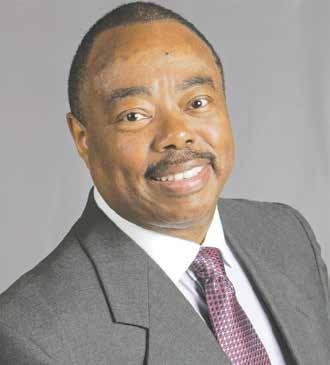
the conversation, you’re not on the path you thought you’d be on.
And here’s the biggest key that most good salespeople know. Listen, listen, listen. Here’s the other thing. Not only do you listen with your ears, you listen with your eyes. You observe what’s actually occurring.
What’s your advice for gathering that background information?
Unless you know who you’re trying to sell to, you should not be trying to sell. If you asked me to tell you something about my negotiation and body language background, I could give you a plethora of information and never even hit the target as to why you’re seeking insight from me. So, make sure you know what you’re answering, or what needs to be answered, any time you’re speaking with a prospective or current client. You can use questions to gather information and control the flow of a negotiation. “Why is that?” “How is that?” I’m gathering more information as I’m getting my questions answered, as opposed to just giving you verbal mirages of information without knowing to what degree they’re sticking to anything. Make sure you know how your questions are landing based on either their response or some other gestures that you might see at a particular point in time. And call your clients on exactly what they just displayed, so that you understand the meaning of that gesture.
Once you’ve done your research, how do you make first contact to break through to that client?
Let’s create a hypothetical situation. You know there’s a gatekeeper, because you’re going after a very high-level entity, and the gatekeeper really does control access to the person or entity with whom you want to engage. You find out what he or she may be interested in, and you literally reach out to that gatekeeper, per the way they like to be engaged. Let’s say, you find out the gatekeeper loves a particular type of bouquet of flowers. So, send a bouquet that says something along the lines of, “Hi, my name is Greg Williams. I’m known as the Master Negotiator and Body Language Expert. I just wanted to send you these flowers to let you know I’ll be following up with them. And I just wanted to wish you a nice day.” As simple as that. That’s step one. And then a few days later, or whatever timeframe is most appropriate, you follow up. “Hi. Just wanted to find out if you received the bouquet of flowers, and what you thought about them.” And when most people re -
ceive a gift, the law of reciprocity kicks in, and they want to do something to reciprocate. So, they respond, “Oh, I did receive the flowers.” Now what have you done with just that small gesture? You’ve made an impression. And if you’ve done your homework well enough, you’ve made a positive impression. And thus, you’ve positioned yourself as a value add. You can continue that string to the degree that it benefits you. And you can then ask to get in touch with whomever it is that the
ing from a visual perspective. And if you come back and say, “I hear what you’re saying,” you’re speaking auditorily, and you’ve slightly disconnected with that individual. And subliminally, it may or may not be as beneficial than if you had spoken from a visual perspective.
We talked before about mimicking a prospect. You can mimic someone in many different ways, in addition to just their body language and their verbalization. But you have to do it in a manner
Understand when a prospect just doesn’t need your services. We all know about the A, B, C list. The A prospects are the ones which become important, and you follow up with more regularly. The B prospects, you follow up with less. And the C prospects, you get to if you get to. Watch the gestures that are emitted by your prospects. To what degree do they welcome you into their environment, as opposed to even keeping you outside of the environment? Do they welcome you into their inner office, as opposed to the outer office? Those are little cues that can give you insight into how they feel about you and to what degree they may be willing, at some point, to do business with you.
gatekeeper is guarding the gate for and what might be the best possible avenue to do so. If you’ve built up enough goodwill with that individual, they’ll say, “Well, I’m the person that controls the schedule,” so forth and so on. The point is, do not pass someone that may be important in the process to assist you in making a sale by thinking, “Oh, that person is just a fill in the blank type of thing.” Turn that person into an ally of yours. And by turning that person into an ally, you also have an inside source, whereby that individual can help you progress your goals towards closing the sale.
So, once someone gets past the gatekeeper, how should they approach that first meeting?
Steve Jobs used to say, “We’ll tell people what they really need.” I initially thought that was somewhat arrogant, but there are things that people don’t realize can benefit their lives until you display them. You can display to someone how their operations will be enhanced, per what it is that you’re offering. You need to consider how to best position your information and present it in the form that they want to receive it. You’re in a situation where you’ve now gotten the meeting, and you’re going to go in and make a presentation. You need to understand if someone is more audio factored, visual, or if they’re kinesthetic. Again, you’ve gathered that in the form of information that you assembled before you went in to speak to that individual. You want to know at what pace they speak. You want to know what words they use. How they use different words. Those are the things that help build rapport. Someone who says, “That looks good to me” is speak-
that is not offending. And that’s yet something else you do in your presentation. I’ve had folks reach out to me to assess the body language of someone that was a top CEO, that was in the process of really taking his company public. They wanted to know to what degree that guy was even truthful based on how he presented on different TV networks, so forth and so on. That’s the degree that some people will go through to validate how to really position themselves in a particular situation. It all comes down to knowing as much about that prospect as you possibly can, mimicking that prospect to the degree that you can without offending, and offering the value proposition that you bring to the table to actually progress the sale. One step to the other.

Over 25 years ago, I was a salesperson, and I was really banging on the door of this one particular prospect. And he reluctantly said, “Okay, yes, you can come in and talk to me.” So, I came in and I started making my pitch. About three minutes into my presentation, his secretary knocked on the door and said, “We have an emergency. We need your attention right away.” And he said, “Greg, I’m sorry, we have to cut this off right now. But I do appreciate you coming in. Thank you.” I said, “Well, how about following up?” And he responded, “Okay, I’ll get back to you,” as he was pushing me out the door. Now, I was younger, and I didn’t truly understand what was occurring then. The point that I later reflected upon was, he got tired of me knocking on that door.
When a sale is going a bit rough, how does a salesperson ensure that they leave a positive impact and there is no acrimony from the prospect?
One of my largest clients happens to be in the pharmaceutical industry, and it’s one where their negotiators are negotiating on multimillion-dollar deals every day. When I initially met with their leader, he and I sat for 45 minutes without saying a word to one another. Later, both of us, understanding what was occurring, became good friends. Because he respected me, knowing that I knew what he was doing, as he knew what I was doing. So, that worked with that individual. With another, it may not have worked. He may have thought, “Well, isn’t this guy somewhat insolent. He’s just going to come in here and not say anything at all?” So, you need to know the mannerisms of the person with whom you’re speaking, and to what degree they will also value some type of relationship in the future.
“Not only do you listen with your ears, you listen with your eyes.”
Biden will be the oldest person to ever run for president. So, in two years, he’ll either be leader of the free world or a greeter at Walmart.
— Jimmy Fallon
Biden’s campaign slogan is “Finish the job.” Finish the job. Americans said they’d be happy if he could just finish a story.

– Ibid.
President Biden announced today that he will run for a second term and said, “Let’s finish the job.” Yeah, good idea. It would be nice to have a country where a guy could safely retire before he’s 86.
— Seth Meyers
I personally have a pretty good idea who is responsible, but that’s different from the level of proof that is needed to name somebody.
This weekend, we learned that Governor Abbott is once again deciding to play politics with people’s lives by resuming the busing of asylum seekers to New York, Los Angeles, Chicago, Denver, and Washington, D.C. Not only is this behavior morally bankrupt and devoid of any concern for the wellbeing of asylum seekers, but it is also impossible to ignore the fact that Abbott is now targeting five cities run by Black mayors.
– New York City Mayor Eric Adams
The ongoing border and humanitarian crisis that Texas and the entire United States are grappling with is a direct result of President Biden’s openborder policies. Under the previous administration, illegal immigration was at its lowest levels in decades. Now, President Biden is preparing to open the floodgates by ending Title 42 expulsions next week, and Texas is on the front lines of this catastrophe.
- Texas Gov. Gregg Abott (R) in a response letter to Chicago Mayor Lori Lightfoot who sent him a letter asking that he stop sending illegal immigrants to Chicago
If Chicago can’t deal with 8,000 in less than a year, how are small Texas border communities supposed to manage 13,000 in just one day?
- Ibid.
- Supreme Court Justice Samuel Alito telling the Wall Street Journal that he believes he knows who leaked the draft of the Supreme Court opinion overturning Roe v. Wade last year
It was a part of an effort to prevent the Dobbs draft … from becoming the decision of the court. And that’s how it was used for those six weeks by people on the outside — as part of the campaign to try to intimidate the court.
- Ibid.
It was rational for people to believe that they might be able to stop the decision in Dobbs by killing one of us.
- Ibid.

It was do or die. I know, of all people, that this can end very quickly. Who knows where it goes from here? Maybe I never get back up here, and that was it. That was going through my head the whole day, so it was kind of like, “You know what? I’m swinging. I’m going out hacking.”
- Drew Maggi, age 33, who played 1,155 games in the minor leagues over the course of 13 seasons before he was called up to the Major League this week, telling reporters what it felt like (He struck out and hit a double and was since sent back to the minors)
It gives you a balance. You run, you empty your head, you feel so much better afterwards.
- Barbara Humbert, who runs 30 miles a week and will soon run her 60th marathon, in a recent interview at her home in Paris
I think we need to be very cautious about anything that is anti-meritocratic and anything that results in the suppression of free speech. So, those are two of the aspects of the woke mind virus that I think are very dangerous, is that it’s often very anti-meritocratic, and you can’t question things. Even the questioning is bad.
- Elon Musk talking about the woke culture with HBO host Bill Maher
I was trying to figure out where it’s coming from. I think it’s actually been a long time brewing, in that it’s — I think it’s been going on for a while, and the amount of indoctrination that’s happening in schools and universities is I think far beyond what parents realize.
- Ibid.
They have the court, the attorney general, the heads of the economy, the American government — which works in cooperation with them on this issue, which is evident by the things government spokespeople say there.
– Israel’s Justice Minister Yariv Levin asserting that the U.S. administration has been cooperating with anti-judicial reform protesters
Last year, your favorite Fox News reporters were able to attend because they were fully vaccinated and boosted. This year, with that $787 million settlement, they’re here because they couldn’t say no to a free meal.


– Pres. Biden at the White House Correspondents Dinner
You might think I don’t like Rupert Murdoch. That’s simply not true. How can I dislike a guy who makes me look like Harry Styles?
- Ibid.
Don Lemon is out of a job. Don Lemon released a statement saying he got fired from CNN, then CNN released a statement saying that they offered Don a meeting. They had to part ways, ‘cause Don Lemon can’t even accurately report a story about Don Lemon.
We should be inspired by the events in France. They rioted when the retirement age went up two years to 64. They rioted because they didn’t want to work until 64! Meanwhile in America, we have an 80-year-old man begging us for four more years of work. Begging! Begging! “Let me finish the job!” That’s not a campaign slogan, that’s a plea!


- Ibid.
I support aid for Ukraine. I do not support what your country has done to Ukraine. I do not support your killing of the children either.


Before an assassin in 1935 ended his dreaming and scheming, Democrat Huey Long, Louisiana’s governor-turned-senator, articulated dissatisfaction with the two major parties. A demagogue of considerable intelligence and no scruples, he said of the nation’s binary choice:
“It puts me in mind of the patent-medicine man that used to come around our part of the country with two bottles of medicine. One he called High Popalorum. The other he called Low Popahirum. We asked him what was the difference, and he said the High Popalorum was made by taking the bark off a tree from the ground up, and the Low Popahirum by taking off the bark from the top down.”
Or as Alabama Gov. George Wallace said in his 1968 third-party presidential campaign, there isn’t “a dime’s worth of difference” between the parties. Today, some more-genteel people want to be poised in 2024 to break the two-party grip on presidential politics. Evidence of their gentility is that they aspire to be expendable: They hope their labors will be rendered unnecessary by one or both parties’ sparing voters in 2024 the unappetizing menu of 2020 reheated.
The No Labels group is spiritual kin to the late 19th century Mugwumps, who were mostly Republicans so appalled by their party’s seaminess they supported Democrat Grover Cleveland in 1884. No Labels people, who are refugees from both parties, share a Mugwumpean fastidiousness in rejecting both parties’ bad manners. Lacking, as yet, a policy agenda, No Labels’s principal regret, so far, is that poisonous tribalism prevents
bipartisan approaches to obvious crises, such as the unsustainable trajectories of Social Security and Medicare.
Until now, No Labels has specialized in didactic pronouncements: “five facts” about this and that (the debt ceiling, inflation, etc.). Now, however, the group wants to threaten serious disruption: It is working to secure places on states’ presidential ballots in case the major parties again provide a dismal choice. One palatable nominee would cause No Labels to cheerfully stand down.
No Labels’ December 2022 poll of 26,000 registered voters in 50 states showed a large majority wants more than a binary choice. That is, however, probably usually true midway between presidential elections. No Labels stresses Gallup’s February finding: 28 percent identify as Democrats, 27 percent as Republicans, 44 percent as independents. Granted, many professed independents are behaviorally Republicans or Democrats. Still:

If Democrats nominate the incum -
bent president, whom almost half of Democrats today wish were not running. And if Republicans nominate someone who was more disapproved than approved before, during and after his presidency. And if No Labels can get sufficient ballot access (it already has succeeded in four states – Alaska, Arizona, Colorado and Oregon – and hopes for 30 by year’s end) to have a plausible path to 270 electoral votes: 61 percent of voters who say they are “open to” voting for a “moderate independent” equates to 37 percent of the electorate. Then No Labels could provide a third choice. No Labels says its 2024 project is an “insurance policy” – “an infrastructure for an independent” – to protect the electorate from the failure of the political market to supply what there is a demand for: fresh presidential talent. Then 2024 might bring the most dramatically nonbinary election since the Democratic-Republican framing of presidential politics began in 1856.
In 1912, former president Theodore
Roosevelt’s third-party candidacy finished second by advocating progressive-cum-populist policies. In 1920, socialist Eugene Debs won about 3 percent of the popular vote by advocating government protections against industrialism’s vicissitudes. In 1948, Dixiecrat candidate Strom Thurmond, South Carolina’s governor, won 39 Deep South electoral votes opposing civil rights. Also in 1948, former vice president Henry Wallace ran feebly against Harry S. Truman’s confrontational policy toward the Soviet Union. In 1968, George Wallace won 46 Deep South electoral votes by reviving Thurmondism and anticipating Trumpism: Wallace faulted U.S. politics for “too much dignity.” In 1992, tycoon Ross Perot won 19 percent of the popular vote inveighing against free trade and budget deficits.
Five of those (all but George Wallace) had policy agendas. No Labels has an atmospheric aspiration (civility, temperateness, bipartisanship) but cannot have an agenda until it has a candidate. Then, he or she could fill a policy lane as broad as today’s space between progressivism that politicizes kindergarten and much else, and “conservatism” that politicizes beer (brawl-a-day Florida Gov. Ron DeSantis: “Why would you want to drink Bud Light?”) and much else.
One or both of the major parties might, depending on their calculations of a third candidate’s appeal, accuse No Labels of being a spoiler. Let those parties try to explain how today’s politics could be spoiled.

Reading about the massive dump of secrets in what has become known as the Discord leaks, people might reasonably ask: Why do these hemorrhages of classified information keep happening? How can a 21-year-old Air National Guard member have access to secrets for which he had no apparent need to know – and then, allegedly, toss them into a chatroom to impress his pals?

Most important, what can the Pentagon and the intelligence community do to maintain better control of classified information, without intruding on employees’ personal lives or blocking what the public truly should know?
I’ve been asking people in and out of government to unthread these questions. I hear growing support for the argument that classified systems should be built to assume the worst about their users, rather than the best. As we’re learning, any systems administrator could turn out to be the next Edward Snowden. Intelligence agencies need a “zero-trust architecture” that automatically enforces need-to-know permissions. This approach would be more efficient, and less bureaucratic and invasive, than some other draconian changes.
Robert M. Gates, who spent his career overseeing classified information as CIA director and defense secretary, sees two essentials going forward: “We need technology solutions that enforce the need to know, and systematic and rigorous enforcement of rules that already exist.”
This security mess has evolved with relentless, mind-boggling regularity, though the motivations have differed in each case: Army intelligence analyst Bradley Manning was convicted for turning over 1.6 gigabytes of data to WikiLeaks in 2010; former NSA contractor Snowden fled to Russia after scraping the code-breaking agency’s most secret programs and giving them to
the news media. Some of these leaks may have been beneficial to the public, but the system was at the mercy of its users.
Lesser-known cases have been just as serious: CIA officer Joshua Schulte was convicted in 2022 for leaking hacking tools of the agency’s Operations Support Branch in 2017 in a package known as Vault 7; the so-called Shadow Brokers, whose identities remain unknown, published highly sensitive NSA and CIA files in 2016 and 2017.
And now, Airman 1st Class Jack Teixeira, who allegedly used his access as a system administrator for intelligence programs at a base on Cape Cod, Mass., to disclose top secret “code word” intelligence reports about everything from Chinese satellite capabilities to Ukrainian ammunition supplies. He allegedly accessed the documents, printed many of them out, and then dumped photos of the reports onto the Discord server platform.
Why, in all these cases, did the systems for handling classified data break down? Certainly, too much information is classified, but that’s not really the problem here, many experts told me. Instead, it’s that existing rules aren’t enforced evenly, and they
depend too much on fallible human beings. Reforms meant to solve one problem often create new ones. Manning had access to a vast array of classified information in part because one lesson of 9/11 was that the CIA and FBI couldn’t read each other’s intelligence and thus failed to “connect the dots” about the plot. Stovepipes were bad; transparency was good. So analysts were given much wider access to secrets – and more opportunities to misuse that information.
James R. Clapper Jr., the former director of national intelligence who led the Pentagon’s post-Manning investigation, noted that new rules were established. But enforcement was uneven across the Defense Department, and control eroded over time because the restrictions were seen as onerous and inefficient.
“There needs to be a comprehensive system for monitoring electronic behavior” at work by people with high security clearances, Clapper said. The intelligence community shouldn’t routinely monitor its employees’ private communications, but it must learn to recognize “red flags” that may emerge with people who have been trusted with security clearances.
The system has missed the warnings. Manning was going through intense personal experiences in Iraq as the leaks began; Snowden moved from being an eager employee when he worked at the CIA to an angry dissenter when he became a contractor for NSA. Schulte was seen by his CIA colleagues as “vexing and obstreperous,” but he maintained access to secrets, according to a superb New Yorker profile by Patrick Radden Keefe.
The system needs accountability, but how should it be enforced? When Gates was defense secretary, he was famous for firing senior officials when there was a screw-up. But after the Manning leaks, Gates told me, Pentagon lawyers cautioned him that, before taking disciplinary steps, “you need to be mindful of the criminal proceedings that are underway.”
The Biden administration faces that same legal constraint in dealing with the Discord leaks. Senior intelligence officials are still struggling to understand just how the leaker got access to so much information. And they sensibly want to avoid overreacting.
The right answer is that accountability and controls should be engineered into the system. The tenets of such a zero-trust architecture are neatly summarized in a recent blog post from the defense software company Palantir: “Assume a hostile environment,” “presume breach,” “never trust, always verify,” “scrutinize explicitly,” and “every transaction should be logged for analysis and audit.”
Smart young engineers don’t want Big Brother looking over their shoulders into their personal data. It’s simpler, fairer, and less intrusive to have the rules and permissions built into the software used for handling classified information.

Why doesn’t South Korea have nuclear weapons? It certainly has all the predicates for building a bomb: It’s rich and technologically advanced, and it has a threatening nuclear neighbor in North Korea.
The answer is that for 70 years South Korea has trusted that the United States would guarantee its defense. That has proved a smart bet: Under America’s protection, Seoul has grown from crushing poverty to dazzling wealth as the 10th-largest economy in the world.
President Joe Biden will celebrate this astounding success story this week by welcoming South Korean President Yoon Suk Yeol for a state visit. The event will symbolize what’s great, and hopefully enduring, about this partnership.

But beneath the ceremonial bunting, you’ll see some stark questions about the future of American power in the Indo-Pacific region – starting with a need to refurbish the U.S. nuclear umbrella. To enhance South Korean confidence in “extended deterrence,” Biden will bolster America’s nuclear commitment to deploy weapons and consult about their use; Yoon, in response, is likely to reaffirm Seoul’s support for the nuclear Non-Proliferation Treaty.
The painful fact is that, to many in South Korea, the American security blanket feels a little threadbare these days. A poll last year by the Chicago Council on Global Affairs found that 71% of South Koreans wanted their country to develop its own nuclear arsenal. A survey in January by the South Korean newspaper Hankook Ilbo found that 67% support building a bomb.
Yoon himself seemed to express doubts earlier this year about America’s ability to deter North Korea, which U.S. analysts believe has 30 to 50 nuclear warheads. “It’s
possible that the problem gets worse, and our country will introduce tactical nuclear weapons or build them on our own,” Yoon said in January, adding (accurately) that Seoul could do so “pretty quickly, given our scientific and technological capabilities.”
Checking the nuclear ambitions of Asia’s “rising tigers” has been one of the small miracles of American diplomacy over the past few decades. U.S. officials estimate that as many as 10 Asian countries could quickly build nuclear weapons, including Japan, Taiwan, Singapore, Indonesia, and Malaysia, as well as South Korea.
South Korean and Taiwan did have active nuclear weapons programs, years ago. Seoul abandoned its program in 1975 and joined the Non-Proliferation Treaty. Taiwan was planning to have its own nuclear weapons by 1976, according to a 1972 U.S. intelligence estimate. Taipei dropped that program after Beijing and Washington opened relations that year, but it still has an active nuclear power program.
These Asian nations forswore nukes because they trusted in American power. But this confidence has been shaken in
recent years. One reason is the “America First” disdain for allies expressed by former President Donald Trump. Another is the reckless nuclear saber-rattling by North Korea, constantly, and Russia since its invasion of Ukraine. A third factor, in some ways the most worrying, is China’s race to build more nuclear weapons, with what U.S. officials say is a goal of 800 to 1,000 warheads over the next decade.
America’s nuclear umbrella may look less impermeable these days to our Asia friends. That’s why the Yoon visit will be important – in affirming that the United States will add more coverage and commitment to protect its allies.
There’s a strategic paradox in Asia that’s rarely noted: The biggest beneficiary of America’s extended deterrence policy (and its check on proliferation) might be China. Few things would be more destabilizing for China than a nuclear South Korea and Japan – and the cascade of other nations that would go nuclear in their wake. But China remains hunkered down in its own nuclear bunker, disdaining U.S. invitations to discuss strategic stability. No wonder Asia
mistrusts China’s intentions.
Yoon’s visit follows one in January by Japanese Prime Minister Fumio Kishida, the leader of America’s other key ally in northeast Asia. Yoon’s willingness to reach out to Japan, despite the political risks back home, helped bolster the trilateral U.S.-Japan-South Korea partnership that might be America’s biggest asset in Asia.
A cautionary note was shared with me by a longtime Korea-watcher. Even as Yoon moves toward Washington, his nemesis in Pyongyang draws ever closer to Moscow and Beijing. “We are doing Seoul no favor by nudging it along a path of open confrontation with Russia and China,” warned this Korea expert.
White House meetings with allies like Yoon might seem like the elevator music of foreign policy, predictable and preprogrammed. But these relationships are the essence of the West’s power. Contrast them with sharply declining approval of Russia’s global leadership, which according to a new Gallup poll has fallen 12 points to just 21% over the past year, less than one-third of the United States’. And compare our diplomatic position, too, with China’s – which just demolished its charm offensive in Europe by questioning the legitimacy of nations that were once part of the Soviet Union.
Seventy years ago, South Korea was in ruins, with “blasted and burned cities” and millions of Korean War victims, “homeless and jobless, living in squalor,” wrote T.R. Fehrenbach in his classic history of the conflict.
Today, South Korea is an economic and technology superpower. The challenge for the United States is how to extend the magnificent arc of that story far into the future.

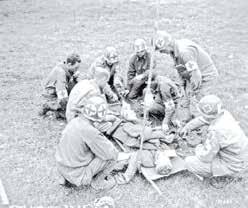 By Avi Heiligman
By Avi Heiligman
An estimated 550,000 Jewish servicemen and women served in the United States military during World War II. According to the National Jewish Welfare Board, 10.92% of all Jews who served in the U.S. Armed Forces during World War II were in the Medical Corps or on the front lines as combat medics. A wartime survey concluded that 40% of all Jewish doctors from the Bronx, Brooklyn, and twenty-two other communities with a sizable Jewish population went into the military. The stories that these men and women brought back show incredible feats of heroism, and many were decorated for their bravery. Looking through citations of World War II medical personnel, it is clear that more often than not, the medics and doctors had to work through the toughest conditions including withering enemy fire to help and save the lives of as many wounded servicemen as possible.
Captain Frederick Firestone from the Bronx was a battalion surgeon with the 411th Infantry Regiment, 103rd Infantry Division. The division had arrived at Marseilles, France, in October 1944 and entered combat a few weeks later. On November 29, neat Barr, France, Firestone was told that there was a seriously wounded soldier whose injuries were too grave for him to be evacuated from the field. Grabbing plasma, Firestone ran a hundred yards through murderous enemy fire to deliver the life-saving plasma to the soldier. Later that same day, a wounded tank commander lay in the streets, and attempts to reach and pull him to safety had failed. Firestone then ran in and out of houses until he reached the house across from the wounded tanker. He then crawled into the danger zone and retrieved the wounded officer. After dragging him
into a building that was shielded from enemy fire, Firestone administered life-saving first aid.
A few months later, on March 21, 1945, the 411th Regiment was fighting in Germany. The company that Firestone
Firestone administered the plasma, gave them medical aid, and arranged for their successful evacuation. For his courageous actions in very hazardous conditions, the Jewish captain was twice awarded the Silver Star.
came that several wounded men were stranded in a house. Zemel and the rest of his squad had to wade through a river and brave enemy machine gun and artillery fire to reach the location and treat the wounded soldiers. Zemel then led his men back to the river and carried the litter of a wounded soldier on his soldiers while wading neck-deep through the river. They safely reached the aid station, and Zemel was later awarded the Silver Star for his actions in saving the soldier’s life.
Not all Jewish servicemembers were born in the U.S. One medic serving in the Pacific Theater of Operations had to endure Nazi horrors before immigrating to America and joining the Army’s medical department. Leo Rosskamm was born in Germany and spent six months in Buchenwald where his parents and siblings were brutally murdered by the Nazis. During his time in the concentration camp, an elderly prisoner collapsed in his arms before a Nazi beat him with his rifle. Rosskamm’s shoulder was badly broken in the ruthless attack. In April 1939, he somehow received documents to go to the U.S. and was released from Buchenwald.
was with was forced to withdraw due to heavy gunfire. However, the captain realized that there were two American soldiers within thirty yards of the German machine gun position who were too severely injured to move. Firestone then led a litter team crawling through 300 yards of enemy machine gun fire. Upon reaching the wounded soldiers,

There were other Jewish medical personnel serving with the 103 rd Division in their drive through France and Germany. Private First Class Hyman Zemel from Baltimore was attached to Company A, 328 th Medical Battalion, 103rd Infantry Division. There were on the outskirts of Selestat, France, on the night of December 2, 1944 when word
Rosskamm settled in the Bronx and in January 1941 joined the army despite his concerns about his surgically repaired shoulder. A year later, he was shipped overseas, and in April 1945 he landed on Okinawa with the 10th Army. Now a technician fifth grade, Rosskamm was a medic with a company on April 19 that was fired upon by a Japanese machine gun. One of the men was hit, but it was seemingly impossible to reach the wounded soldier. Gunfire was coming from a cave dug out from a ridge, but Rosskamm crawled towards the position. When the enemy gunfire got too intense, the medic called for a
A wartime survey concluded that 40% of all Jewish doctors from the Bronx, Brooklyn, and twenty-two other communities with a sizable Jewish population went into the military.






flamethrower to be used on the enemy’s location. Rosskamm was finally able to reach the soldier and evacuate him to the rear.
The next day, April 20, another soldier lay wounded in an open area that the Japanese were monitoring. Rosskamm worked his way towards the wounded sergeant. When he reached him, Rosskamm shielded the man from enemy fire with his body while administering aid. The man was successfully evacuated, and Rosskamm went back to his position. That night, Japanese soldiers made their way into the American lines and wounded several American
soldiers. Without hesitation, the medic left the relative safety of his foxhole to render aid. Two Japanese soldiers came at him with weapons at the ready. Rosskamm grabbed a rifle from an American soldier, killed both enemy soldiers, and returned to helping the wounded Americans.

A nearby unit was attacked on April 28, and since they had no medic available, Rosskamm jumped into action. Under intense mortar and machine gun fire, he began to administer aid. While evacuating one soldier, the medic was knocked down by a bullet hitting his helmet. Despite the dangers, Rosskamm
continued his life-saving work and returned to the battlefield of the wounded soldiers. He was hit again while helping another American. This time, the bullet hit his neck, and Rosskamm only paused to dress his own wound before helping others. Refusing evacuation, he continued to administer aid to soldiers he said were in more dire need than him. An officer finally ordered him to the rear, and he reluctantly left to get aid for himself.
For his heroic actions, Leo Rosskamm was awarded the Distinguished Service Cross – second only to the Medal of Honor – and his commanding offi-
cer called “the bravest man I ever met.” There are many stories told of the bravery and heroics of the medics and doctors serving on the frontlines. Often disregarding their own safety, they went through enemy gunfire, extreme weather conditions, and hazardous terrain to save the lives of fellow servicemembers.
Avi Heiligman is a weekly contributor to The Jewish Home. He welcomes your comments and suggestions for future columns and can be reached at aviheiligman@gmail.com.


PEACEFUL PRESENCE STUDIO
Men’s private yoga, Licensed Massage & Holistic Health Guidance
436 Central Ave, Cedarhurst
Info. & free video training www.peacefulpresence.com
516-371-3715
GERBER MOVING FULL SERVICE MOVING
Packing Moving Supplies
Local Long Distance Licensed Insured
1000’S Of Happy Customers
Call Shalom 347-276-7422
HANDYMAN AVAILABLE
For big or small jobs, Sheetrock, carpentry, painting, electrical, plumbing, install & repair appliances
Call Ephraim at 347-593-4691
VACUUM SALES AND REPAIR
All areas call Max Flam 718-444-4904
MANAGEMENT STAFF WILL ASSIST
you with:
* Obtaining Medicaid and Pooled Income Trust
* In-home Assessments, Individual and Family Counseling
* Securing reliable home care assistance
* Case and Care Management services
Dr. S. Sasson, DSW, LCSW
(718) 544- 0870 or (646) 284-6242
HAIR COURSE:
Learn how to wash & style hair & wigs. Hair and wig cutting, wedding styling Private lessons or in a group
Call Chaya 718-715-9009
ZEVIZZ WOODTURNING JUDAICA
Challah knifes, batei mezuzah, besamim holder, kiddish cups, havdalah candle holders, yad for sefer torah, pens, stenders, bowls and more 952-356-2228
LOOKING FOR PRIVATE PAY CLIENTS NPhomecare Service
Food prep meals, light house cleaning and laundry. Grocery shopping. Hospital visit. Be Padiatist. Physical Therapist. Educational therapist
Maintains your Independence in the comfort of your own home
Tel: 718 912 6425
Tel: 917 972 1428
Email: npersaud2022@gmail.com
LAWRENCE
Stunning One of a Kind Mid Century Modern 6 Bedroom, 6.5 Bath, Contemporary Ranch. Resort Style Home on Over an Acre of Property in Back Lawrence. Incredible Views, Regulation Size Tennis Court - Deco Turf. IG-Gunite Pool, Low Taxes, 5318 sq. ft. of Main Floor Living Space. Plus 5000 sq. ft. Basement With Very High Ceilings. Call Mark 516-298-8457 for more details Mark Lipner Associate Broker Berkshire Hathaway Laffey International 516-298-8457 mlipner@ bhhslaffey.com

DON’T GET STUCK WITH A TWO STORY HOUSE YA KNOW, IT’S ONE STORY BEFORE YOU BUY IT BUT A SECOND STORY AFTER YOU OWN IT!
Call Dov Herman
For An Accurate Unbiased Home Inspection
Infrared - Termite Inspection
Full Report All Included NYC 718-INSPECT
Long Island 516-INSPECT www.nyinspect.com
HEWLETT
Luxurious Exquisite 6 bedrooms, 6.5 bath home situated on approximate 1.8 acre property in prestigious Hewlett Bay Park. Formal Living room and dining room, library, chefs Eat-in Kitchen, extraordinary great room leads out to veranda. large Gunite built-in pool + pool house with full bath, large slate patio, impressive sprawling property, school district #14 Hewlett-Woodmere. Close to all. P.O.R. Mark Lipner Associate Broker Berkshire Hathaway Laffey International 516-298-8457 mlipner@bhhslaffey.com
CAN’T AFFORD YOUR PROPERTY TAXES? MORTGAGE?
Must sell for any reason? Call for FREE Consultation. Call now 212-470-3856 Cash buyers available!
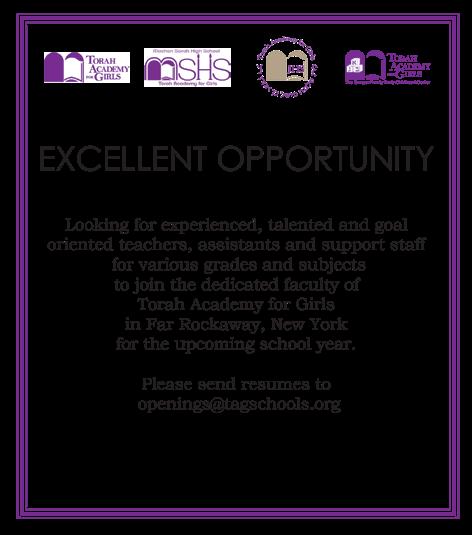
NORTH WOODMERE JUST LISTED
Move Right into this Beautifully Maintained and Updated Three Bedroom, 2.5 Baths Large Split Situated on an Oversized Park-like Lot Overlooking the Pond. Home Features naturally bright lit rooms with a Ground Level Den Leading to Patio, With Another Lower Level With Partially Finished Basement. Hardwood Floors Throughout Updated Kitchen With Granite Counters in School District 14 and Close to all Houses of Worship. $939k Mark Lipner Associate Broker
Berkshire Hathaway Laffey
International 516-298-8457 mlipner@bhhslaffey.com
HEWLETT BAY PARK
Six bedroom home in highly desirable Hewlett Bay Park on 3/4 of an acre with an inground gunite pool and tennis court, en-Suite bathrooms and bedrooms on both floors, 1st floor Master Suite with steam shower and Jacuzzi tub, Eat-in Kitchen, with SS appliances, 2 sinks, 2 dishwashers, double oven, formal living room, formal dining room, den with fireplace. Close to railroad, shopping, and houses of worship. SD#14. Great house for entertaining. Park-like Property. P.O.R. Mark Lipner Associate Broker
Berkshire Hathaway Laffey International 516-298-8457 mlipner@bhhslaffey.com
WOODMERE
New to the market. 3 bedroom 2 full bathrooms with a full basement. Ranch home in the heart of Woodmere, SD#15, on a lot sized 90x118, gas heat, garage. Open house
Sunday, May 7 • 11:00-1:00PM
401 Howard Avenue Mark Lipner
Associate Broker Berkshire Hathaway Laffey International 516-298-8457
mlipner@bhhslaffey.com
CEDARHURST JUST LISTED
Magnificent renovated 4 bedroom 3 bathroom in SD#15, new roof, windows, plumbing + electric, gas cooking, new marble bathrooms, marble kitchen with stainless steel appliances, LED lighting, security cameras and speakers throughout the home, custom closets, outdoor patio, 1 car garage, near all. Open House Sunday May 7 • 12:00-2:00PM •
331 PENINSULA BLVD. Mark Lipner Associate Broker Berkshire Hathaway Laffey International 516-298-8457 mlipner@bhhslaffey.com
WOODMERE
Well maintained 4 bedroom home on a cul-de-sac in Old Woodmere SD#14. Features central air conditioning, gas heat, eat -in -kitchen with stainless steel appliances, very spacious den, 2 car garage, hardwood floors, high hats, magnificent yard with an inground saltwater pool, close to the railroad, shopping and houses of worship. Call for a private showing.
Mark Lipner Associate Broker Berkshire Hathaway Laffey International 516-298-8457 mlipner@bhhslaffey.com
WOODMERE
Charming Colonial on beautiful tree lined street in the heart of Old Woodmere. Home features 3 bedrooms, 1.5 baths, kitchen, dining area, living room, full basement. Relatively new heating system + hot water tank. Large & beautiful backyard. Great for entertaining. Close to all. Mark Lipner Associate Broker Berkshire Hathaway Laffey International 516-298-8457 mlipner@ bhhslaffey.com
Woodmere Renovated 8 Bedroom
Colonial, Prime Location in SD#14Old Woodmere. Smart Home, Camera System, New CAC System, A Large Eat-in Kitchen with Pantry. Finished Basement. NEAR ALL OPEN HOUSE SUNDAY MAY 7 3:00-4:30PM 30
JOHNSON PL Mark Lipner Associate Broker Berkshire Hathaway Laffey International 516-298-8457 mlipner@ bhhslaffey.com
WOODMERE
Spectacular 5 bedroom, 5 bath renovated home in SD#14 with in-ground pool & pool house, lot size 111 x 107. Formal living room & dining room, magnificent kitchen with SS appliances, tremendous den with fireplace and 4 skylights, vaulted ceiling, LED lighting, master suite, new CAC, new roof. Outside totally redone with Stone and Stucco. Backyard with new pavers, park-like property, sandbox, great home for entertaining. Close to all.
OPEN HOUSE MAY 7 • 1:30-3:00PM
562 SUNSET DR Mark Lipner
Associate Broker Berkshire Hathaway Laffey International 516-298-8457 mlipner@bhhslaffey.com
CEDARHURST
New to the market: Move right into this magnificent home with a state of the art kitchen with 2 sinks, 2 dishwashers, 2 microwaves, double oven, stainless steel appliances, large island radiant heat, master bedroom suite on the 1st floor with 2 additional bedrooms and bathroom, main floor family room, upstairs has an additional 2 bedrooms and a full bathroom, parl-like property close to all.
OPEN HOUSE
SUNDAY, MAY 7 – 1:30 – 3:30PM
480 ARLINGTON RD Mark Lipner
Associate Broker Berkshire Hathaway Laffey International 516-2988457 mlipner@bhhslaffey.com
Long Beach is a very warm community with an out-of-town feel only 20 minutes from the Five Towns. We offer a choice of shuls as well as kosher food options all within an easy walk to the ocean, boardwalk and beach.
This beautiful Tudor offers 3 Bedrooms, 2 full & 2 half baths. It is a very well maintained 2600 square foot home in the Westholme area. Easily walkable to shuls, beach & the train. There is a Giant Primary bedroom with walk-in closet & en-suite, a finished basement and lots of original details. ASKING $990,000

classifieds@fivetownsjewishhome.com




In the heart of Cedarhurst (Close to Woodmere , Lirr & Cedarhurst Park)

EIK Kosher Kitchen/ Dr/Lr/Family Room/ Playroom/ 4 Bedrooms, 3 Full Baths/ Basement: 2 Bedrooms, 1 Full Bath, Kitchenette, Separate Entrance
Asking $1.3m Whatsapp Text Only: 845-213-0002
No Brokers
Move right in. 4 bedrooms, 4 bathrooms split level. Features eat-in-kitchen with stainless steel appliances, granite countertops, formal living room and dining room, main floor family room with fireplace, 2 master bedrooms with full bathrooms, central a/c, gas, heat, hardwood floors, recessed lighting, cedar closet, sauna, generator and much more. $1,115,000.
Mark Lipner Associate Broker Berkshire Hathaway Laffey International 516-298-8457 mlipner@bhhslaffey.com
Prestigious Center-Hall Colonial in Hewlett Bay Park, Set Back on Private Property. This Stately Home Features a Grand Entry Foyer, Formal Living Room, Formal Dining Room, Chef’s Kitchen, Large Den, Master Bedroom suite with Sitting Room + 2 Baths (His & Hers) and Loft and Additional 3 Bedrooms + Bonus Rooms. Exquisitely Manicured Park-like property. Award Winning School District #14. Too Many Features To List. Will Not Last!
P.O.R. Mark Lipner Associate Broker Berkshire Hathaway Laffey International 516-298-8457 mlipner@bhhslaffey.com
WOODMERE
Beautiful, brick, colonial boasting 5 bdr 3.5 Bth in pristine condition. Excellent location, near all! Move right in! RCUSA 516-512-9626


RAMAT GAN, ISRAEL
Furnished 1br deeded 52 sqm holiday apartment at Kfar Maccabiah Hotel. 20 mins to central TLV, 24/7 Front desk, 3 pools, full gym, parking. 6 months annual usage. Priced to sell at NIS 950,000. Contact Carol at 646-6454935 or carolinalevine@gmail.com
LAWRENCE
New to the market Jr. 4 apartment in an elevator building with a terrace and underground parking, laundry on premises. Kitchen with granite countertops, 2 sinks, ss appliances, spacious step down living room with high ceilings, guest room/ office, spacious primary bedroom with 3 closets, full bathroom with full vanity, medicine cabinet, toilet and lighting, custom blinds, near the railroad, shopping and houses of worship.$289K Mark Lipner Associate Broker Berkshire Hathaway Laffey International 516-298-8457 mlipner@ bhhslaffey.com
Magnificent 2K Sq. Ft. Co-Op. 3Br/2Bth, Eik, Lr, Dr, W/D In Unit, Gar, 2 Stor Units, Elev, Near All $775K 516-846-1032 No Brokers
CEDARHURST MOVE RIGHT IN. Totally Updated One Bedroom Townhouse Apartment on the First Floor. Featuring 1.5 Bathrooms, Central Air Conditioning, Washer/ Dryer in the Unit, Kitchen With SS Appliances, Hardwood Floors, and Recessed Lighting. Freshly Painted. Super on Premises. Underground Parking is $95/month. This spacious rental is managed by a responsible landlord. Great Courtyard. Close to the Railroad, Shopping, Restaurants, Post Office, Cedarhurst Park + Houses of Worship. NO BROKERS FEE Mark Lipner Associate Broker Berkshire Hathaway Laffey International 516-298-8457
mlipner@bhhslaffey.com
LAWRENCE
Spacious 2BR, 2 Full Bath Apt with an enclosed terrace in the heart of Lawrence. Well maintained & manicured building. New hardwood floors, updated Eat-in Kitchen with gas stove. warming draw, dishwasher & microwave. New windows on the enclosed terrace & one of the bedrooms. 3 New A/C Units & New Refrigerator. Close to shopping, transportation, library, schools, and houses of worship. $339K 284 CENTRAL AVE B-5 Mark Lipner Associate Broker Berkshire Hathaway Laffey International 516-2988457 mlipner@bhhslaffey.com
CEDARHURST
Move Right In. Totally updated 2BR, 2 Bath, Apt. on the 1st Floor. Private Entrance, CAC, W/D in Unit, Kitchen with SS Appliances, Hardwood Floors, Recessed Lighting, Freshly Painted, Great Courtyard, Parking $95/Mo. Close to Railroad, Shopping, Restaurants, Cedarhurst Park + Houses of Worship NO BROKERS FEE Mark Lipner Associate Broker Berkshire Hathaway Laffey International 516-298-8457 mlipner@bhhslaffey.com
LAWRENCE
One Bedroom Renovated Apartment In Prime Lawrence. Efficiency Kitchen, Renovated Bathroom. Sunken LR, Dining Room, Close to All, Transportation, Shopping, Worship. $275k Mark Lipner Associate Broker Berkshire Hathaway Laffey International 516-298-8457 mlipner@ bhhslaffey.com
3 bedroom 2 bath co-op with central air conditioning, terrace, washer dryer, hardwood floors, recessed lighting, magnificent kitchens, ss appliances, l/r, d/r, close to the railroad, shopping, and houses of worship. $319k

1201 EAST BROADWAY H-23 Mark Lipner Associate Broker Berkshire Hathaway Laffey International 516-298-8457 mlipner@bhhslaffey.com

classifieds@fivetownsjewishhome.com • text 443-929-4003
LAWRENCE
Spacious 2BR, 2 Full Bath Apt with an enclosed terrace in the heart of Lawrence. Well maintained & manicured building. New hardwood floors, updated Eat-in Kitchen with gas stove. warming draw, dishwasher & microwave. New windows on the enclosed terrace & one of the bedrooms. 3 New A/C Units & New Refrigerator. Close to shopping, transportation, library, schools, and houses of worship. $339K Mark Lipner
Associate Broker Berkshire Hathaway Laffey International 516-298-8457 mlipner@bhhslaffey.com
HEWLETT
Totally renovated 1 and 2 Bedroom, Apartments with washer/dryer, kitchen with quartz countertops, stainless steel appliances. Recessed lighting, hardwood floors, storage in basement. Close to RR, shopping, and houses of worship. Mark Lipner
Associate Broker Berkshire Hathaway Laffey International 516-298-8457 mlipner@bhhslaffey.com
LAWRENCE JUST LISTED
This amazing two-bedroom two full bathroom condo Features a luxurious lifestyle in the beautiful city of Lawrence. What more could you ask for? The building has a 24-hour doorman and elevator access, with a social room, library, washer/dryer inside the unit, and terrace. Plus, the added benefit of having a live-in super to ensure maximum safety and security! And don’t forget about your new kitchen complete with a gas stove, refrigerator, microwave, and even two dishwashers! The living room and dining room are spacious and have recessed lighting installed throughout. Both bedrooms feature lots of closet space for storage. To top it off, there’s even garage parking available to make your life just that much easier! Don’t miss out on this incredible opportunity. Please call for a private showing Mark Lipner Associate Broker Berkshire Hathaway Laffey International 516-2988457 mlipner@bhhslaffey.com
CEDARHURST
1, 2 and 3 bedroom apartments, totally renovated private entrance , central air conditioning, hardwood floors, washer/dryer, garage parking, dishwasher, recessed lighting, private playground, close to railroad, park, shopping and houses of worship. Call for more details
Mark Lipner Associate Broker Berkshire Hathaway Laffey International 516-298-8457 mlipner@bhhslaffey.com
WOODMERE
Totally renovated bright and sunny 1 bedroom corner unit apartment with a washer/dryer. Features quartz countertops, ss appliances, recessed lighting, bathroom with chrome fixtures, close to the railroads, shopping and houses of worship. Call for details Mark Lipner Associate Broker Berkshire Hathaway Laffey International 516-298-8457 mlipner@bhhslaffey.com
WOODMERE
Move right in!! 2 Bedroom Apartment, Elevator Bldg in SD #14, Pre War Bldg, Pet Friendly, Laundry Room in Basement, Wood Floors, New Windows, Corner Apartment, Beautiful Renovated Kitchen w/SS Appliances, 3 A/C Units, Close to RR, Shopping & Houses of Worship. A must-see! $199k Mark Lipner
Associate Broker Berkshire Hathaway Laffey International 516-298-8457 mlipner@bhhslaffey.com
HEWLETT
Spacious and Sundrenched 1st Floor 2 Bedroom, 2 Full Bath Unit In The Incredibly Maintained Garden Town. Updated kitchen with Granite Countertops and Gleaming Hardwood Floors Throughout With A Private Washer/Dryer. Best Views from Every Window And The Large Terrace Facing The Beautifully Landscaped Courtyard. Indoor Parking Available As Well And An I Adjacent Municipal Lot. Convenient To The LIRR, Shops & Restaurants. Maintenance includes all your taxes, heat and water. No more shoveling or gardening for you reduced to $185k Mark Lipner
Associate Broker Berkshire Hathaway Laffey International 516-2988457 mlipner@bhhslaffey.com
5TOWNS FOR LEASE: OFFICE + STORAGE + PARKING LOT
Bayview and Lawrence. Minyan
Available immediately
Call/Text/WA Owner: 516-206-1100
FAR ROCKAWAY
2 BDRM apt. Bright 2-bedroom apartment; 2nd floor-Eat-in kitchen; washer/dryer hook-up Private entrance; On Sage Street, parking available-Near main Shuls & LIRR $2100/month includes heat & water. For more information call (718)327-4386.
PRESCHOOL TEACHERS AND ASSISTANTS needed for 2023-2024 school year!
JELC Preschool of Merrick is opening more classrooms and seeks highly motivated, creative, and loving teachers & assistant teachers for the upcoming 2023-2024 SCHOOL YEAR. Infant, toddler, nursery and pre-k positions available! Competitive salary and warm working environment. For more info, call Gayle at: 516-833-3057 ext 110 or e-mail resume to admissions@jewishelc.org or WhatsApp 516-236-2239
Part-time position available at Cedarhurst must have computer knowledge Will train contact: sheva.muller@gmail.com or text 516-314-4810

JOIN OUR TEAM!
ABA company located in the 5 Towns looking to fill multiple full-time administrative positions Knowledge of Central Reach a plus, but will train the right candidate Great work environment Call 516-670-5374 or Email your resume to: Careers@supportivecareaba.com
LARGE NOT FOR PROFIT
Organization Looking for Controller
Manage the monthly financial close, including reconciliations of revenue and expense accounts, investment activities, fixed assets, accruals, ongoing variance, payroll, and benefits analysis. Manage and comply with all local, state, and federal government accounting and reporting requirements. Salary range $120k-$160k Respond to Jobs@hcsny.org
SEEKING ELA TEACHER
Immediate opening. ELA teaching position for Gr. 5. Mon.-Thurs., afternoon hours. Far Rockaway/5T area. Competitive salary, warm, supportive environment. All teaching materials provided. Teachersearch11@gmail.com.
NECHAMA IS A HIGH FUNCTIONING
24 Year Old Female that lives in Far Rockaway near Dinsmore Ave, who has experience working with children, is looking for a frum young mother, who lives in Far Rockaway area to provide Com Hab and/or Respite Services for her, in order for this individual to learn how to manage a household i.e., learning cooking skills, organizational skills etc… This individual is available from 4:30 pm to 6:30 pm Monday through Thursday, including Sundays. Jobs@hcsny.org
REBBEIM TEACHERS & ASSISTANTS
CAHAL is hiring Special Ed Rebbeim, Teachers and Assistant Teachers for 2023-24 school year. AM or PM, FT or PT. E-mail resume to shira@cahal.org or call 516-295-3666 for information.
DELIVERY PERSON NEEDED to deliver Newspaper every Thursday morning to locations in Brooklyn. Must have Minivan or SUV and availability to work consistently every week! Please email gabe@fivetownsjewishhome.com or call (917) 299-8082
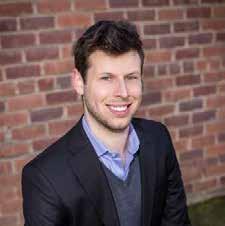
A YESHIVA IN QUEENS is looking for an experienced part/ full time secretary, 2-year-old morah, kindergarten morah, kindergarten morah assistant and Pre-1A English teacher for the 2022-2023 school year. Nice and timely pay. Please email resume to mshelt613@gmail.com or call/text 718-971-9799.
LOOKING FOR A DRIVER
Business looking for someone that has a large van or sprinter that can work a full day on Wednesdays on a weekly basis throughout the year in Brooklyn. Please do not call if you do not have a large van or a sprinter 347.992.7411
MDS REGIONAL NURSE:
5 Towns area Nursing Home management office seeking a Regional/Corporate level MDS Nurse to work in our office. Must be an RN. Regional experience preferred. 2-3 years MDS experience with good computer skills required. Position is Full Time but Part Time can be considered. Great Shomer Shabbos environment with some remote options as well. Email: officejob2019@gmail.com
DEVELOPMENT ASSISTANT
A multi-tasker needed for general office work. The ideal candidate is someone who is detail-oriented, responsible, and can take ownership. Looking for someone who is eager to learn, and expand his/her skill set while possessing the ability to work independently and as part of a team. Experience with Excel required. Five Towns location. In-office position only, not remote. Please send resume to 5tpart.timecareer@gmail.com
5 TOWNS BOYS YESHIVA
Seeking Elem Gen Ed Teachers
Excellent working environment and pay. Only lic/exp need apply. Email resume to yeshivalooking@gmail.com
IMMEDIATE OPENING
ELA teaching position for Gr. 5. Mon.-Thurs., afternoon hours. Far Rockaway/5T area. Competitive salary, warm supportive environment. Teachersearch11@gmail.com
BOOKKEEPER
Excellent growth potential, Frum environment, Excellent salary & benefits. Email resume to: resumetfs1@gmail.com
GEMACH ZICHRON TOVA
Loans up to $5000 head checks and 2 co signers required. Call 7186146789 or 7186143271


Summer is coming, and for music fans across America that means stadium tours. Swifties went through several bear attacks to get tickets to her Eras tour shows. And on May 10, a singer we’ll call B hits the road for 41 stadiums in ten countries. The summer renaissance is her first tour in seven years, and you can expect her fans to party all night.
B and husband are already two of the most successful artists of any era. This time, she’s taking a lesson from the airlines by using so-called “dynamic pricing” to squeeze every dime she can out of fans. Billboard estimates she could gross as much as $300 million this go-round, and that’s before millions more in merchandise. It used to be that musicians toured to support album sales. But now, with Spotify paying an average of 4/10 of a penny for each stream, the top acts practically give away the music to support the tours.
Naturally, the fans at the IRS are happy to share in this diva’s success. They don’t even have to sing backup to collect millions! But they want to be sure she’s paying everything she owes. So, the IRS audited B for 2018 and 2019. They disagreed with a whole grab bag of items on
her return: legal and professional fees, a charitable contribution carryover, and what appear to be some real estate operating expenses. They sent a Notice of

by wasting 3$ million. And so, on April 17 —coincidentally, the day before the filing deadline for this year’s return—she petitioned the Tax Court to say “sorry”
letproof windows looking out over the LA basin. (Jealous?) Oh, and it has not one, not two, not three, but four swimming pools. (Three isn’t enough? Maybe the fourth is for the help?) Property taxes are $1.06 million per year. Unbelievably, according to the LA Times, there are seven houses in the city with even higher taxes. And the city just passed a new mansion tax, which took effect this month, imposing a 5.5% tax on any sales above $10 million.
Deficiency for $805,850 (plus $161,170 in interest) for 2018 and $1,447,747 (plus $288,549 in interest) for 2019.
In 2014, Billboard named B the highest-earning Black musician of all time. She’s worth 500 $ million all by herself. (The filing reveals that she files separately from her husband, like all the single ladies.) She could probably cover that 3$ million just by scrounging through her couch cushions and the plastic on her sofa. But you don’t get to be worth 500$ million in the first place
to the IRS and determine there were no deficiencies in her 1040.
B’s petition doesn’t reveal how much she already sent to the IRS. We can assume it would be enough to break most peoples’ souls.
This isn’t the first time she’s had to blow millions on taxes, either. In 2017, she and her husband moved into an $88 million mansion in Bel Air. The cozy 30,000 square foot crib came complete with eight bedrooms, 11 baths, a 15-car garage, an irreplaceable lizard-skin door, and bul-
Most tax court cases settle before trial. If B doesn’t reach an agreement in hers, it’ll probably take a year or two before we learn if she’s a broken-hearted girl. But you don’t have to win 32 Grammys to put smart planning to work, and you don’t have to be a diva to pay less. So don’t hurt yourself sending the IRS more than you have to. Call us—tax planning is our superpower!
She could probably cover that $3 million just by scrounging through her couch cushions and the plastic on her sofa.

There are headaches, and then there are headaches. And I don’t use the term lightly.
Sometimes, it means an unwelcome stress in your life. Something you definitely want to get rid of. You call it a real headache! Absolutely painful. And not necessarily simple to resolve. But, thankfully not physically connected to you.
Then there’s the slight to throbbing ones. The ones that are certainly located inside your head. Yet, usually anything from a Tylenol to four Advils does the trick to send them packing.
But, then there’s the nightmarish one. The one that can show up anywhere in your body. The one that sneaks behind your eyes, or makes you nauseous, or just pounds the power out of you.
This is the one it’s tough to escape.
Unless, of course, you’re one of those people who gets some kind of warning. Then you can, literally, stab yourself with a needle and happily push off the capture of your body.
If you miss that moment…you’re a hostage. Relegated to a totally dark room, without a single sound, and stuck in a supine position, until it finally de -
cides to go back to where it came from.
That selfish little culprit has a way of tiptoeing into your life without making a sound that’s noticeable in the outside world.
No one around you is given the opportunity to warn you that it’s on the warpath. It leaves everyone defenseless. No one can get their shield and armor out and be your protecting hero.
And then, is it kind enough to continue on the path it began, remaining as quiet as it was when it snuck in?
Oh now! Upon entering your brain, it comes crashing in with a drum roll, complete with cymbals. Then it continues its symphony, albeit a private one solely dedicated to your head, till it’s good and ready to depart.
This headache named itself a mi -
erate nuisance.
Here today, not necessarily even gone tomorrow.
It invites itself in but couldn’t care less when you’d like it to move out. It has no lease agreement, pays no rental fee, just comes as a total squatter.
I guess we’d prefer it stayed home -
less. But how we feel about it doesn’t matter to it.
Bottom line is that it’s an all-out attack of body and mind because having a migraine headache is a total headache.

Wishing all those who unfortunately get them a quick recovery and the discovery of a total cure soon.
graine. Because it’s yours alone – “my grain,” my seed to grow. Except your preference was never to nurture it at all!
“My pain” would be a much more appropriate name for it.
But just the way it never asks you if you want it at all, it didn’t ask you what you want to call it.
It’s a selfish, self-centered, inconsid-
It has no lease agreement, pays no rental fee, just comes as a total squatter.Rivki Rosenwald is a Licensed Marriage & Family Therapist working with both couples and individuals and is a certified relationship counselor. Rivki is a co-founder and creator of an effective Parent Management of Adolescent Years Program. She can be contacted at 917-705-2004 or at rivkirosenwald@gmail.com.
